What Is GA4?
Google Analytics 4 (GA4) is a free instrument for monitoring visits to web sites and apps. And the interactions that occur on these.
The instrument supplies insights into visitors numbers, consumer demographics, most-visited pages, and extra.
Google is the developer of GA4—and its predecessor, Common Analytics (UA).
On this information, we’ll discover how GA4 differs from UA and the best way to arrange GA4.
And the best way to use it to trace your web site’s efficiency.
How GA4 Monitoring Differs from UA
UA is the earlier model of Google Analytics earlier than Google launched GA4 in October 2020.
GA4 differs from UA in methods like:
- Terminology for consumer interactions: UA calls consumer interactions “hits.” With completely different hit sorts for web page views, occasions, and different interactions. In distinction, GA4 calls all consumer interactions “occasions.”
- Modifications to the Google Analytics account construction: UA accounts may comprise a number of properties. Which may, in flip, comprise a number of views for creating filtered knowledge segments. GA4 accounts can nonetheless comprise a number of properties, however they can’t comprise views. And in contrast to UA properties, GA4 properties can obtain a number of knowledge streams from web sites and apps. As a substitute of monitoring knowledge from just one supply.
Customary UA accounts stopped processing knowledge on July 1, 2023. So, if you wish to monitor your web site efficiency utilizing Google Analytics, you will want to arrange GA4.
Additional studying: Differences Between GA4 and UA
Learn how to Arrange GA4
Establishing GA4 entails 5 primary steps:
- Create a GA4 Account
- Create a GA4 Property
- Provide Your Business Details
- Provide Your Business Objectives
- Create a Data Stream
1. Create a GA4 Account
You’ll need a Google Analytics account to arrange GA4. For those who don’t have already got a GA4 account, create one by going to https://analytics.google.com/ and logging into your Google account.
When you’ve logged in, click on the gear icon on the left sidebar to entry the “Admin” settings.
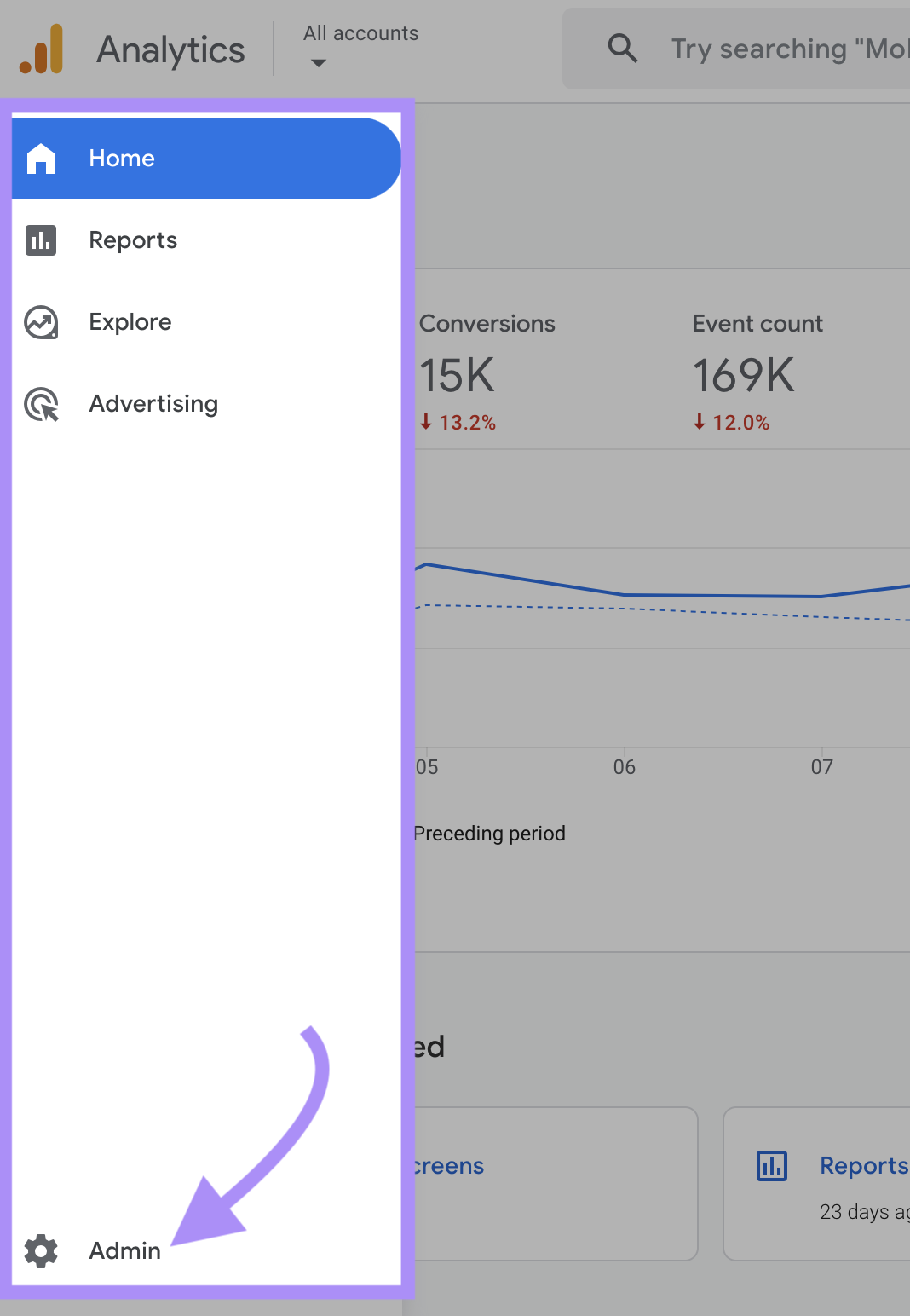
Then, on the Admin dashboard, click on “+ Create” > “Account” to create your Google Analytics account.
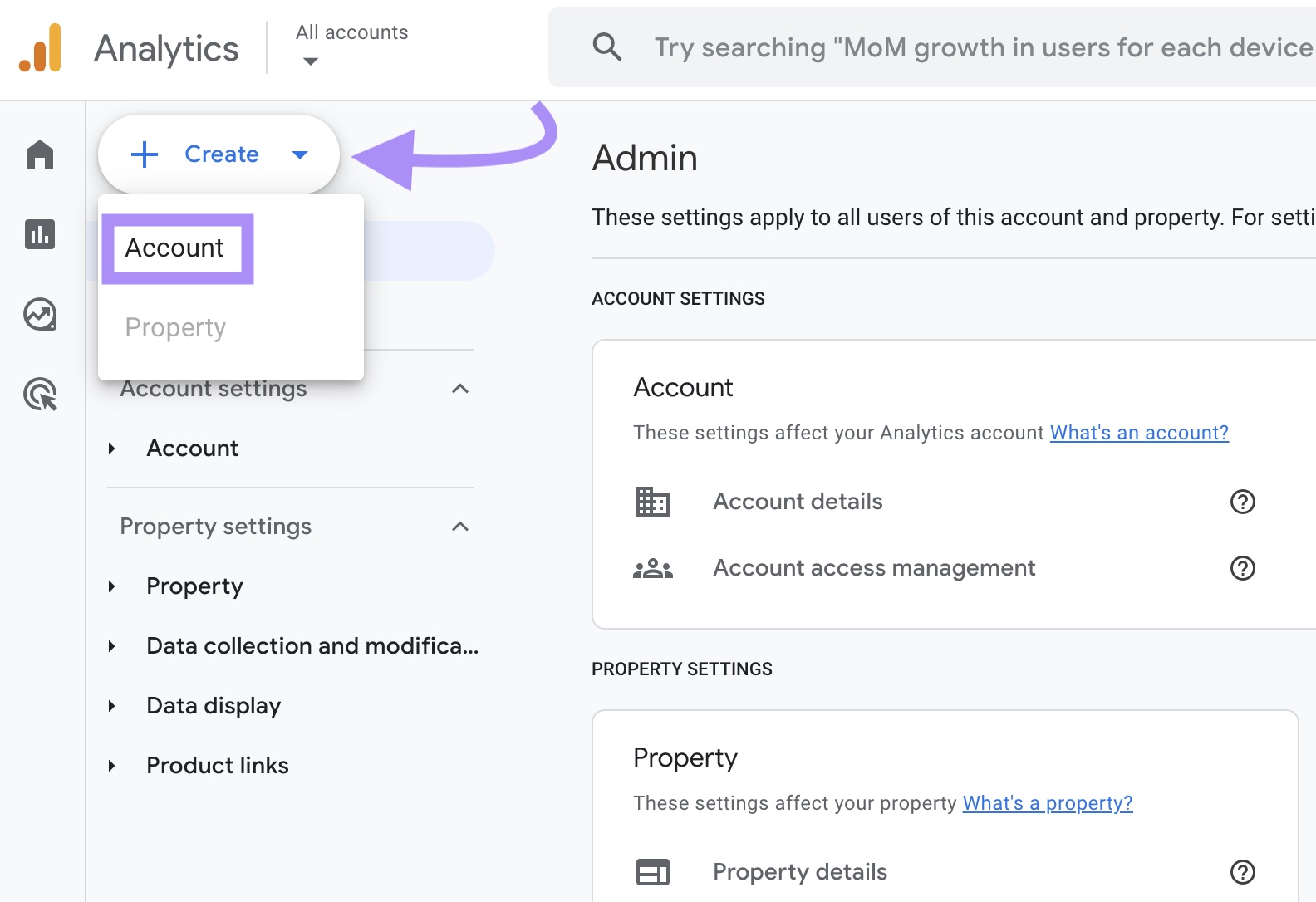
Give your account a reputation within the “Account title” subject. And use the “Account Information Sharing Settings” to pick out the needs for which you’re prepared to share your data with Google.
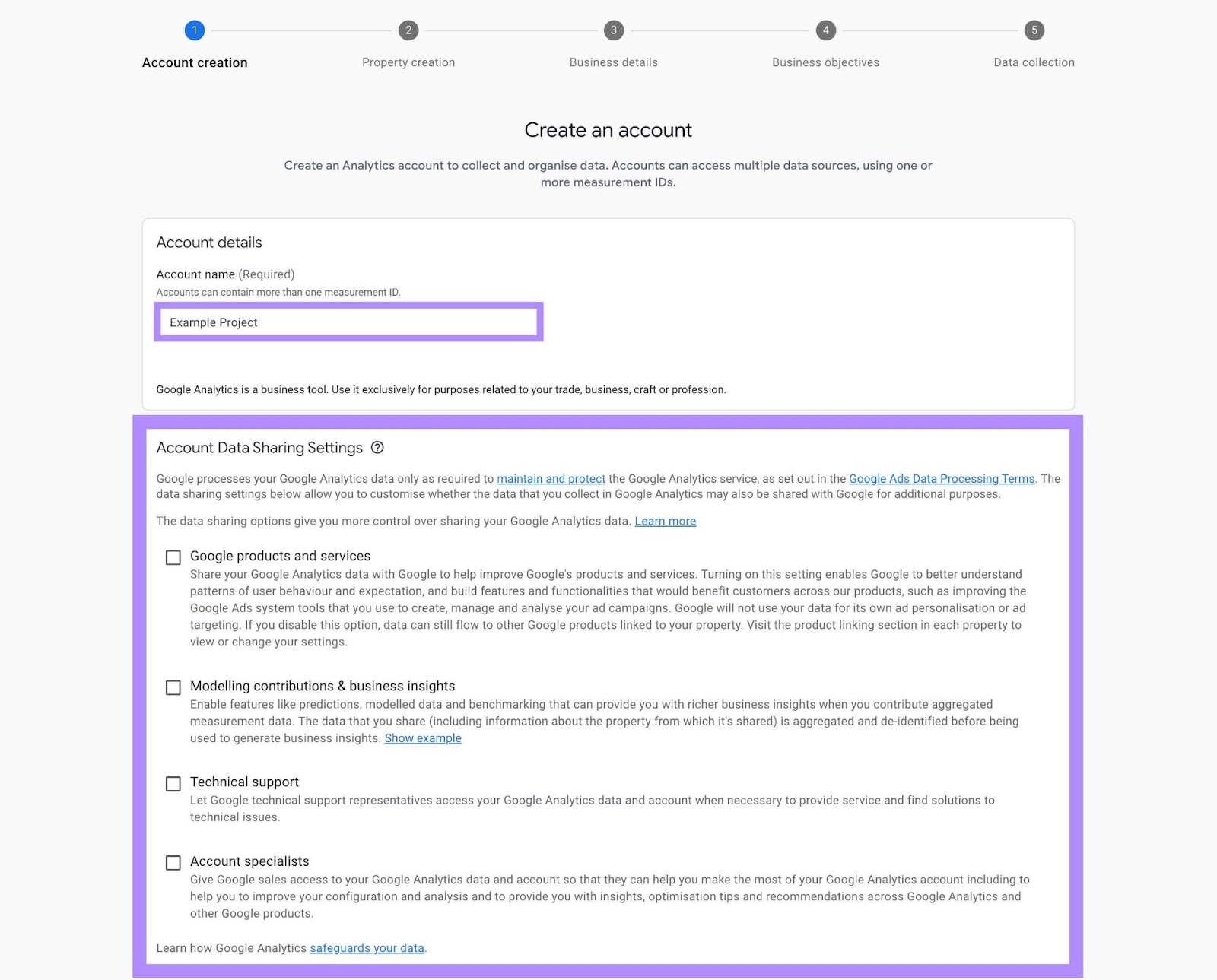
Click on “Subsequent” whenever you’re executed.
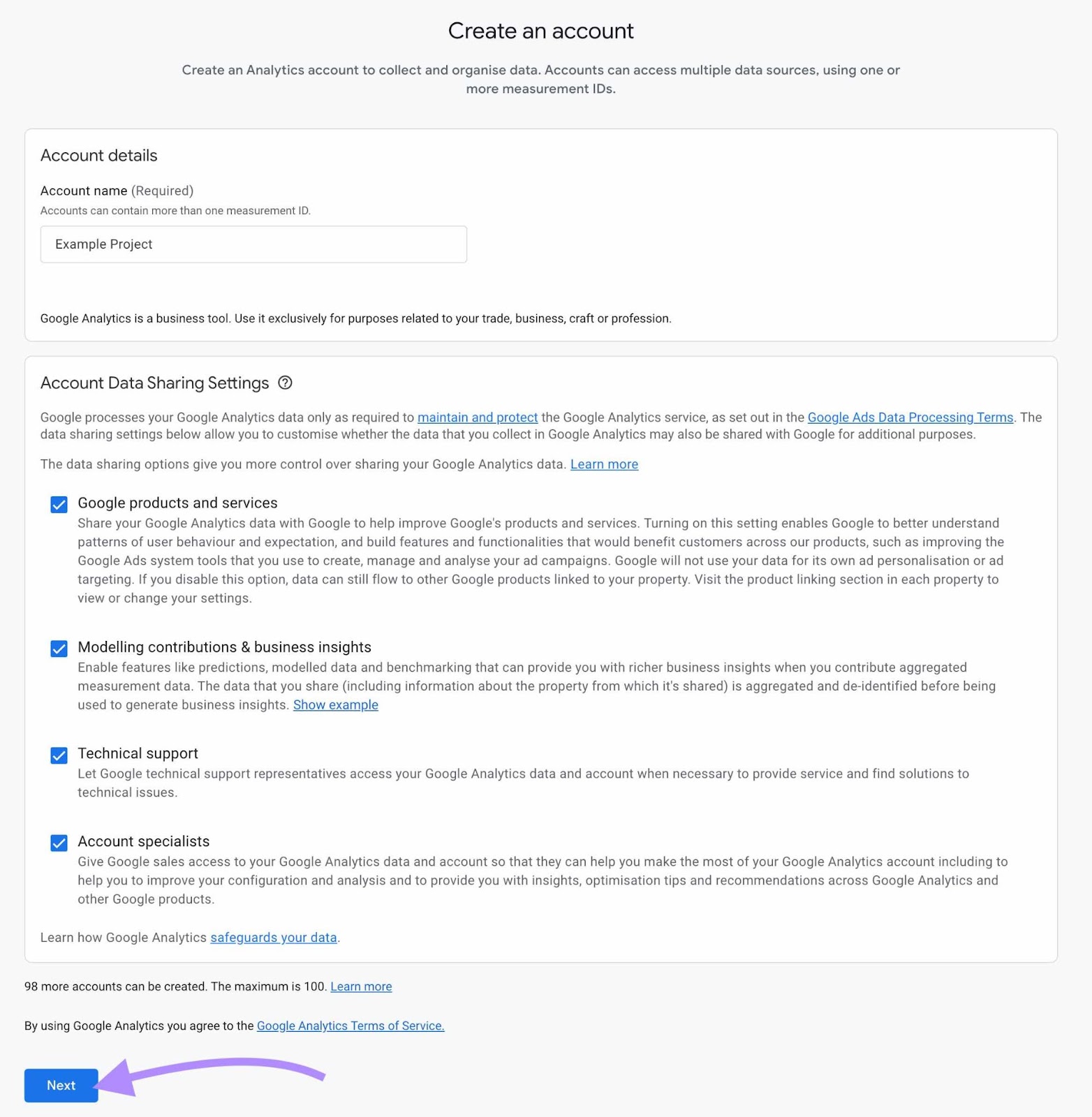
2. Create a GA4 Property
The following step is to create a property in your GA4 account.
A property is a group of knowledge from a web site and/or app. A easy GA4 property instance is a property that comprises knowledge from only one web site. Or one app.
However you probably have extra superior reporting wants, arrange a property to comprise data from multiple sources.
To create a GA4 property, give your property a reputation utilizing the “Property title” subject. The title must comprise no less than 4 characters.
Subsequent, present your most well-liked time zone and forex in your experiences.
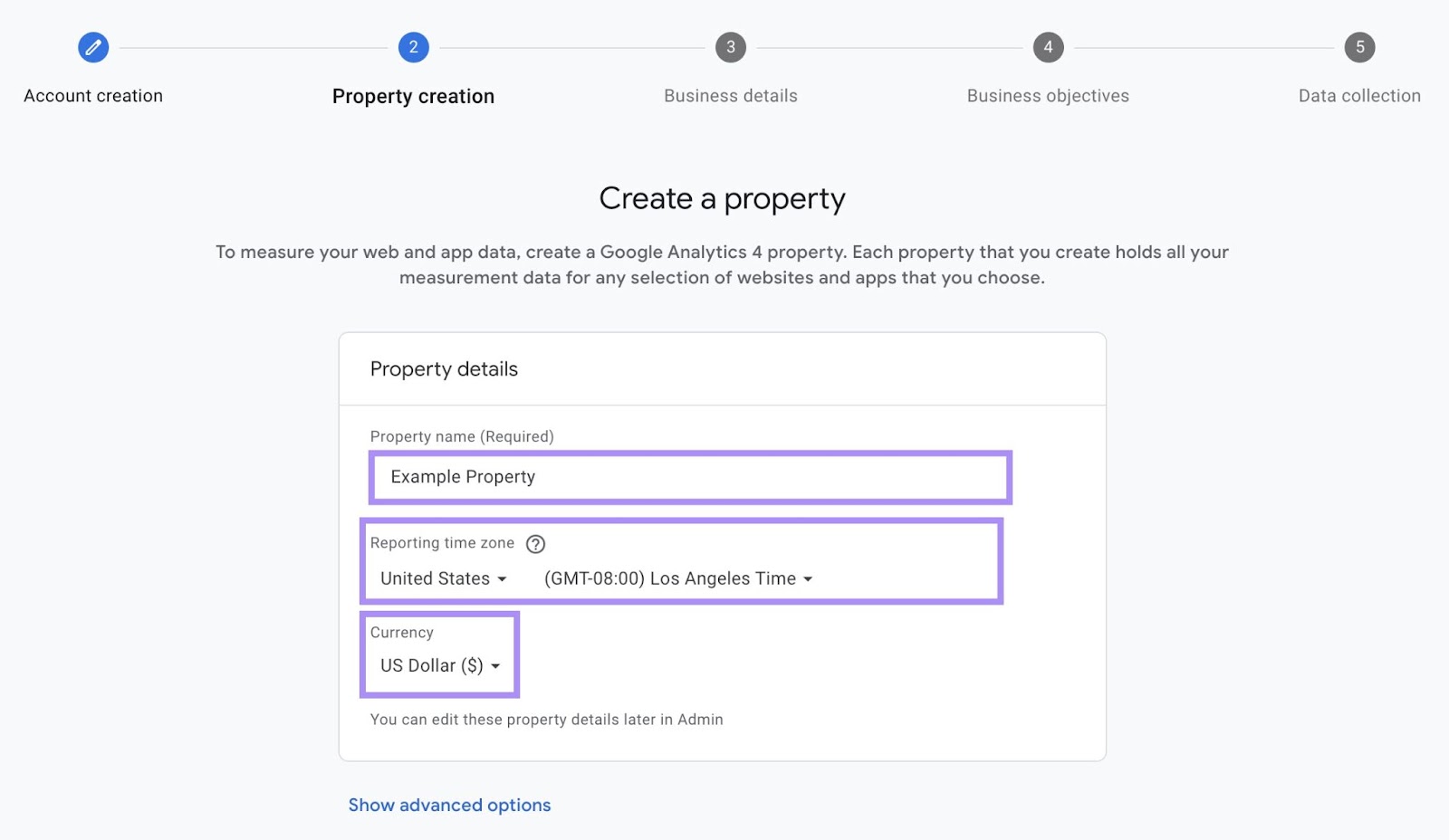
Click on “Subsequent.”
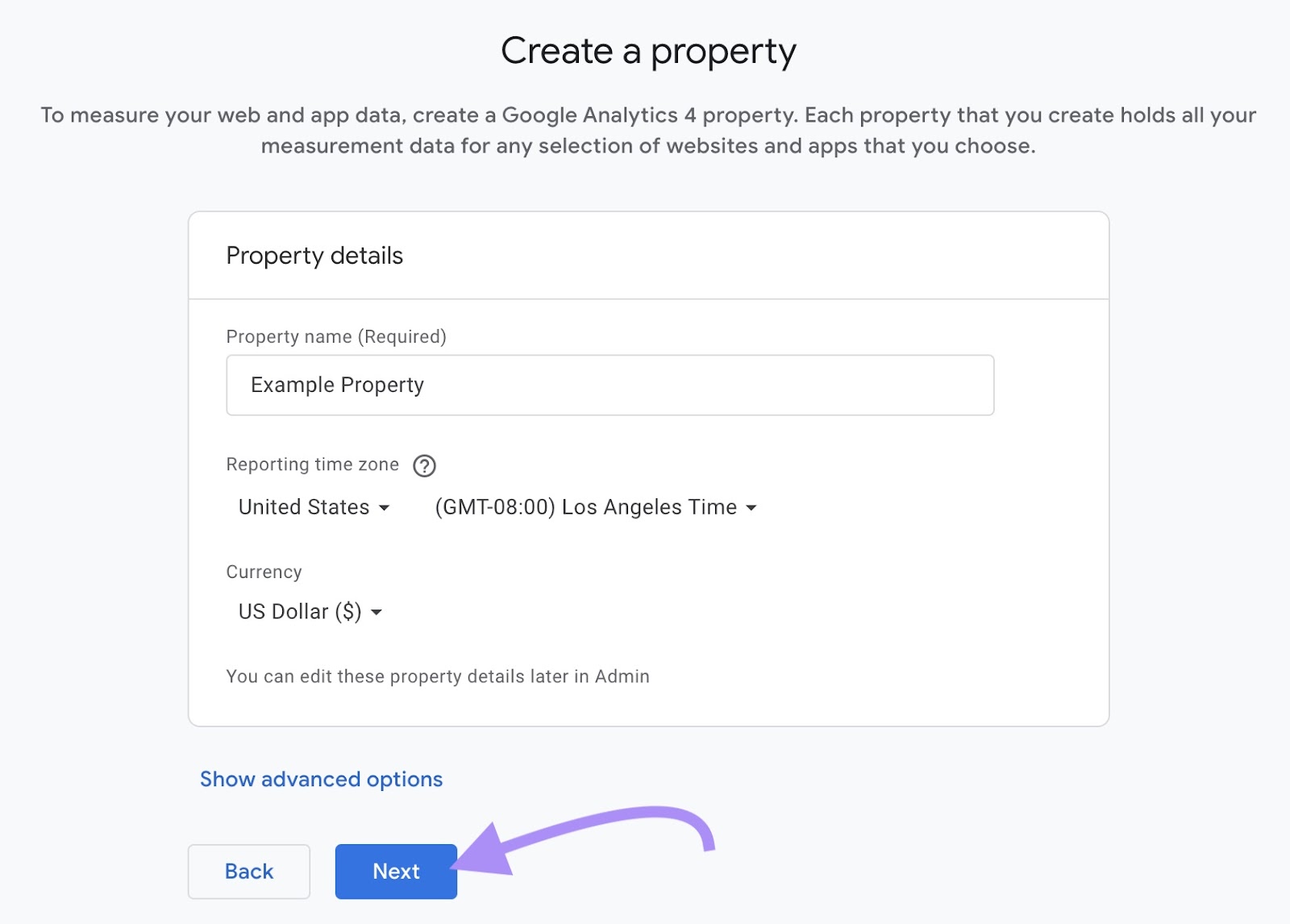
3. Present Your Enterprise Particulars
Fill out the “Business class” and “Enterprise measurement” fields.
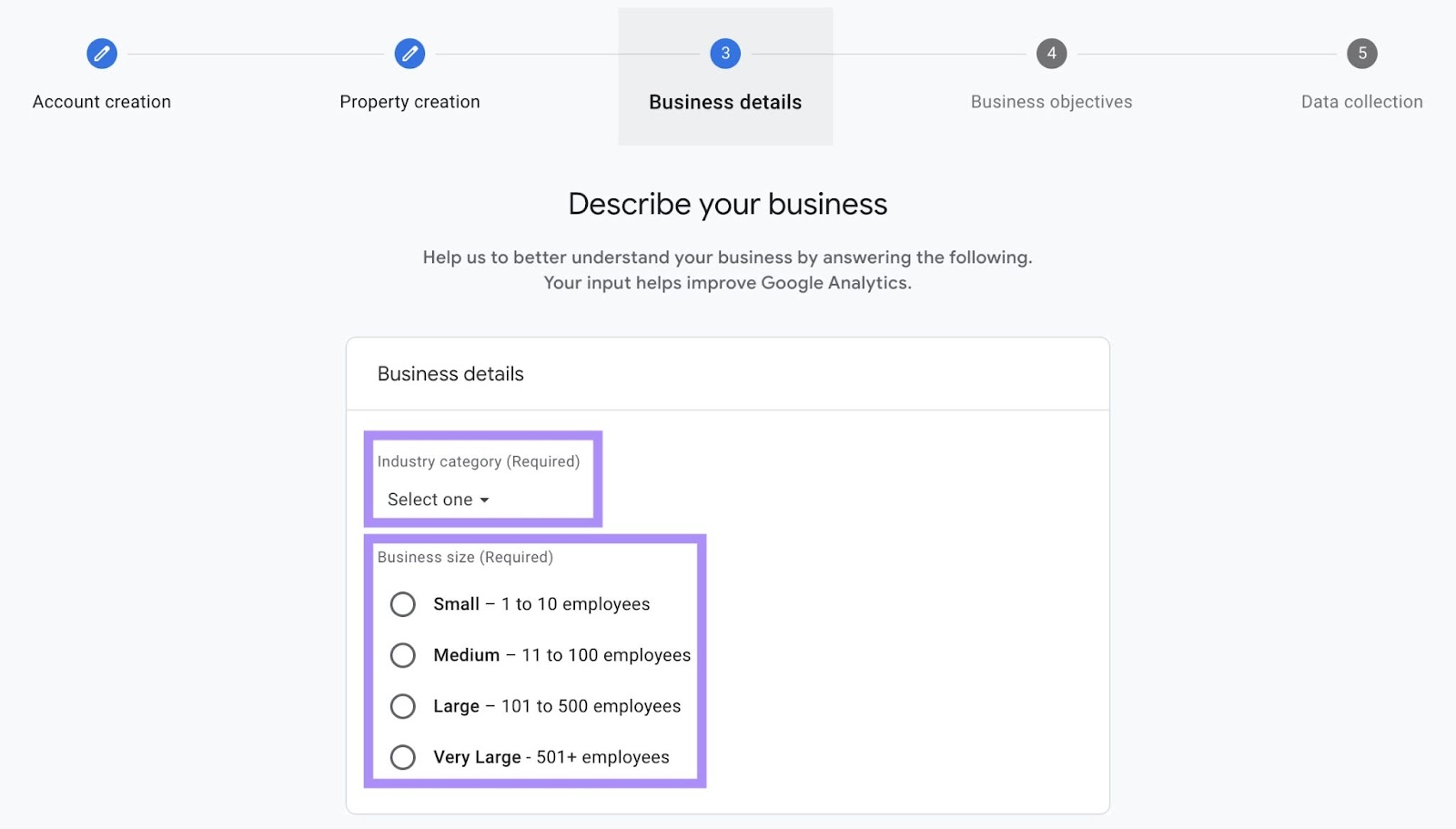
Click on “Subsequent.”

4. Present Your Enterprise Aims
Choose no less than one of many enterprise aims proven on the display. That is to assist GA4 customise its default reports to fulfill your wants.
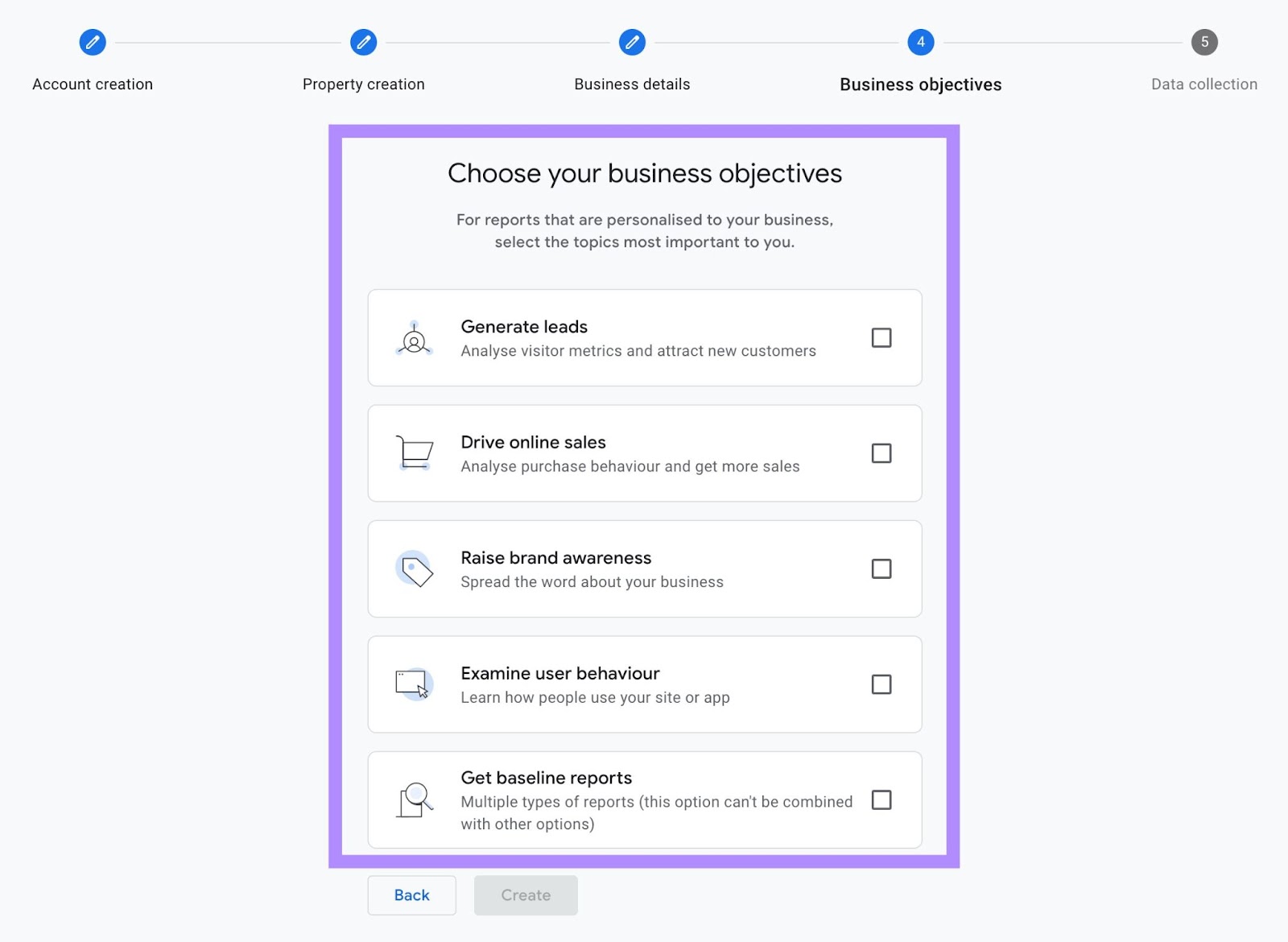
If you choose “Get baseline experiences,” GA4 will present a group of experiences for exercise across the customer life cycle. As a substitute of offering experiences tailor-made to a selected enterprise goal.
Then, click on “Create.”
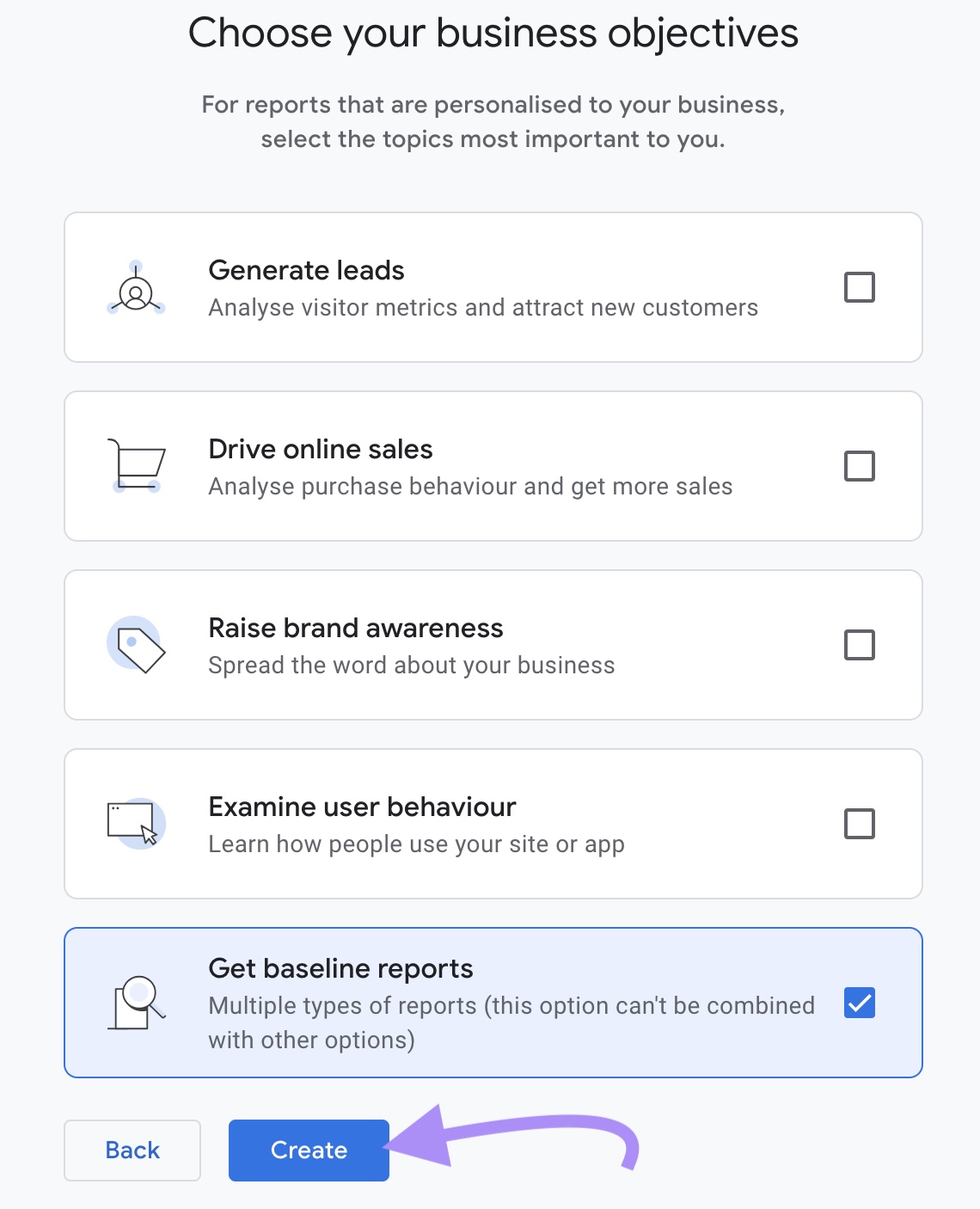
The Google Analytics phrases of service settlement will seem on the display. Modify the nation setting to view the suitable settlement in your geographical area if that you must.
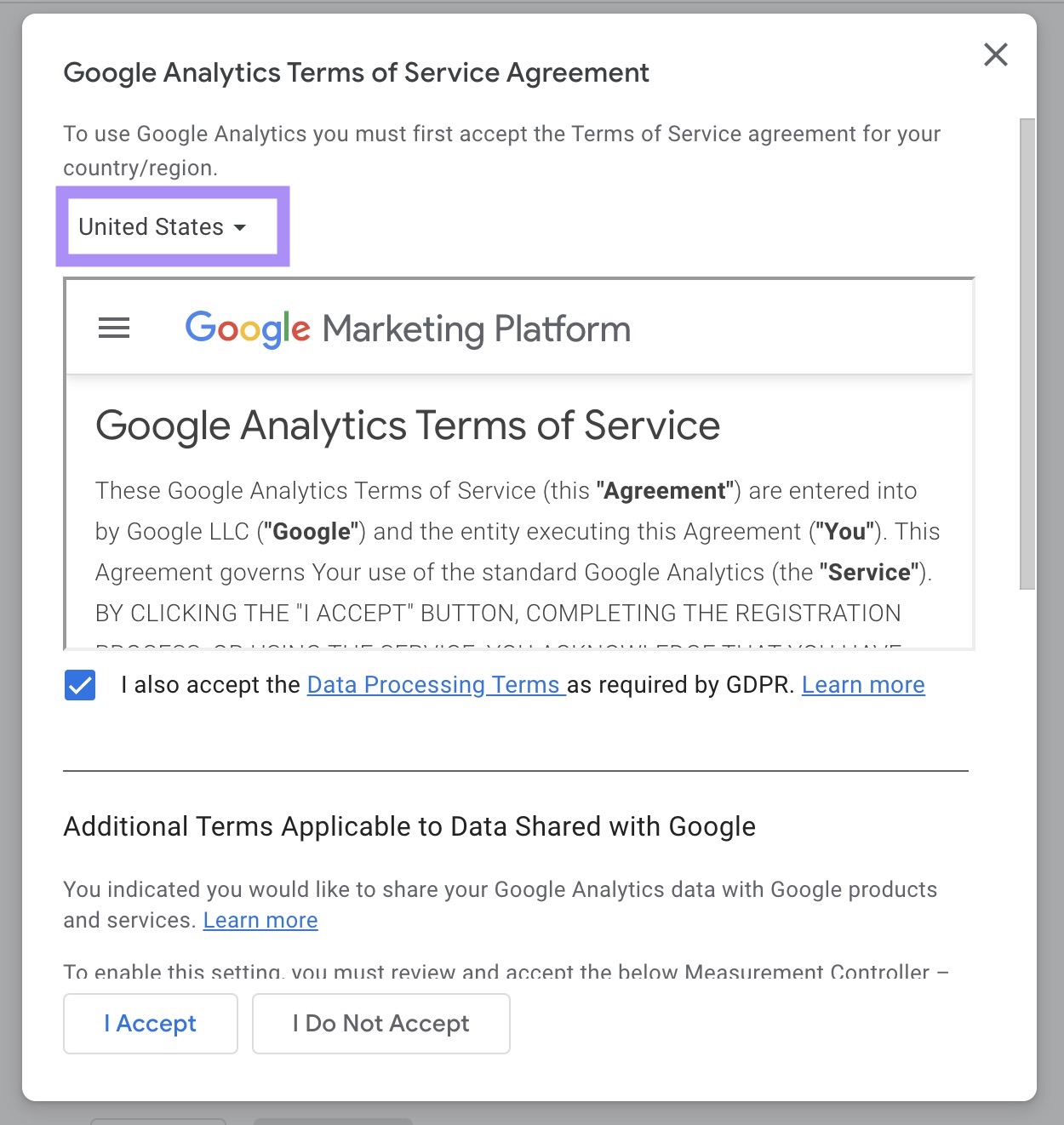
Overview the phrases of service. For those who settle for them, click on “I Settle for” to proceed to the following step.
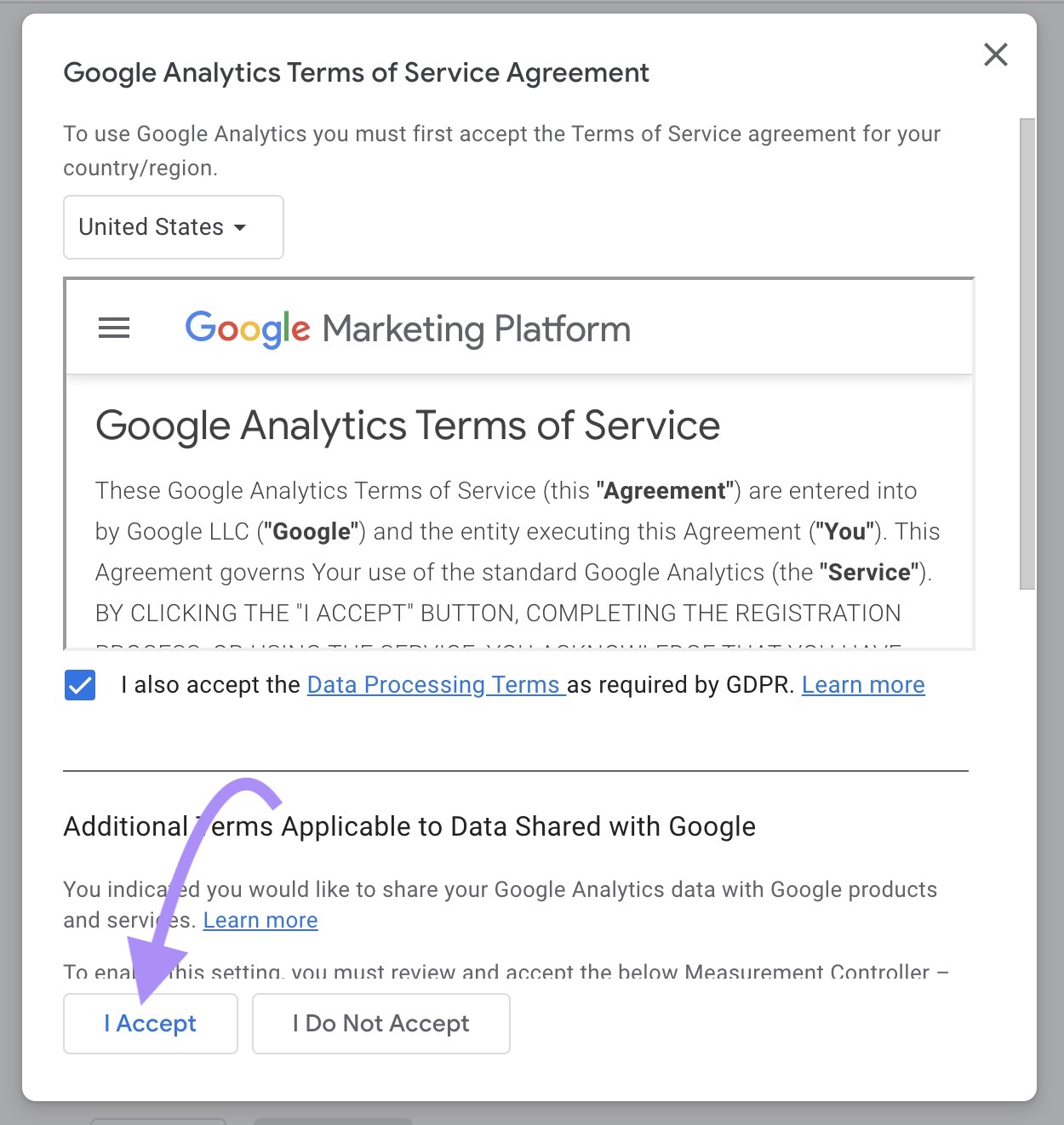
5. Create a Information Stream
The ultimate step is to create a knowledge stream. Which is able to ship knowledge out of your web site or app to your GA4 property.
The steps for creating a knowledge stream differ relying on whether or not your knowledge supply is a web site, iOS app, or Android app.
To create a knowledge stream from a web site, click on “Internet.”
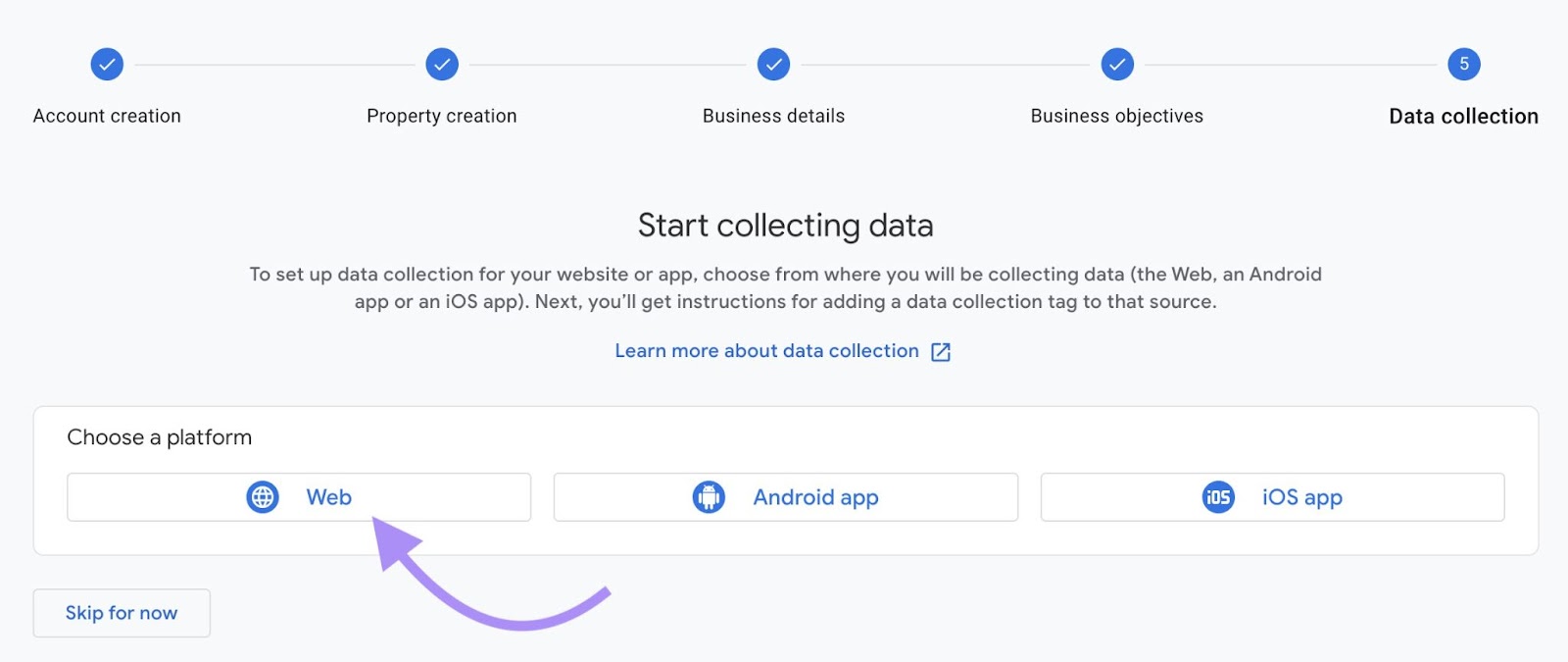
Kind your area into the “Web site URL” subject. And use the “Stream title” subject to call your knowledge stream.
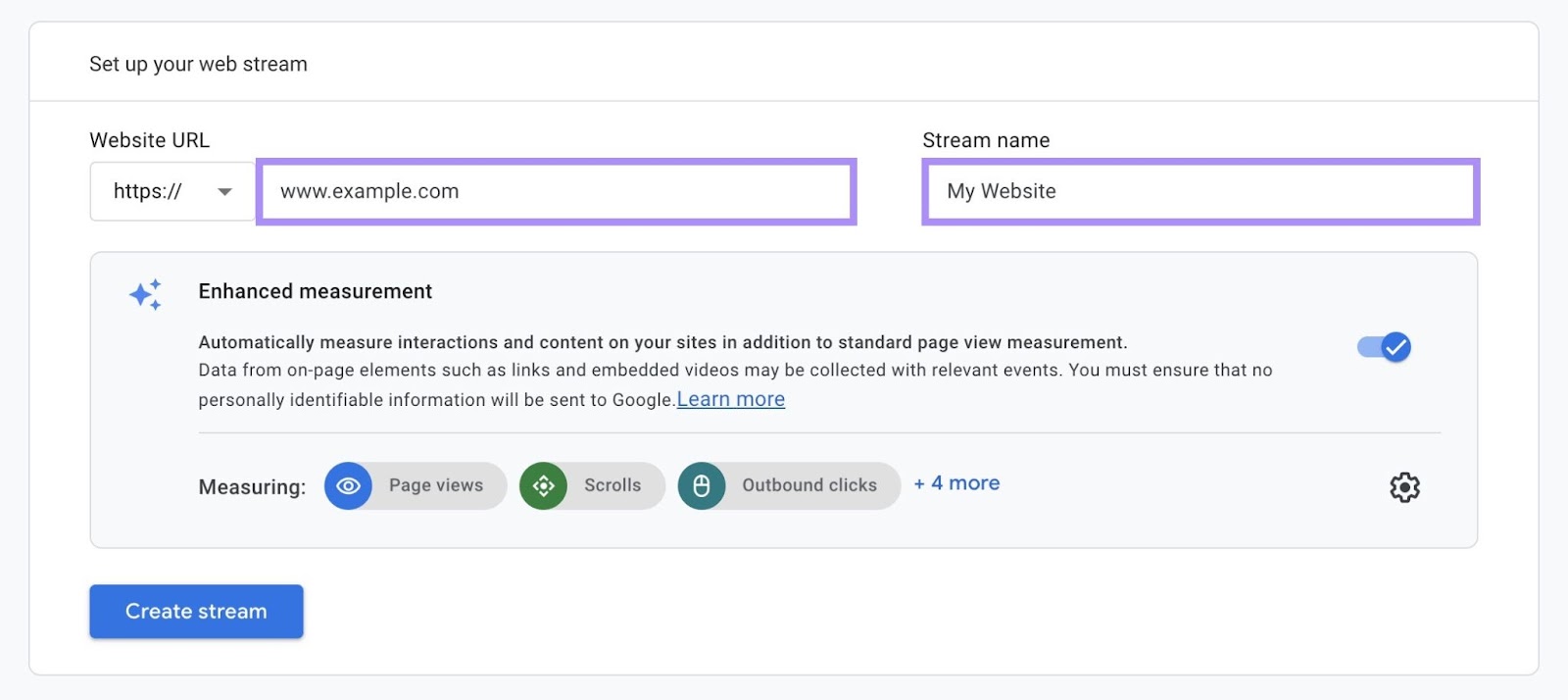
Then click on “Create stream.”
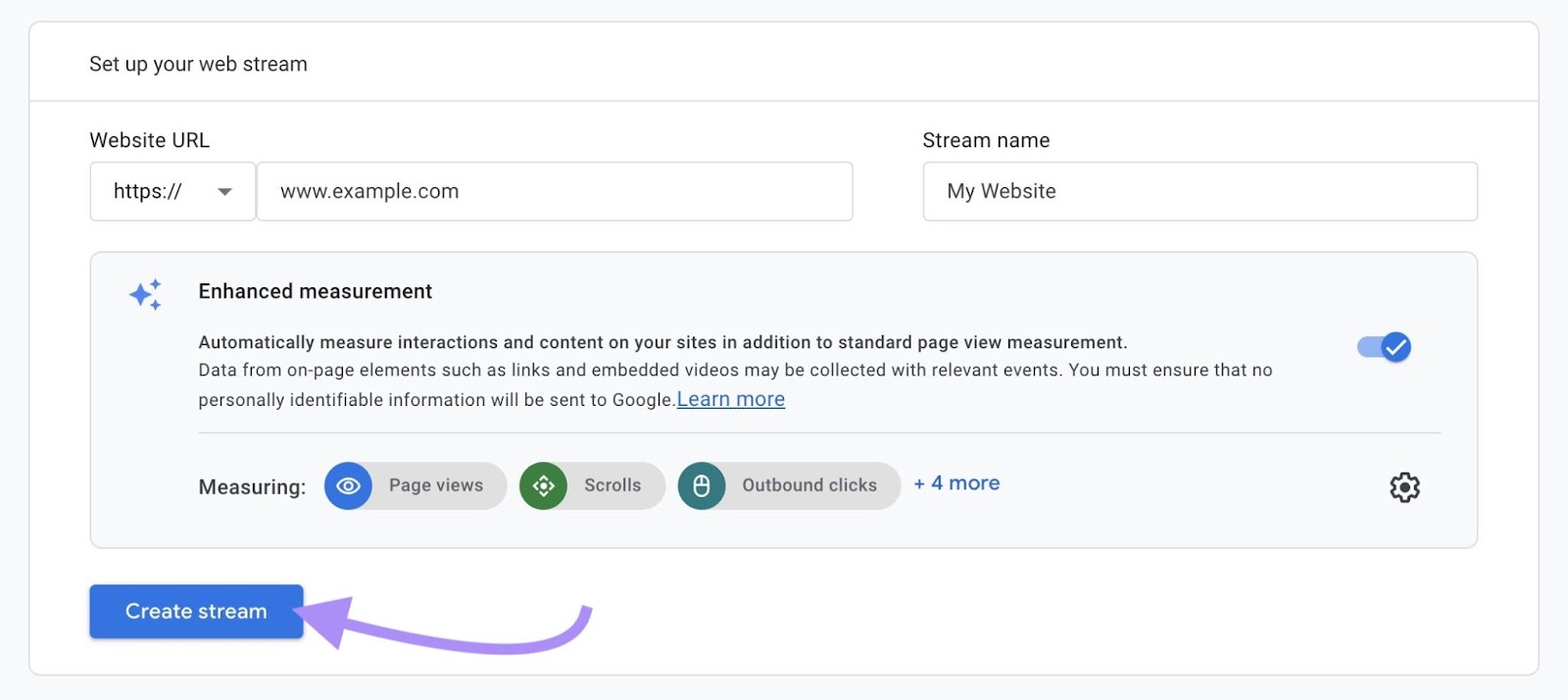
A window will slide in, exhibiting your knowledge stream’s measurement ID and different particulars.
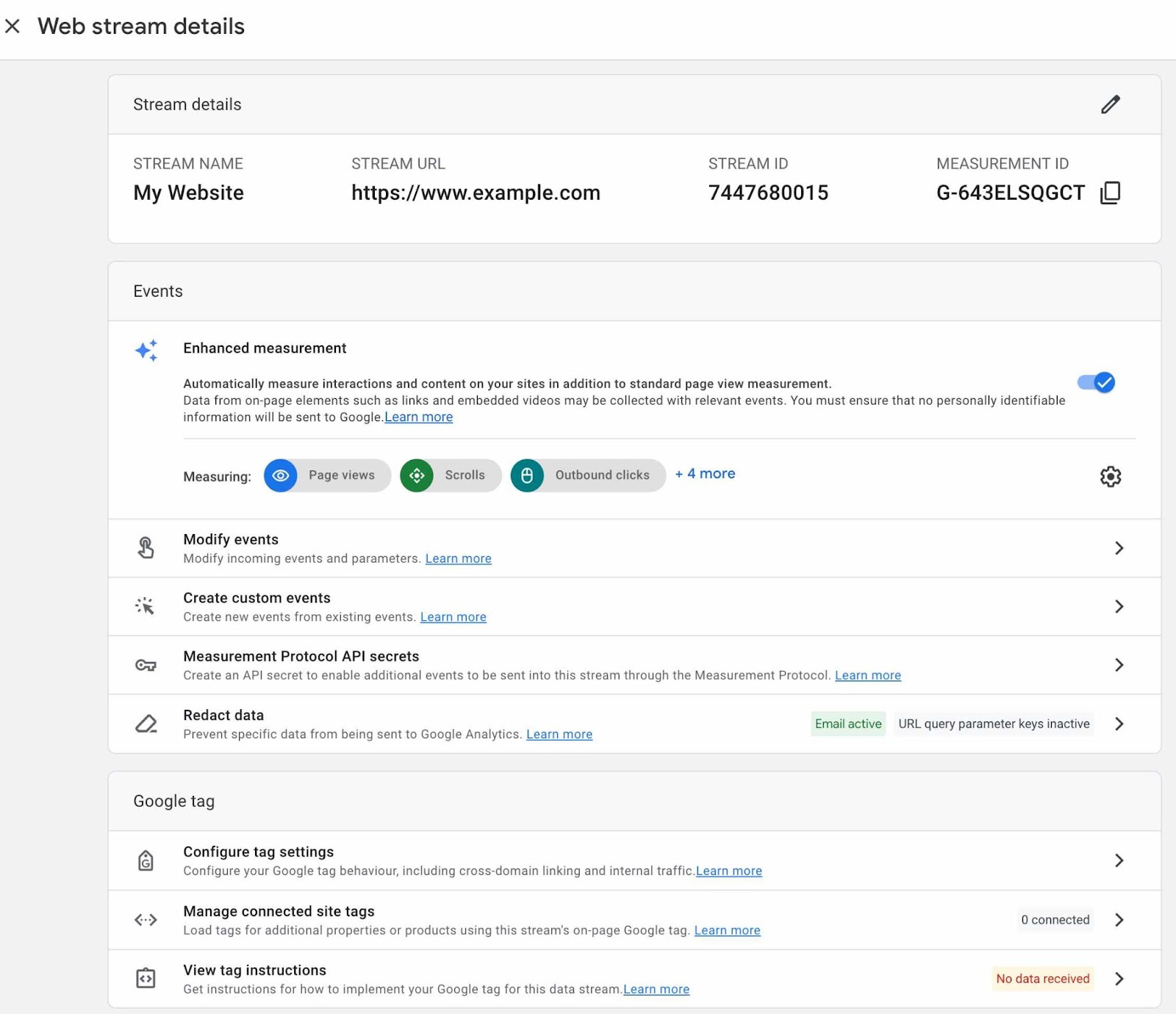
Save the measurement ID to a textual content file for handy reference—it’s possible you’ll want it later.
After creating the info stream in your web site, the following step is to put in GA4 on it.
Additional studying: This guide covers the best way to create knowledge streams from iOS and Android apps.
Learn how to Set up GA4 on Your Web site
Watch this video for an outline of the GA4 set up course of on a web site:

We’ll additionally share the steps for these three GA4 set up strategies beneath.
The primary technique is good if you have already got Google Tag Manager (GTM) put in in your web site.
In distinction, we advocate utilizing the second technique for those who created your web site utilizing a web site builder like WordPress, Squarespace, or Wix. And don’t have GTM put in on it.
In case your web site doesn’t have GTM put in and it will possibly’t combine with GA4 (whether or not with a local or third-party integration), use the third technique as an alternative.
Technique 1: Set up GA4 with Google Tag Supervisor
GTM is a platform for putting in code snippets (referred to as “tags”) on a web site with out modifying its code instantly. This consists of tags for GA4.
If you wish to use this GA4 set up technique however haven’t arrange GTM in your web site, follow the steps here to take action first.
Within the course of, you’ll arrange a “container,” which is a group of the tags and different modifications you’ve added to your web site utilizing GTM.
Then, go to https://tagmanager.google.com/ and log in to your Google account.
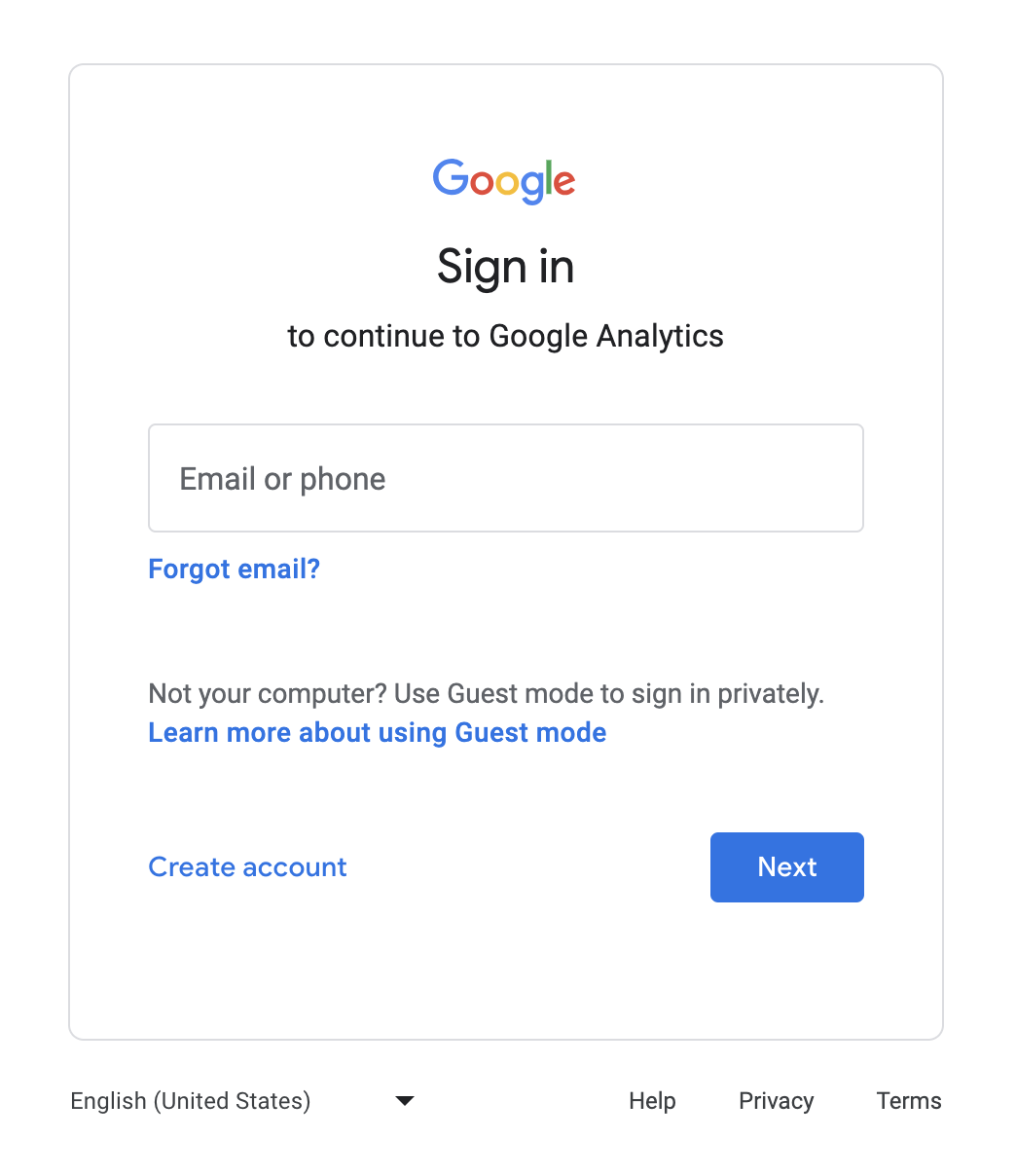
Choose your web site’s GTM container.

Click on the “Add a brand new tag” choice in your container’s workspace overview.

Click on “Untitled Tag” to present your tag a reputation, like “GA4 Setup”:
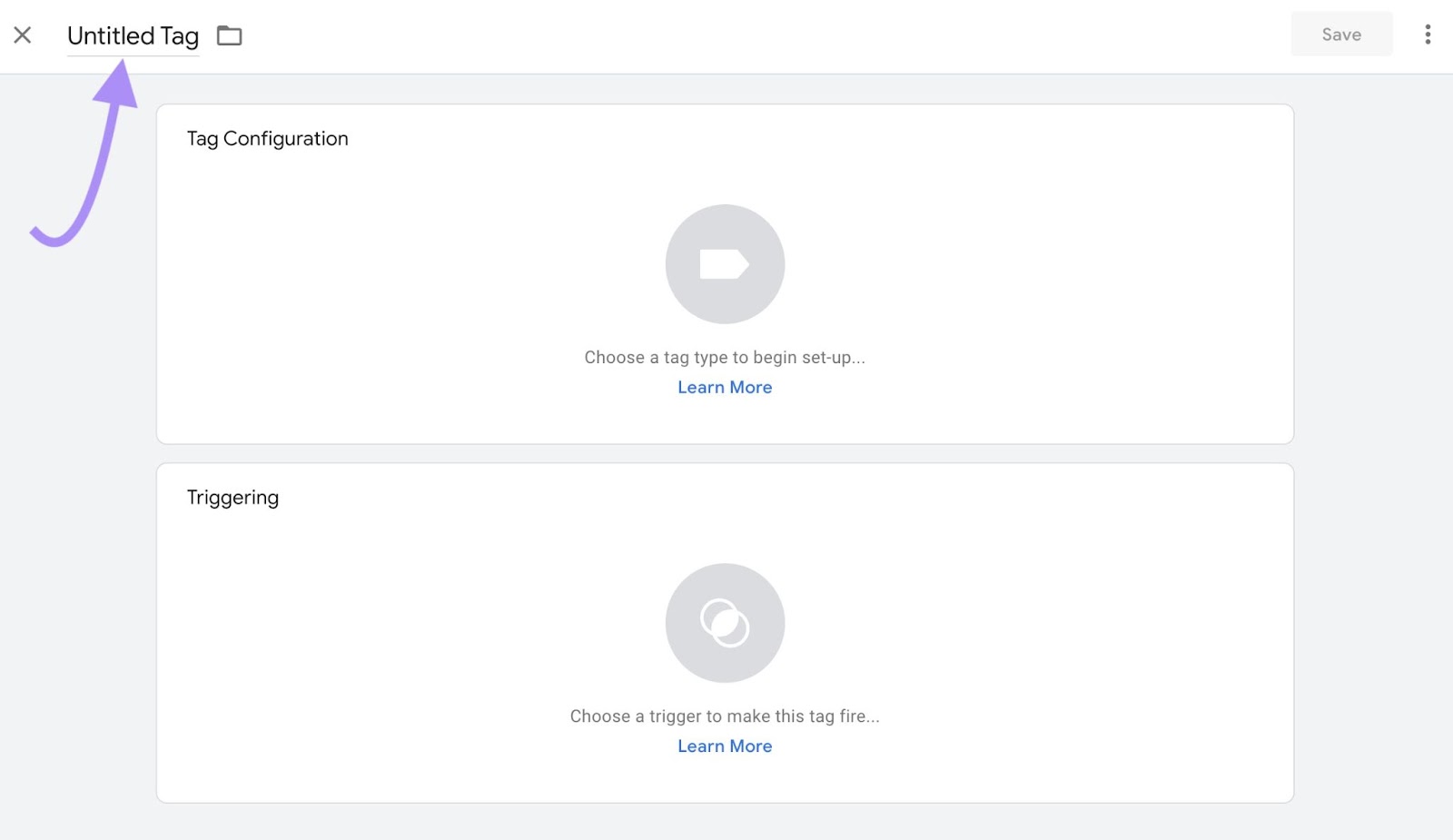
Then, click on wherever within the “Tag Configuration” panel.
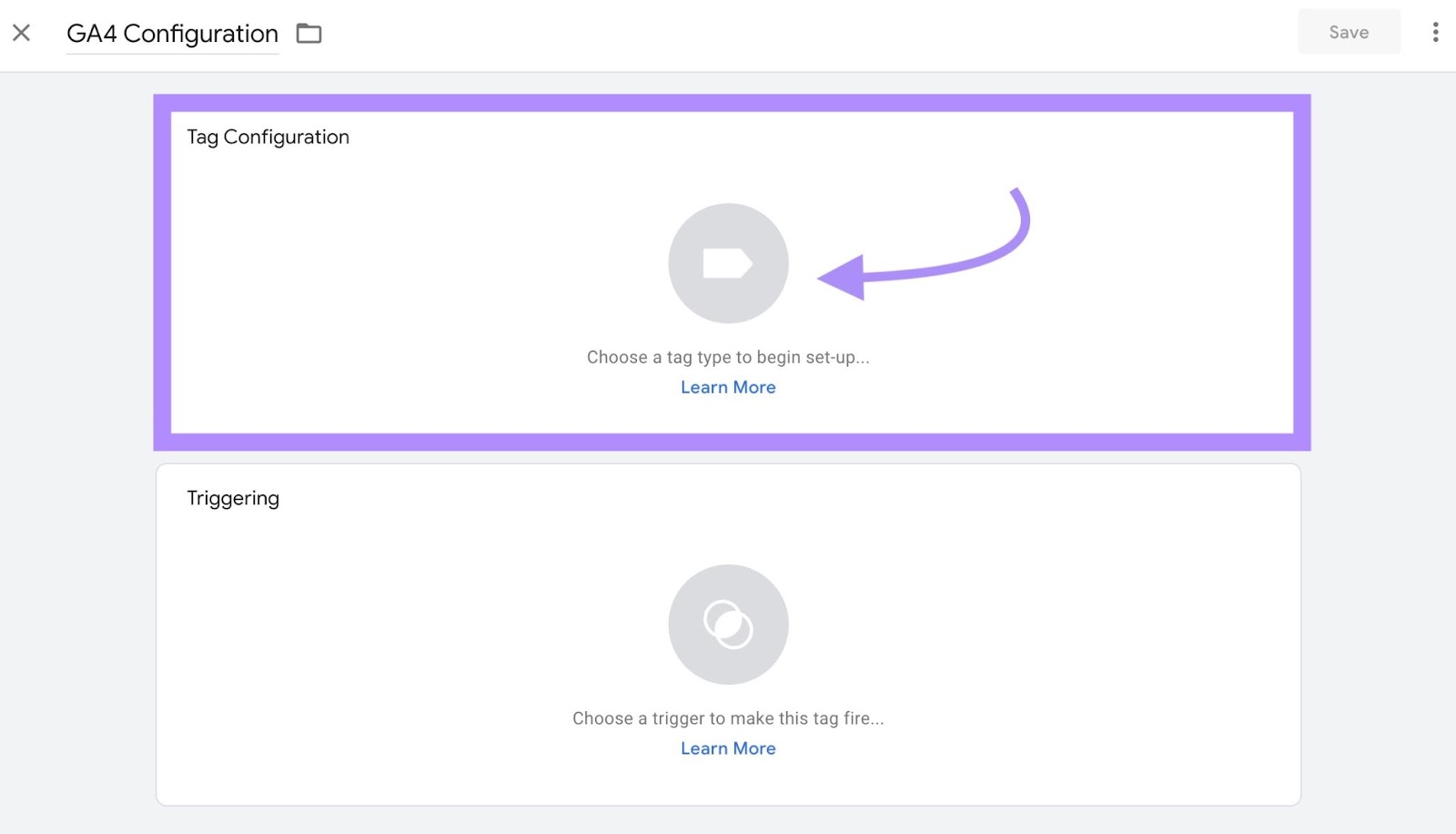
From the “Select tag kind” window that slides in, choose “Google Tag.”
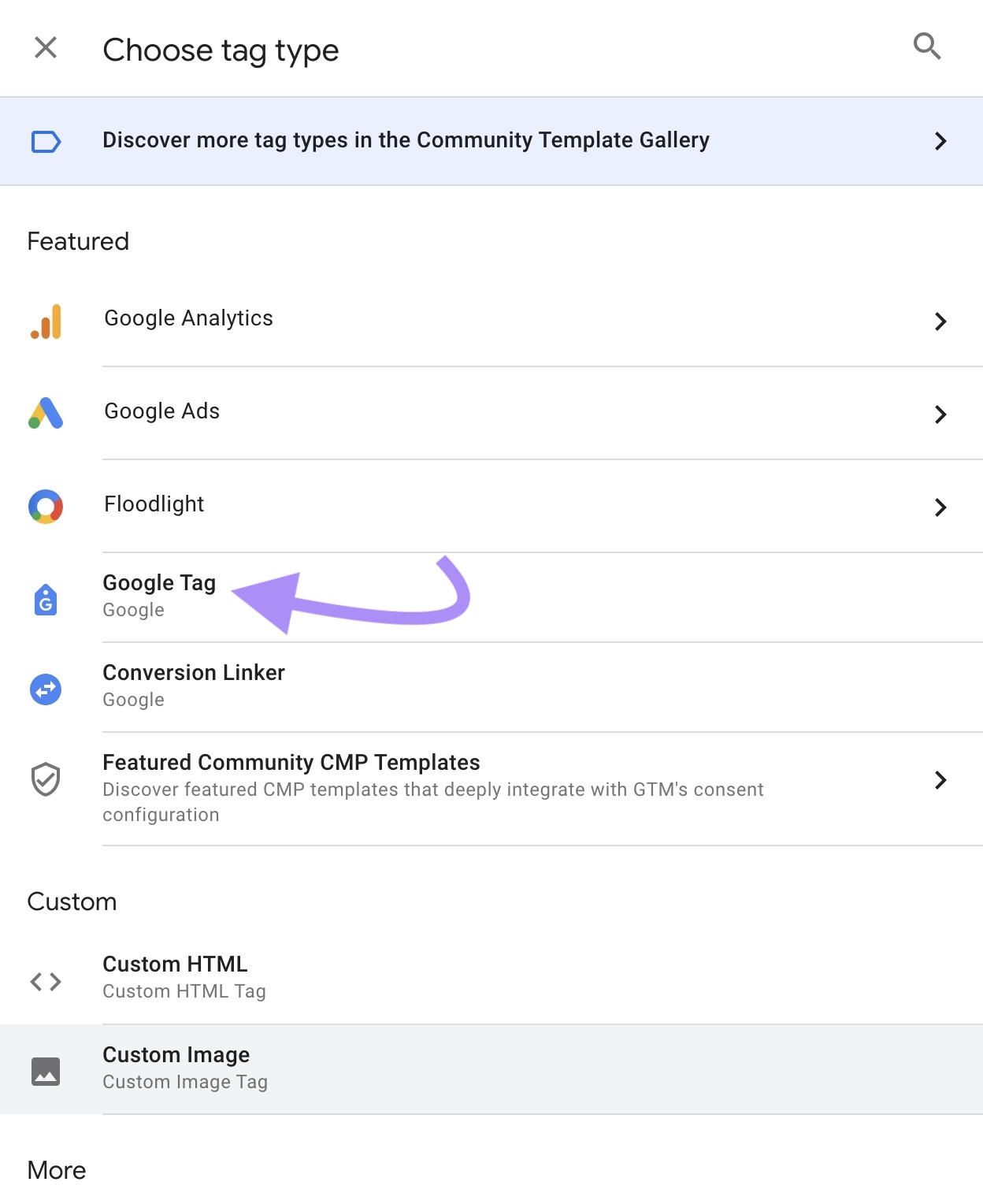
Fill out the “Tag ID” subject along with your GA4 knowledge stream’s measurement ID. For those who haven’t saved your measurement ID after creating your knowledge stream, learn how to find it here.
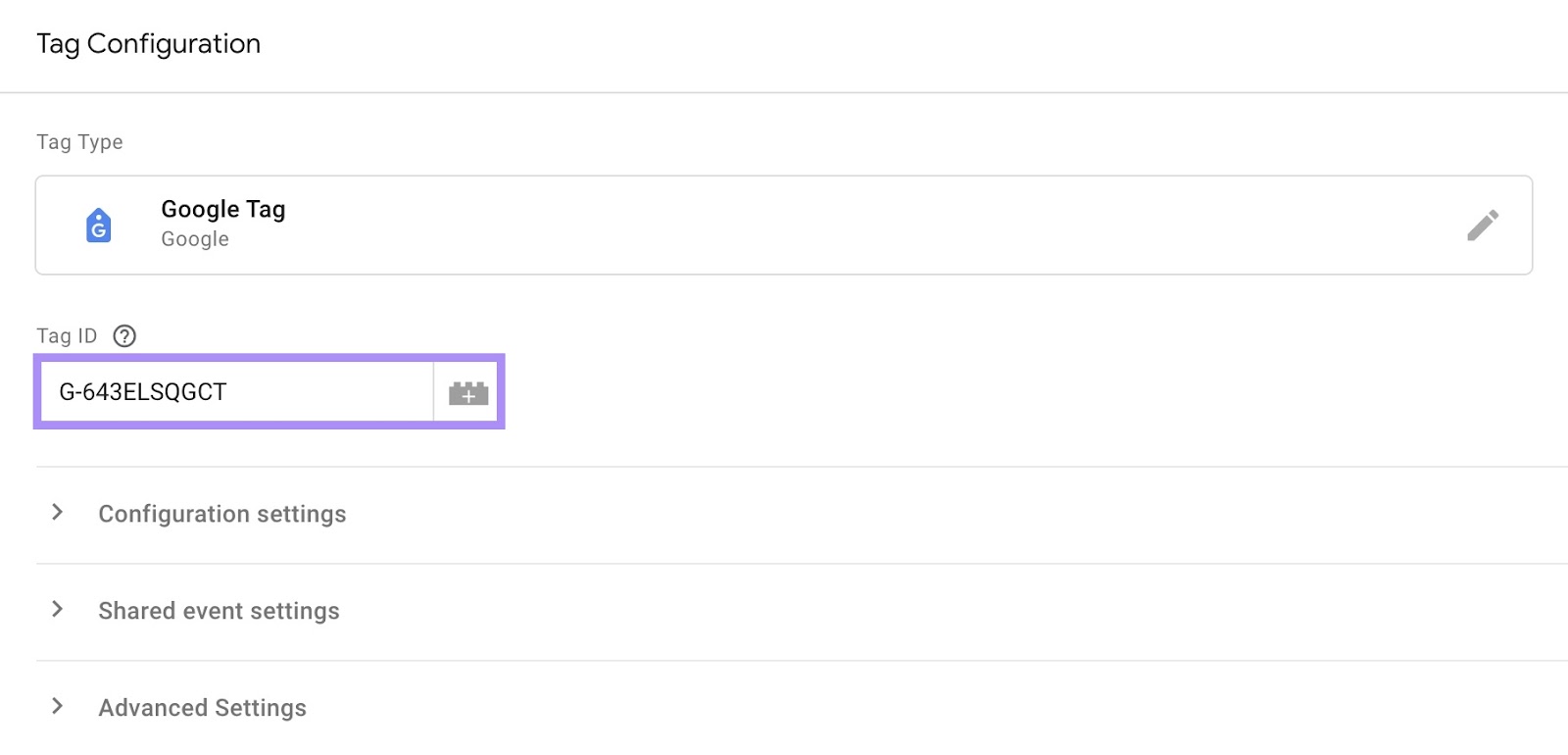
After that, optionally regulate your tag’s configuration, shared occasion, and superior settings.
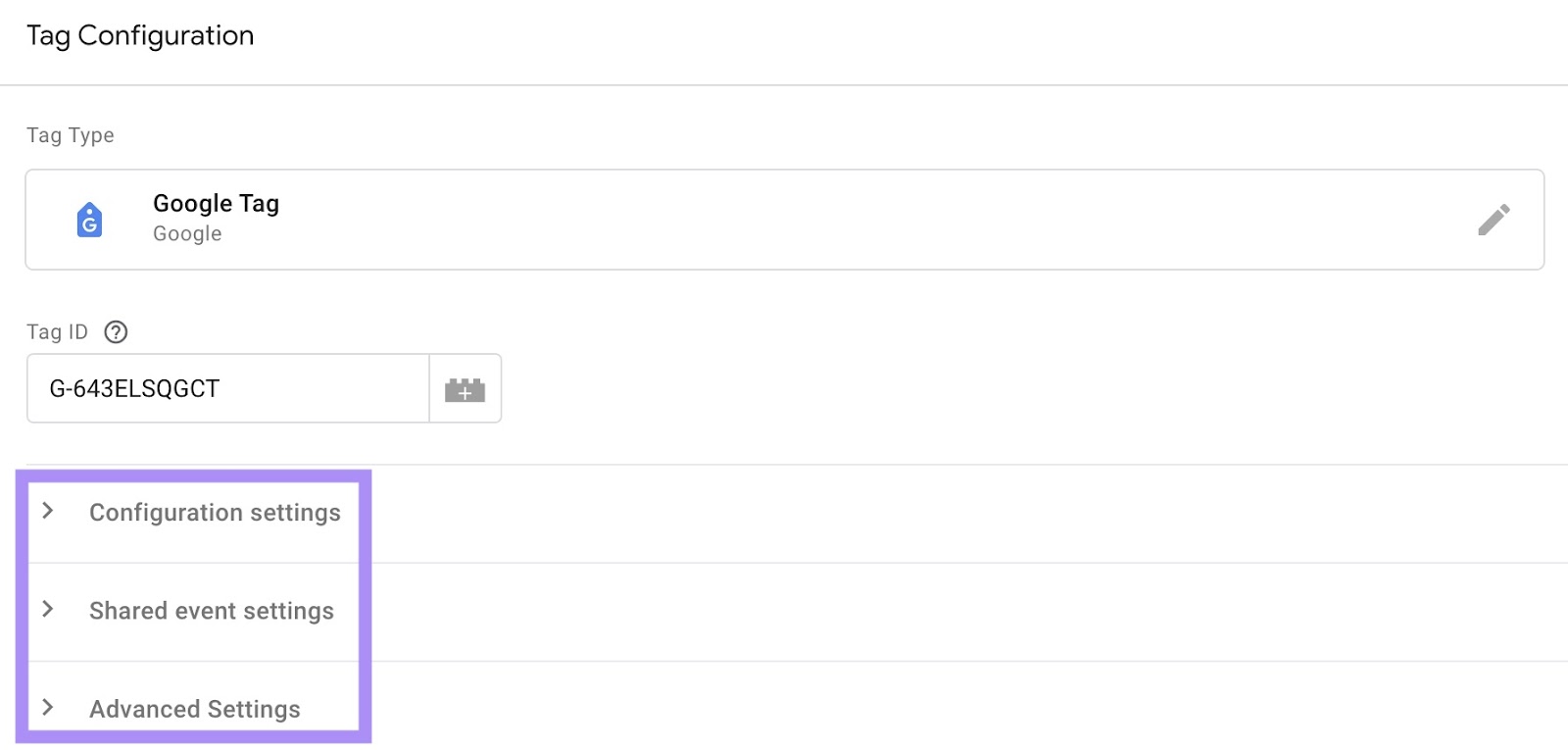
Whenever you’re executed, click on wherever within the “Triggering” panel to arrange when GTM ought to “fireplace” (or load) the GA4 tag. So the tag will ship knowledge out of your web site to GA4.
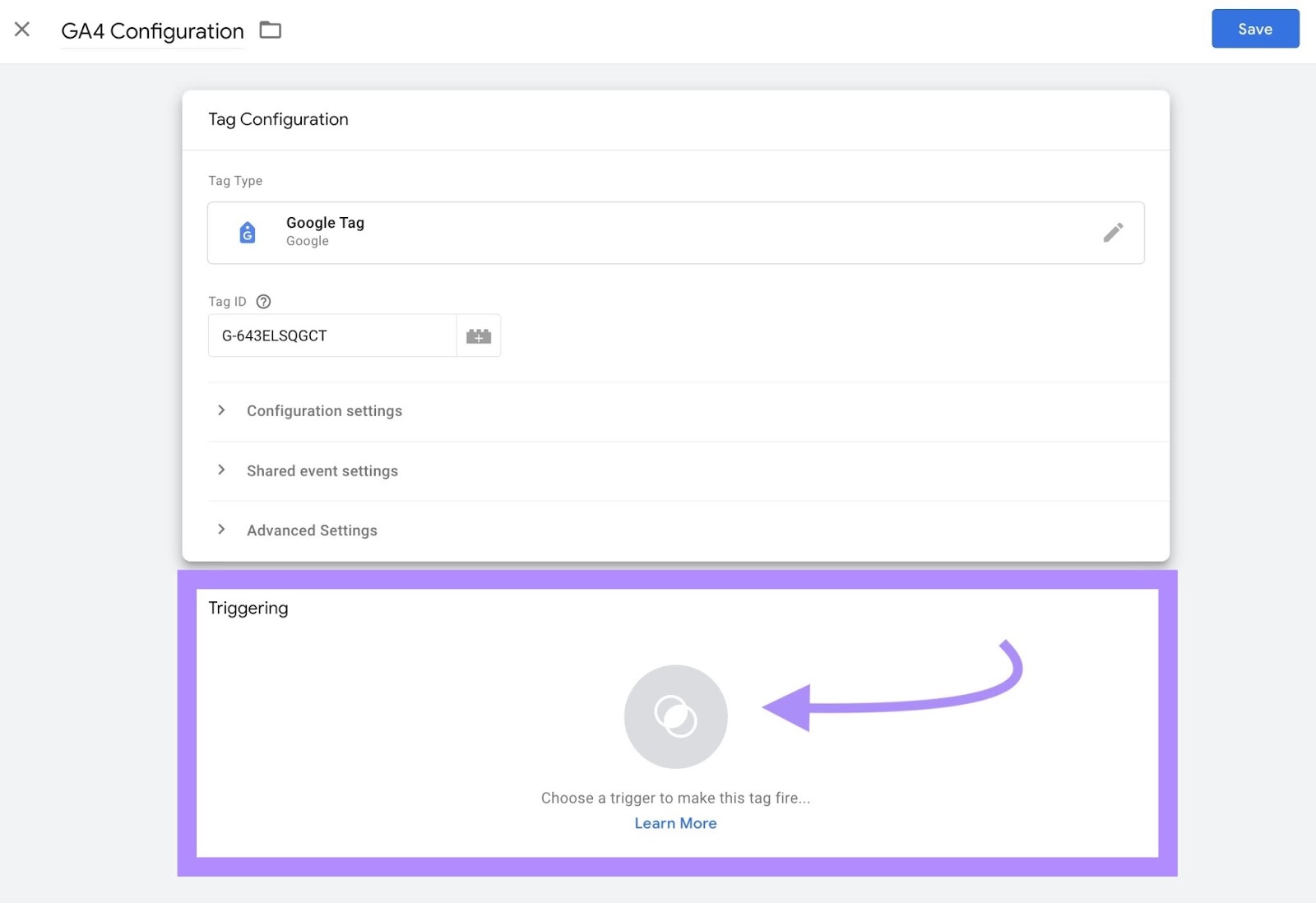
From the “Select a set off” window that slides in, choose “Initialization – All Pages.” That is the usual GA4 set off choice, which is able to trigger the GA4 tag to fireplace forward of every other tags you’ve added to your web site.

Click on “Save” on the prime of the tag setup window to avoid wasting your new tag.
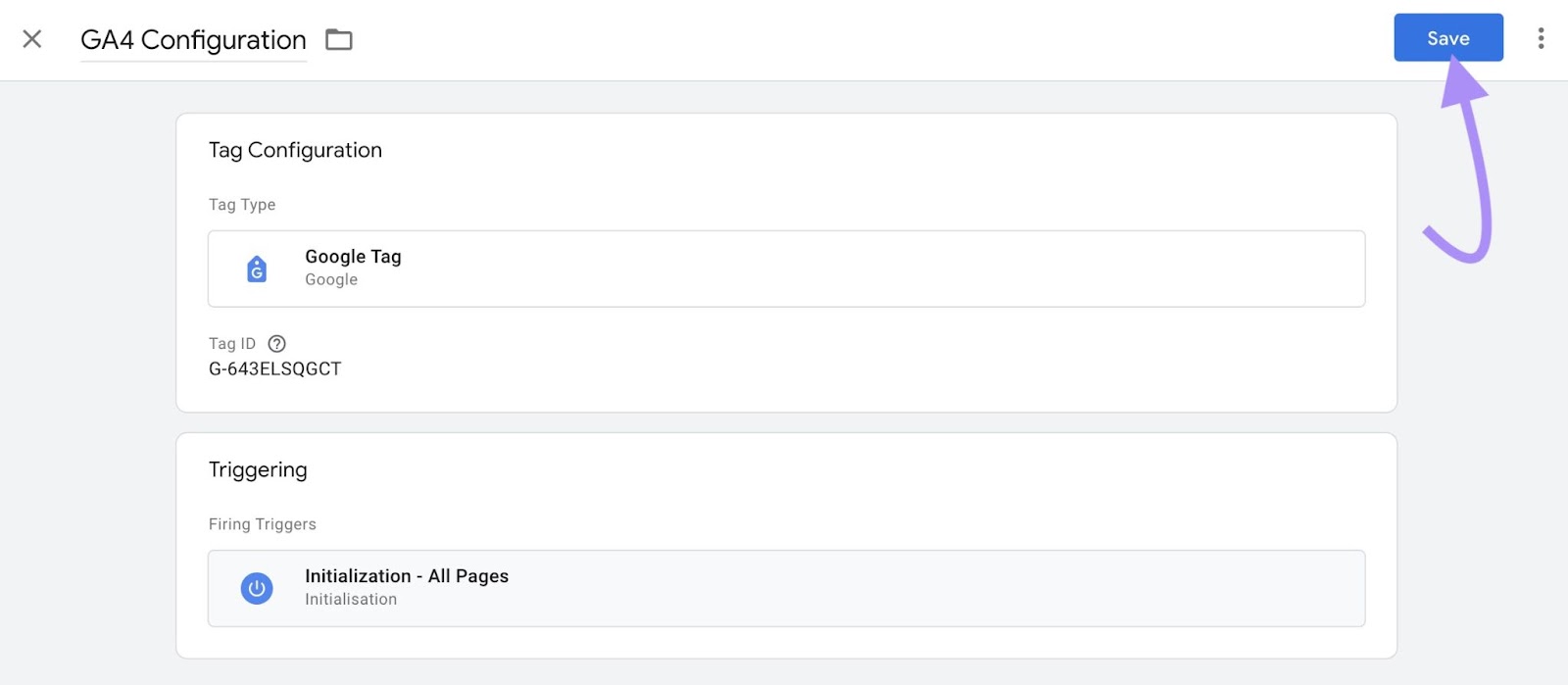
Subsequent, check your GA4 tag by clicking “Preview” out of your container’s workspace overview.
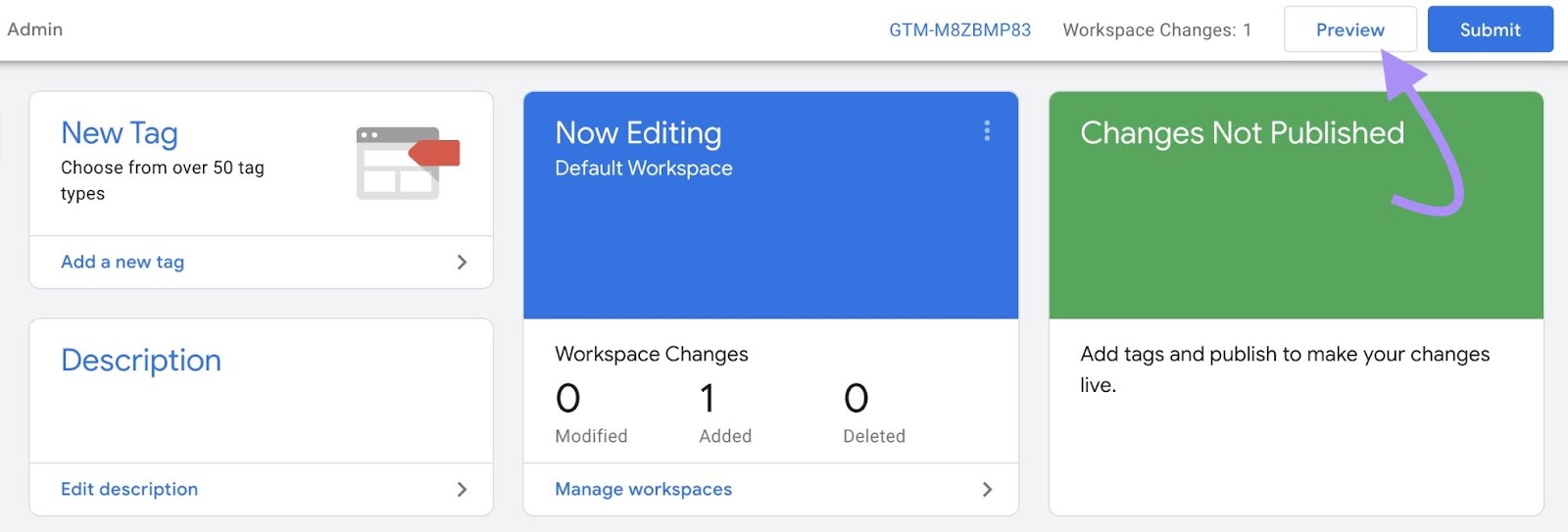
The Google Tag Assistant will launch in a brand new browser tab. Kind your area into the “Your web site’s URL” subject, then click on “Join.”
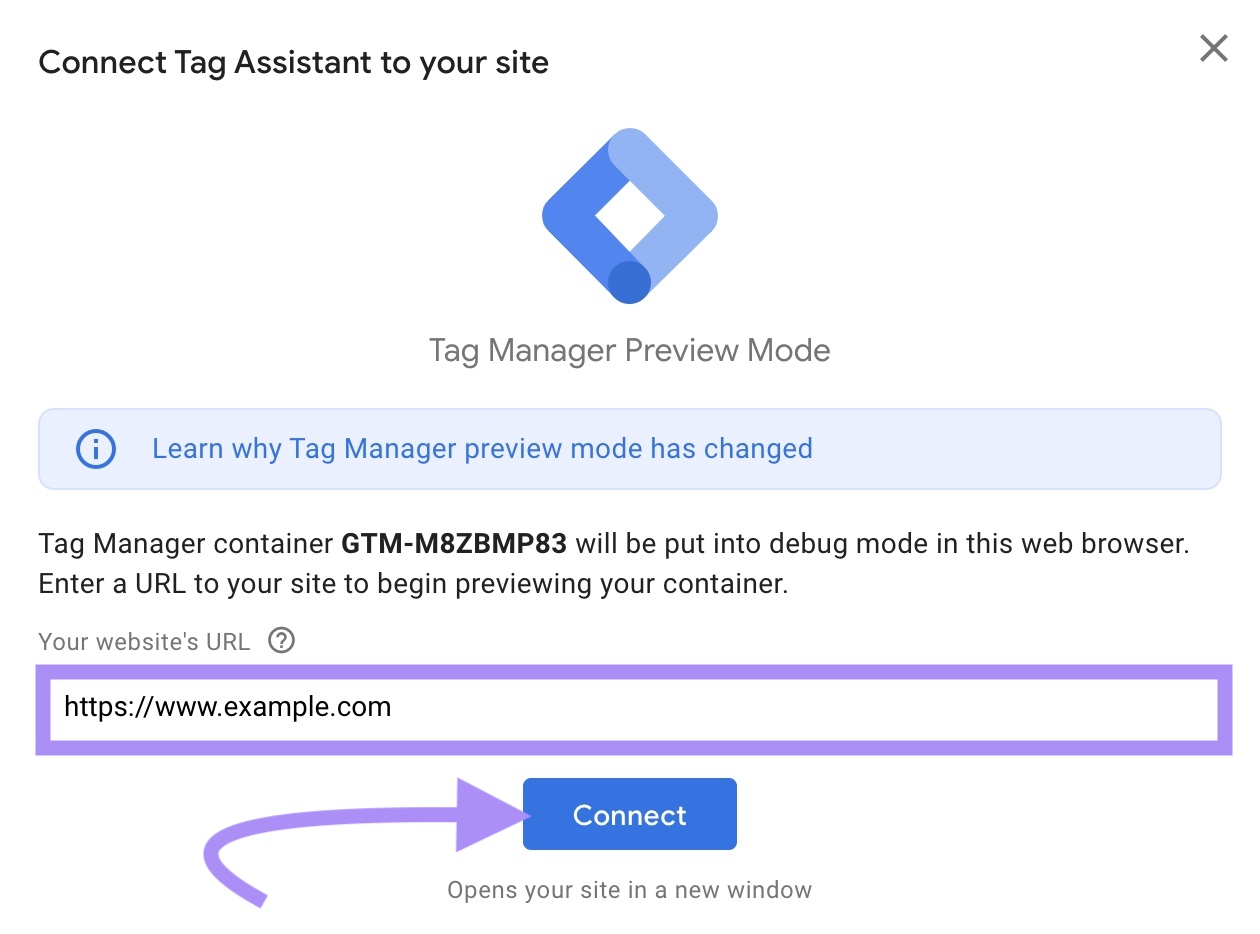
Your web site will load in a brand new window. Depart that window open and return to the Tag Assistant web page.
If Tag Assistant manages to hook up with your web site, a “Related!” window will seem. Click on “Proceed” to shut it.
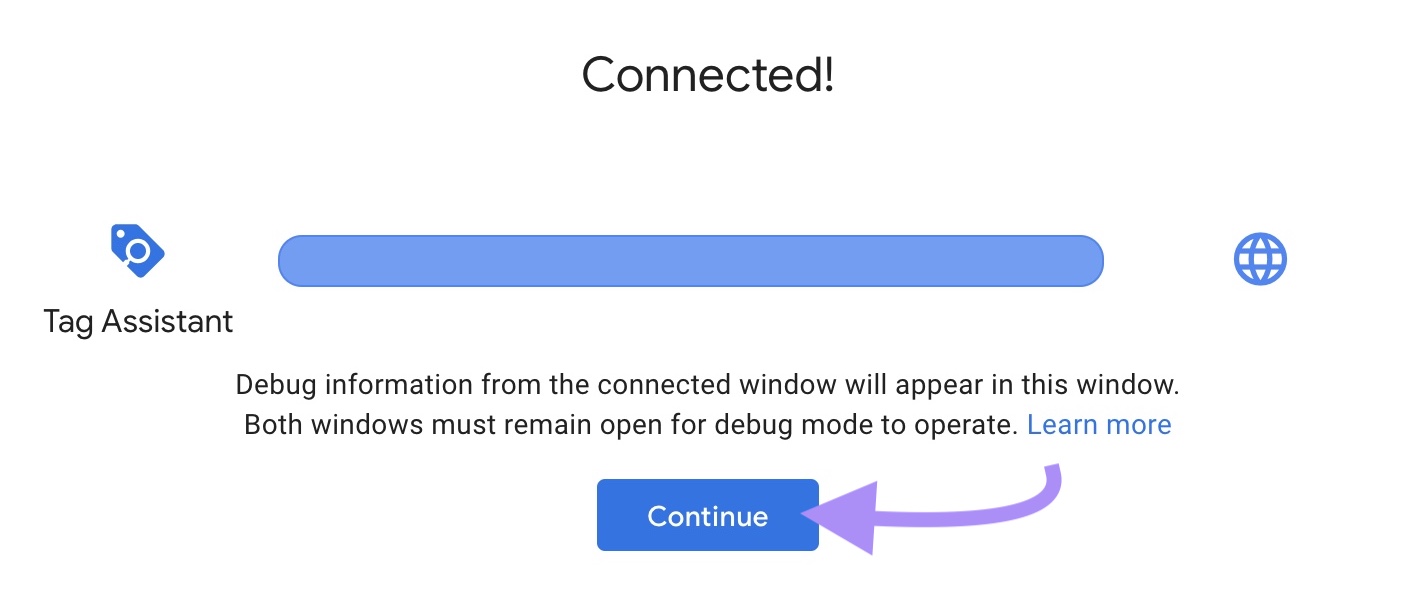
You will note your GA4 tag beneath the “Tags Fired” class of the “Output of [your measurement ID]” panel if GTM efficiently loaded it.
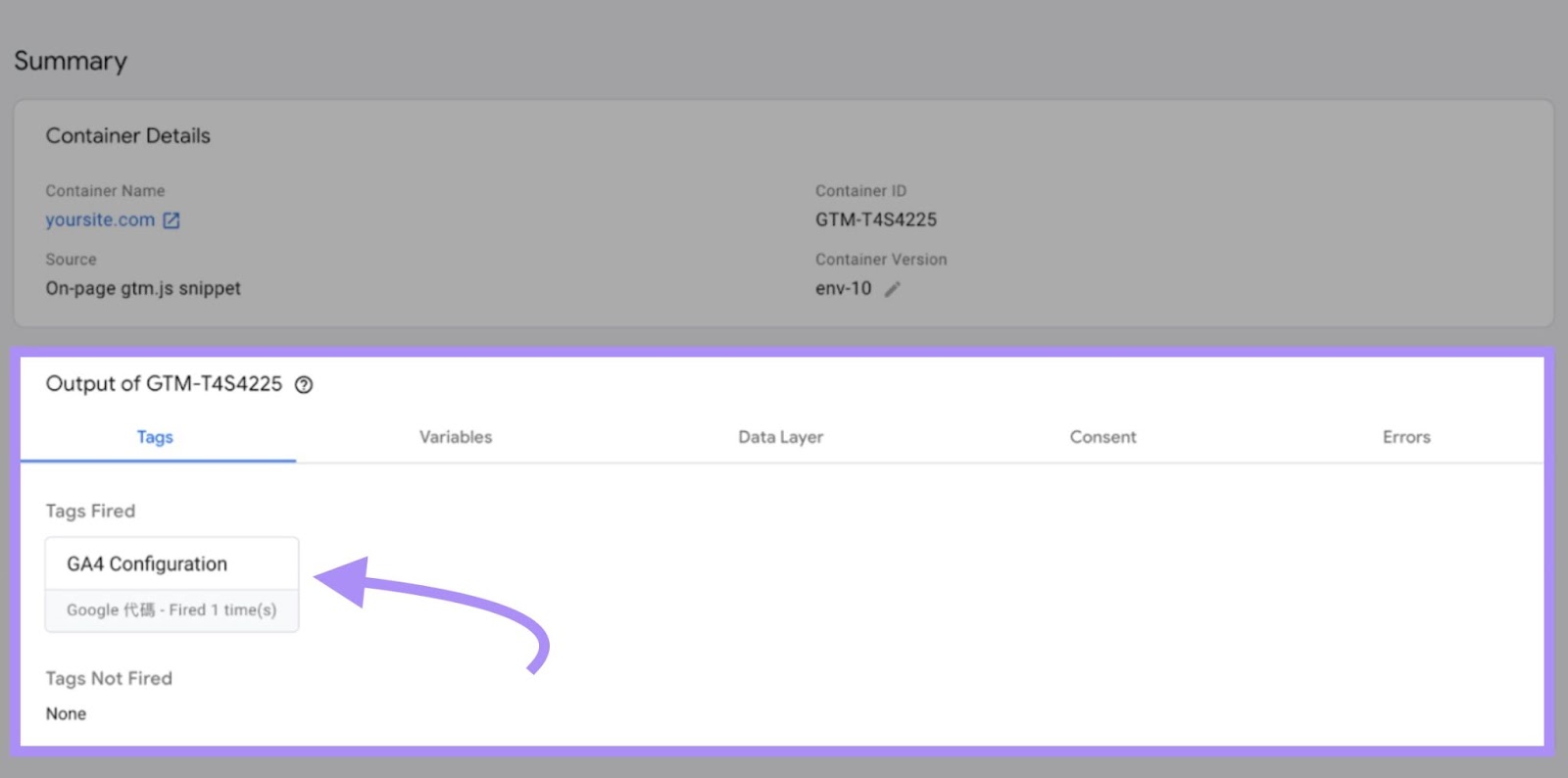
If that’s the case, shut Tag Assistant and your web site. Then, click on “Submit” in your container’s workspace overview to avoid wasting the adjustments to GTM.
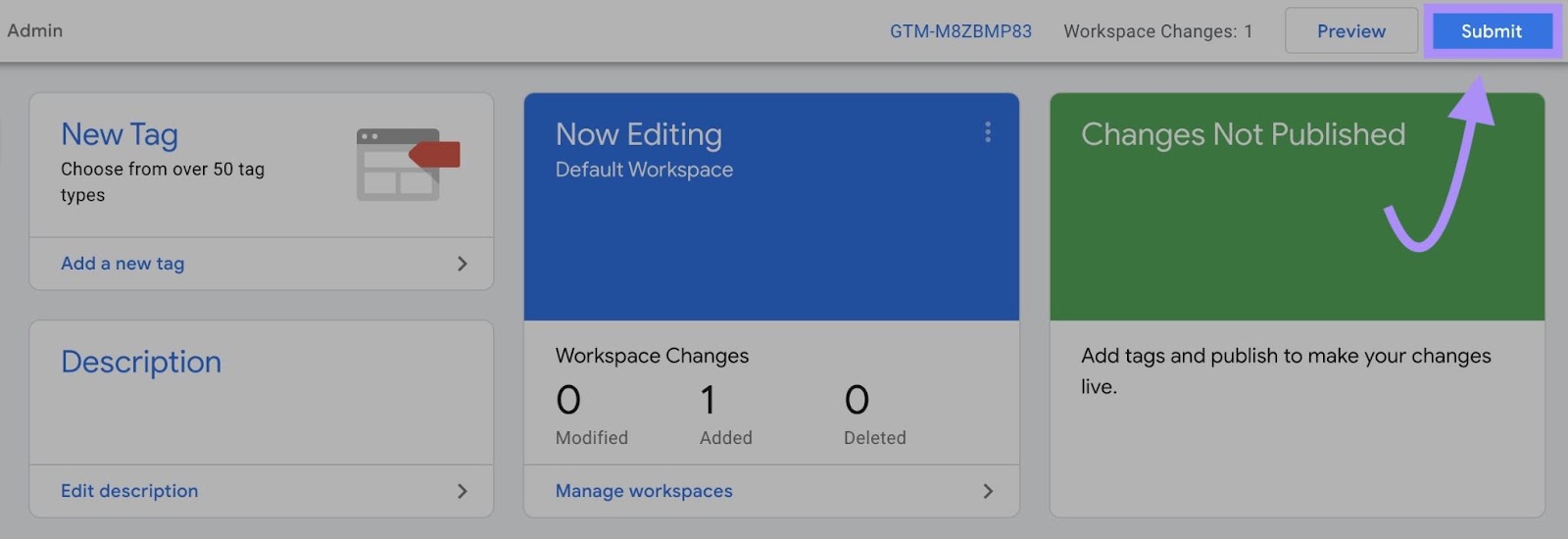
A “Submit Modifications” window will slide in.
Depart the “Submission Configuration” setting as “Publish and Create Model.” After that, use:
- The “Model Identify” subject to call the brand new model of your web site (e.g., “GA4 put in”)
- The “Model Description” subject to offer particulars of your adjustments
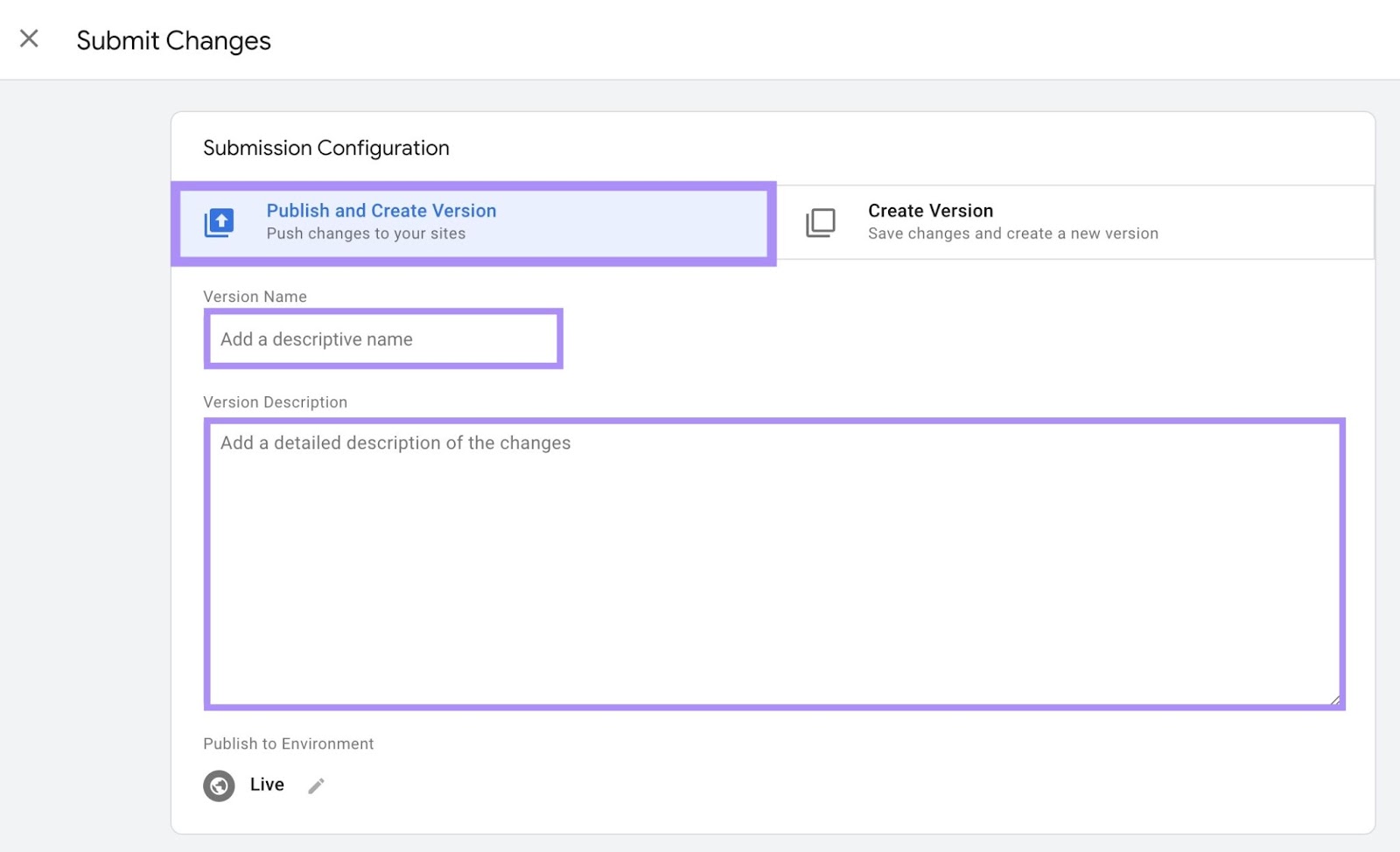
Lastly, click on “Publish” to make your adjustments to GTM reside. And activate your web site’s GA4 set up.
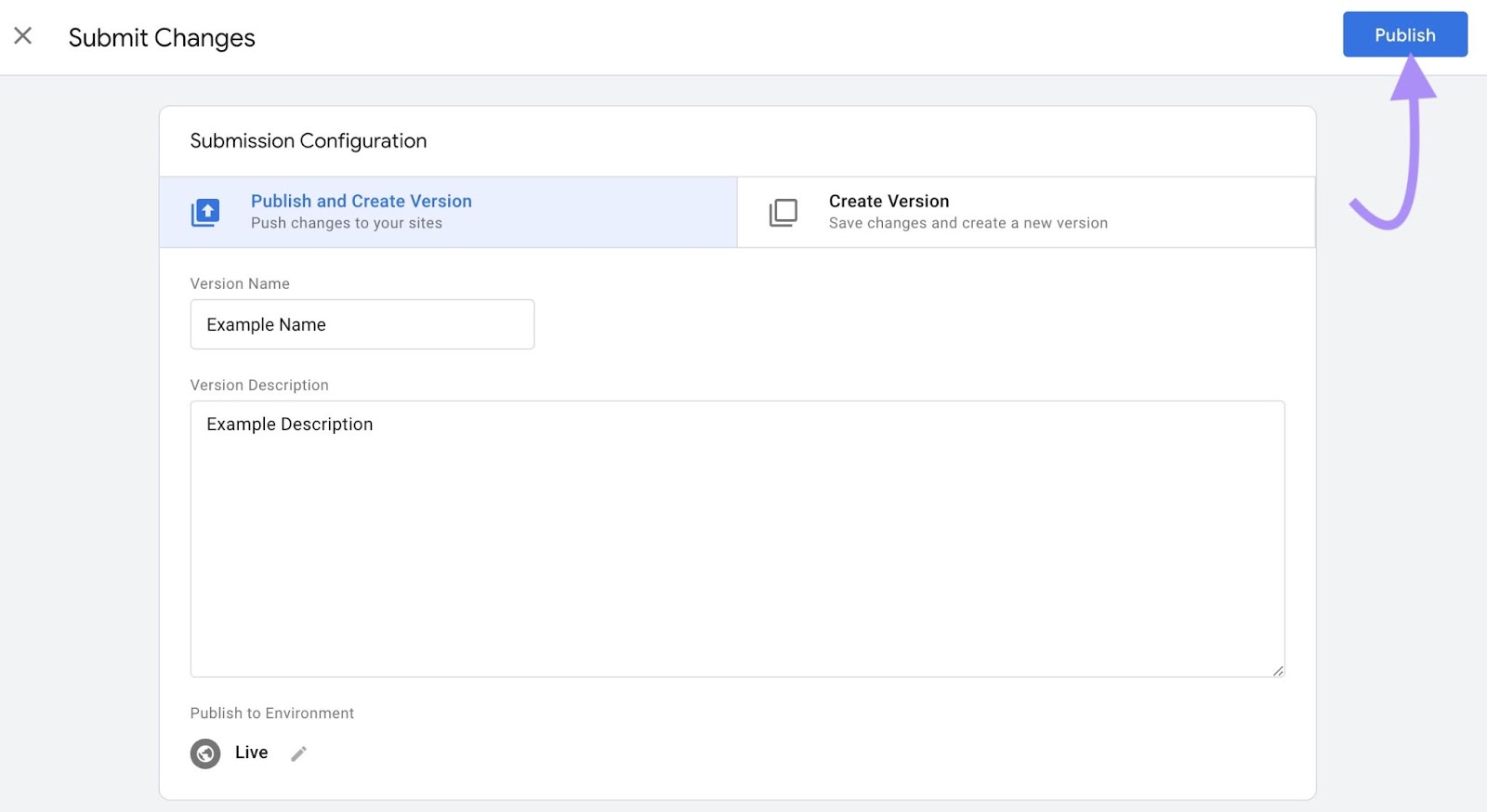
Technique 2: Set up GA4 Utilizing an Integration
Some web site builders, like Squarespace and Wix, provide native GA4 integration.
In different phrases:
They comprise built-in performance for connecting a web site created on their platform with GA4. You simply have to navigate to a sure setting and supply your GA4 property’s measurement ID.
These guides clarify the best way to set up GA4 utilizing the related web site builder’s native GA4 integration:
In distinction, the WordPress web site builder doesn’t natively combine with GA4. As a substitute, use a third-party WordPress plugin to put in GA4 on a WordPress web site. There are numerous such plugins on the market.
We’ll display the method utilizing Google’s Site Kit plugin.
Log in to your WordPress admin dashboard and go to “Plugins” > “Add New Plugin” within the left sidebar.

On the “Add Plugins” web page, kind “web site equipment” into the search subject.
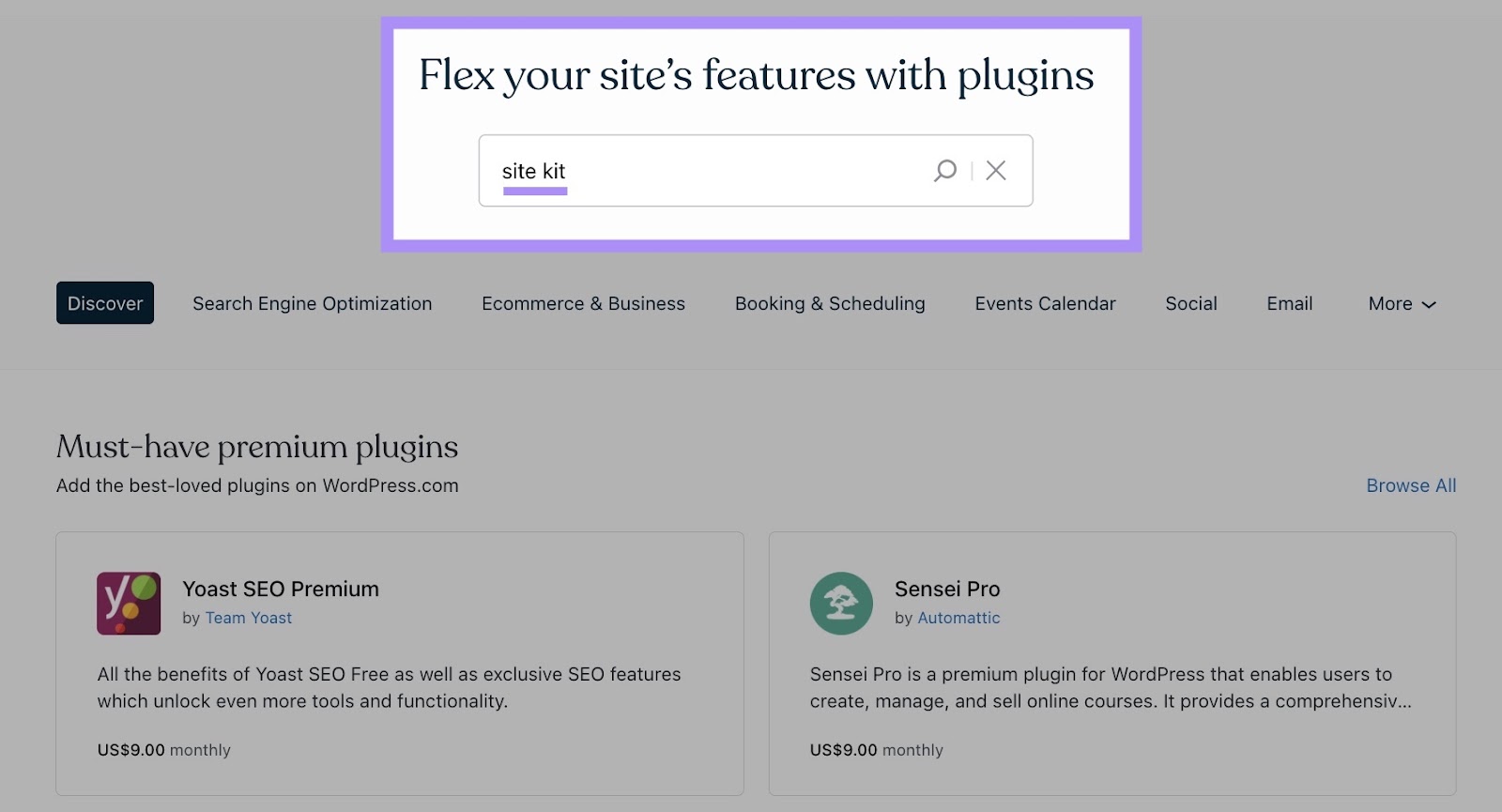
Then, hit “Enter” or “return” in your keyboard to run the search.
Search for the plugin titled “Web site Equipment by Google – Analytics, Search Console, AdSense, Velocity.” Click on the “Set up Now” button to put in the plugin in your web site.
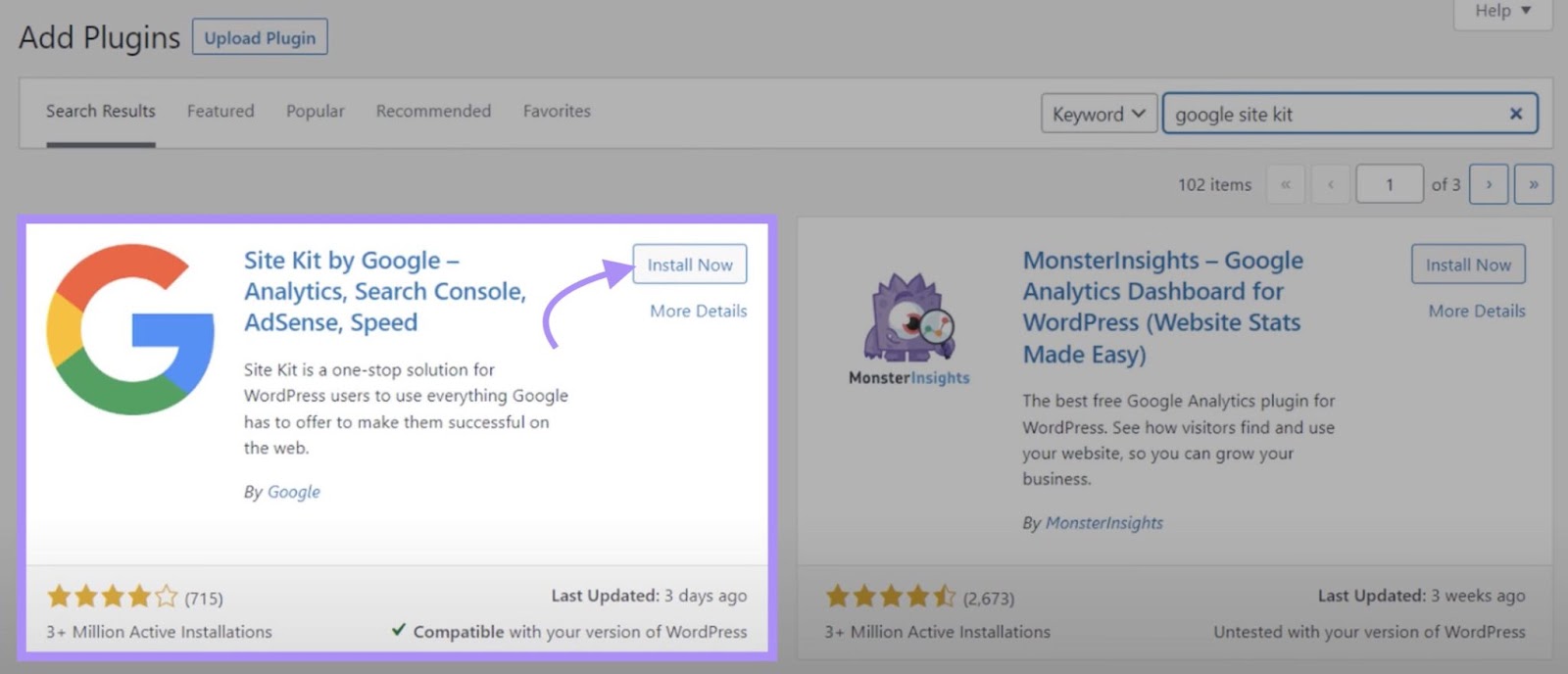
After that, click on “Activate” to activate Web site Equipment.
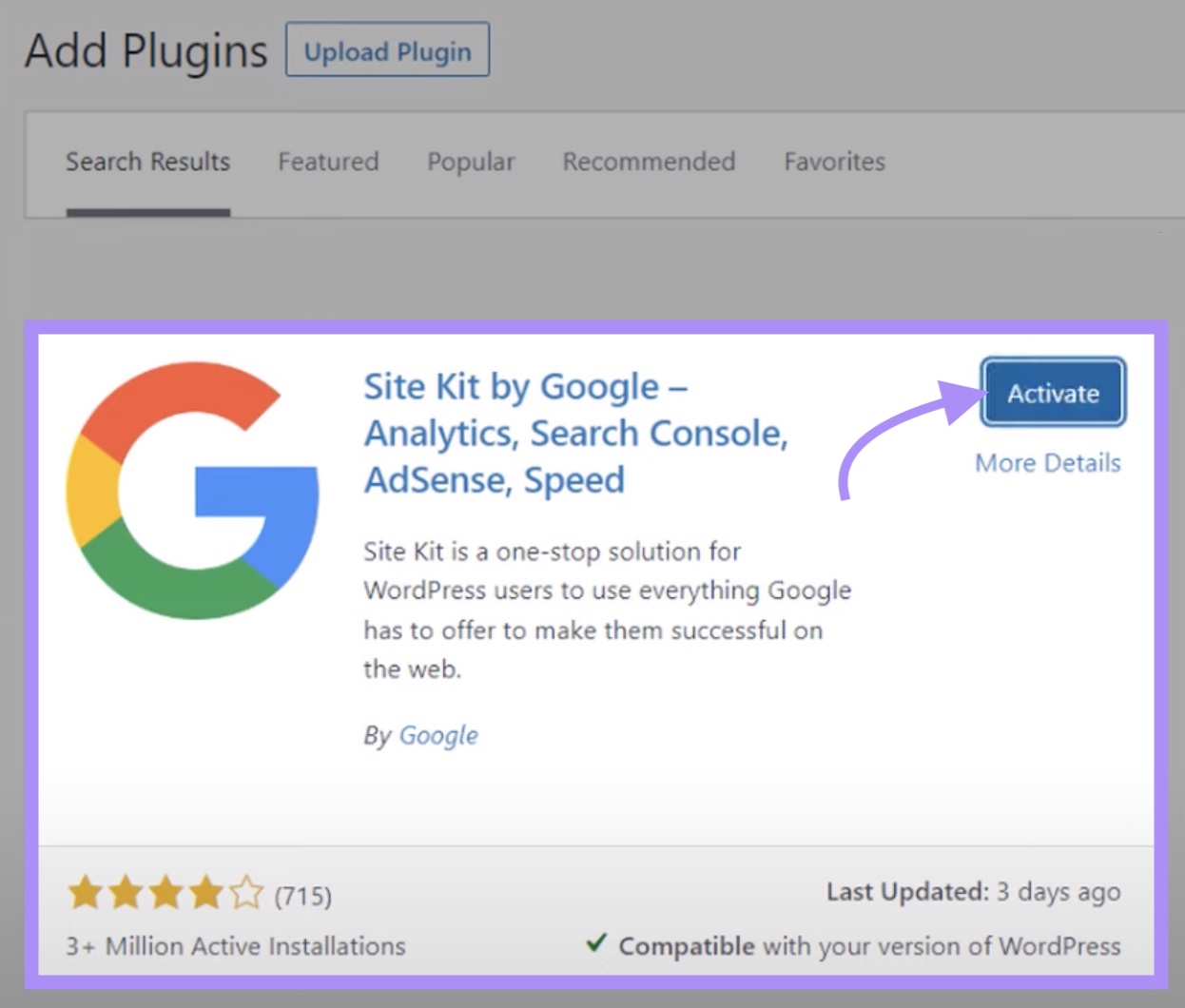
You will note a hit message confirming Web site Equipment’s activation. Click on “Begin setup” to start setting it up.

The setup display will present a checkbox stating “Join Google Analytics as a part of your setup.” Verify this field, then click on “Sign up with Google.”
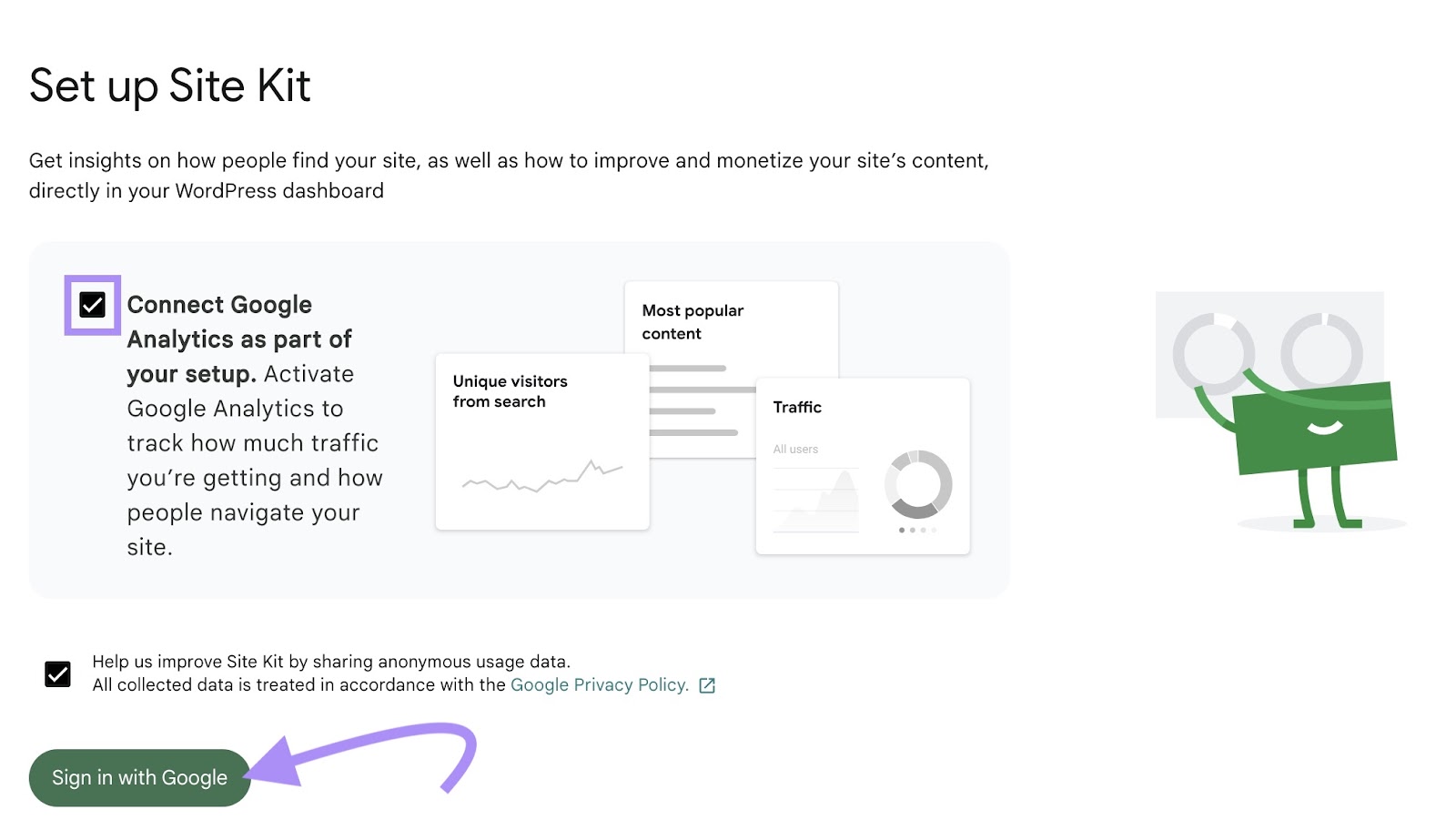
Sign up to your Google account on the login display that seems. And proceed by means of the following few screens for granting Web site Equipment entry to your Google account.
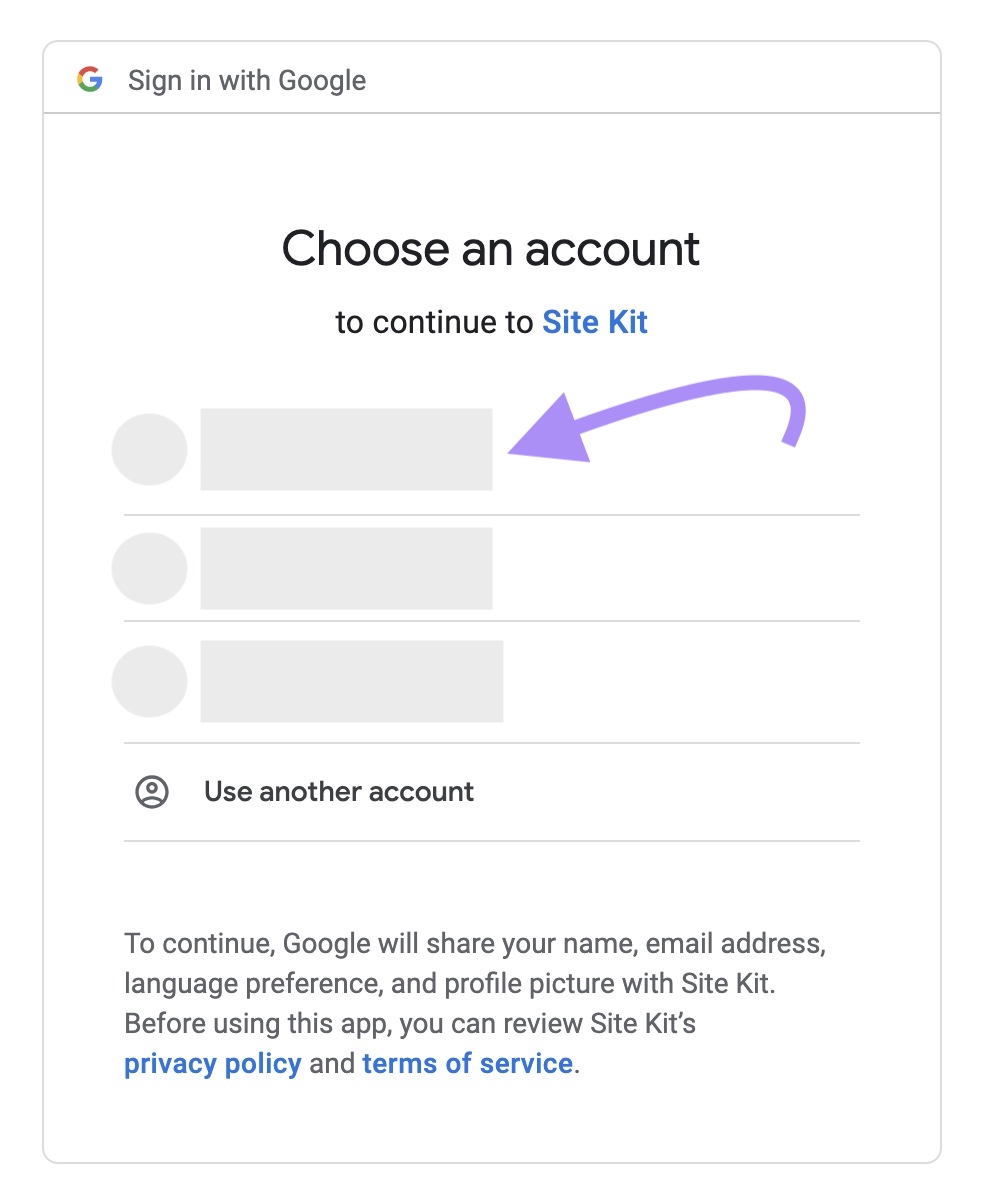
Web site Equipment will then stroll you thru these three steps:
- Verifying your possession of your web site
- Turning on metrics in your Web site Equipment dashboard
- Establishing Google Search Console (GSC)
Whenever you’ve completed doing these, you’ll see a display titled “Arrange Google Analytics.” Click on the “Subsequent” button on this display to put in GA4 in your web site.

On the “Join Service” display that masses, use the “Account,” “Property,” and “Internet Information Stream” drop-down menus to pick out the GA4 account, property, and data stream you arrange earlier.
Then, click on “Configure Analytics.”
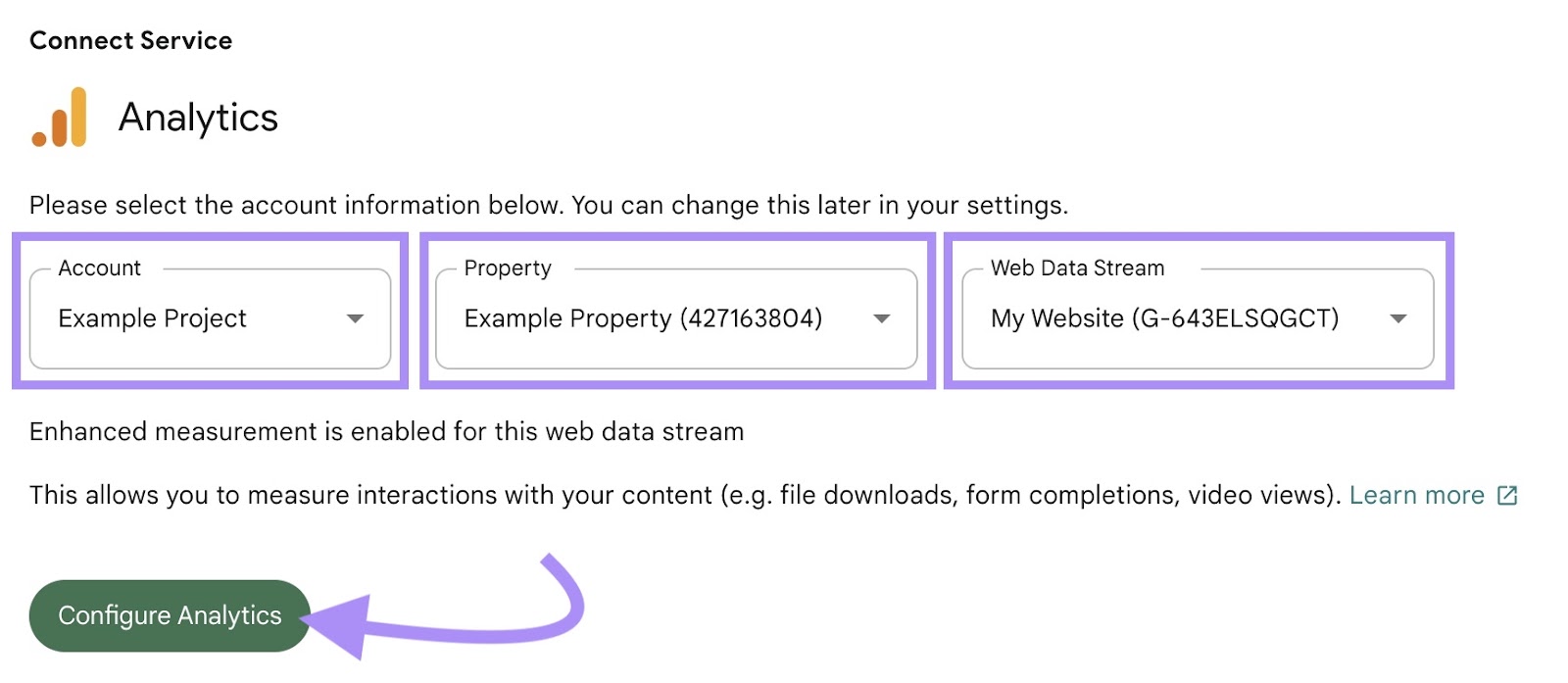
A hit message will seem to verify GA4’s set up in your web site.

Technique 3: Set up GA4 Manually
To put in GA4 manually, go to the “Internet stream particulars” window in your web site’s knowledge stream in GA4. Navigate to it by clicking “Admin” within the left sidebar:
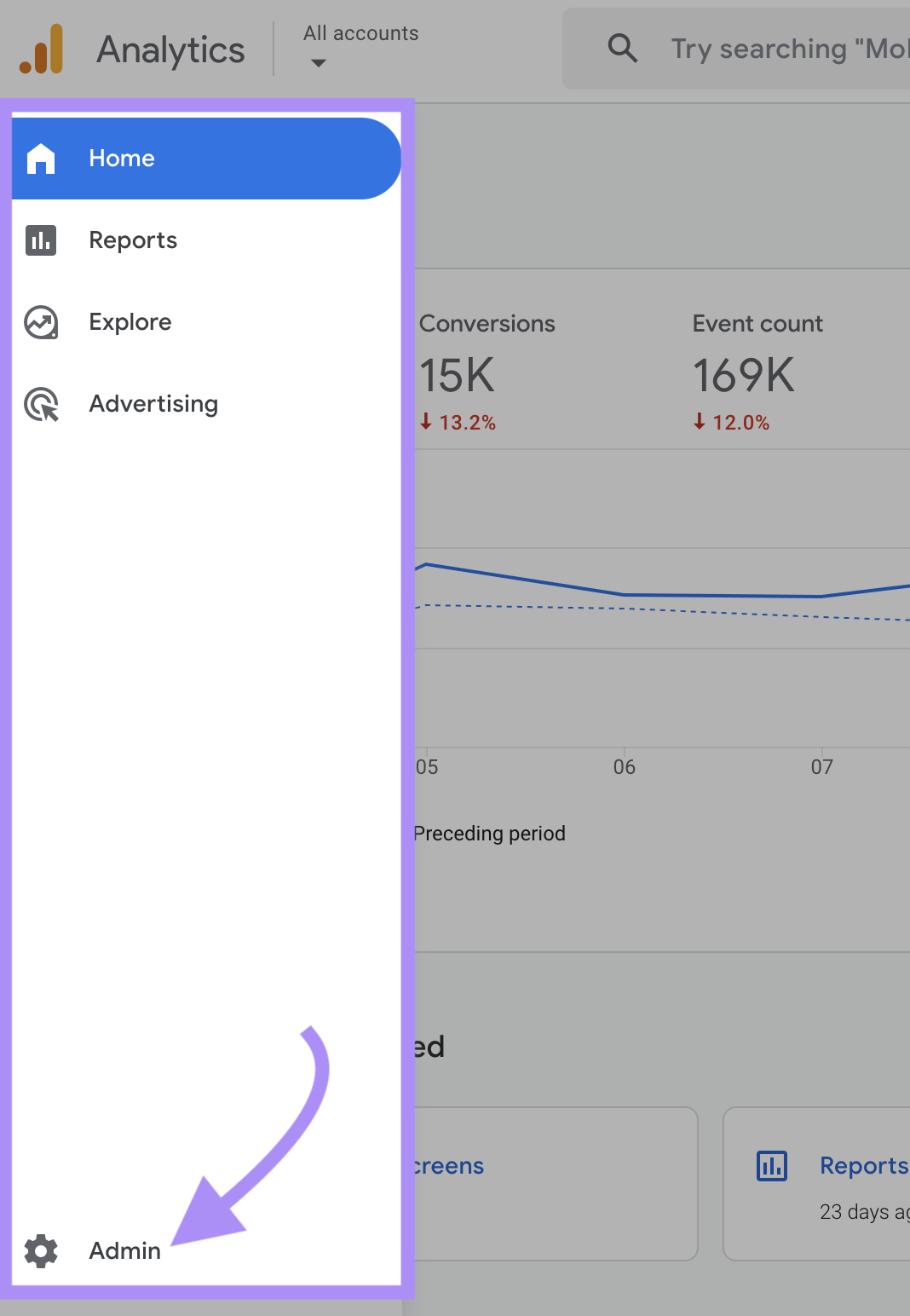
Then, beneath “Property settings,” choose “Information assortment and modification” > “Information streams.”
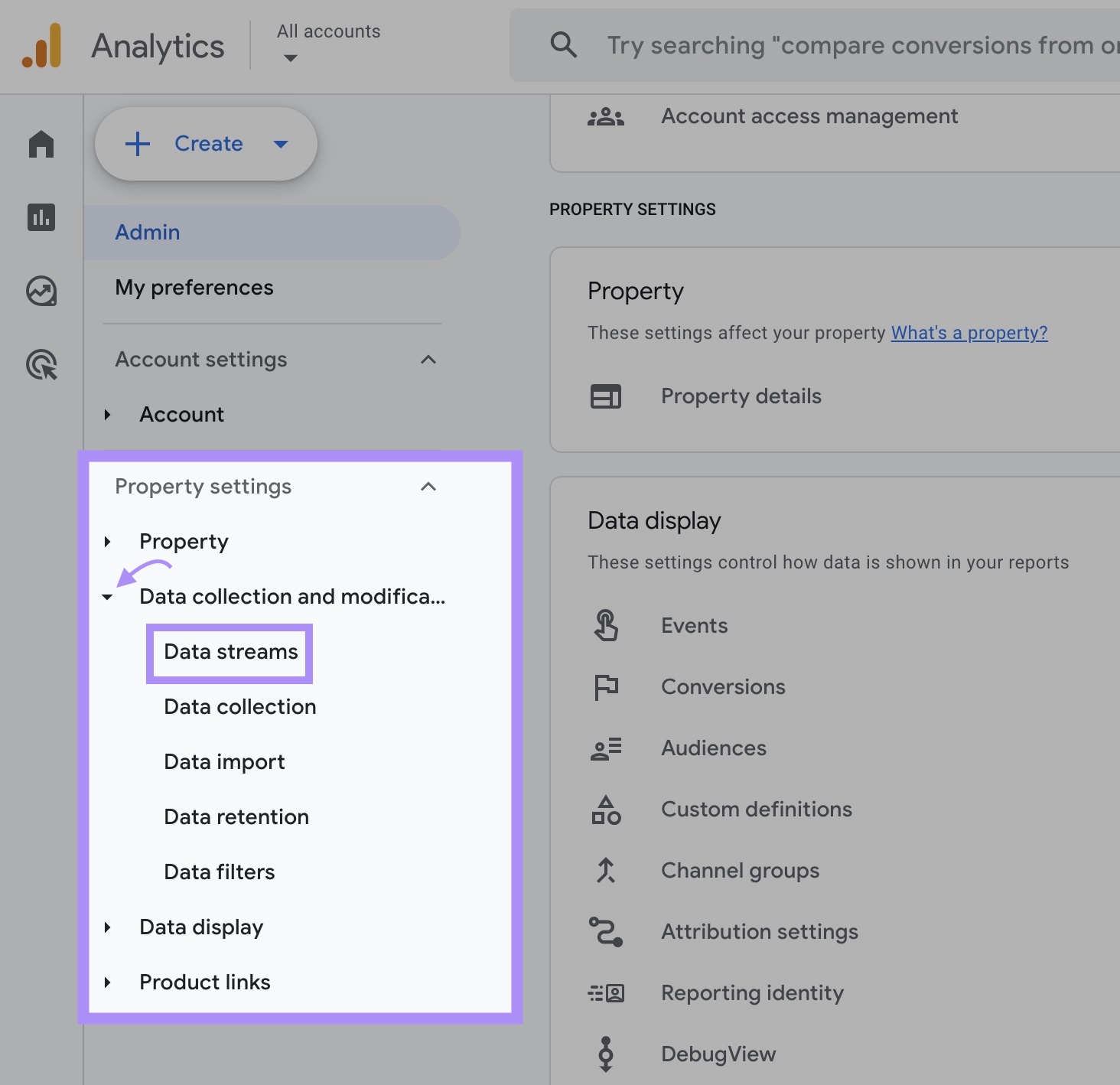
Click on the info stream in your web site on the “Information streams” web page that seems.

When the “Internet stream particulars” window slides in, scroll down and choose “View tag directions.”

Then, click on “Set up manually.”
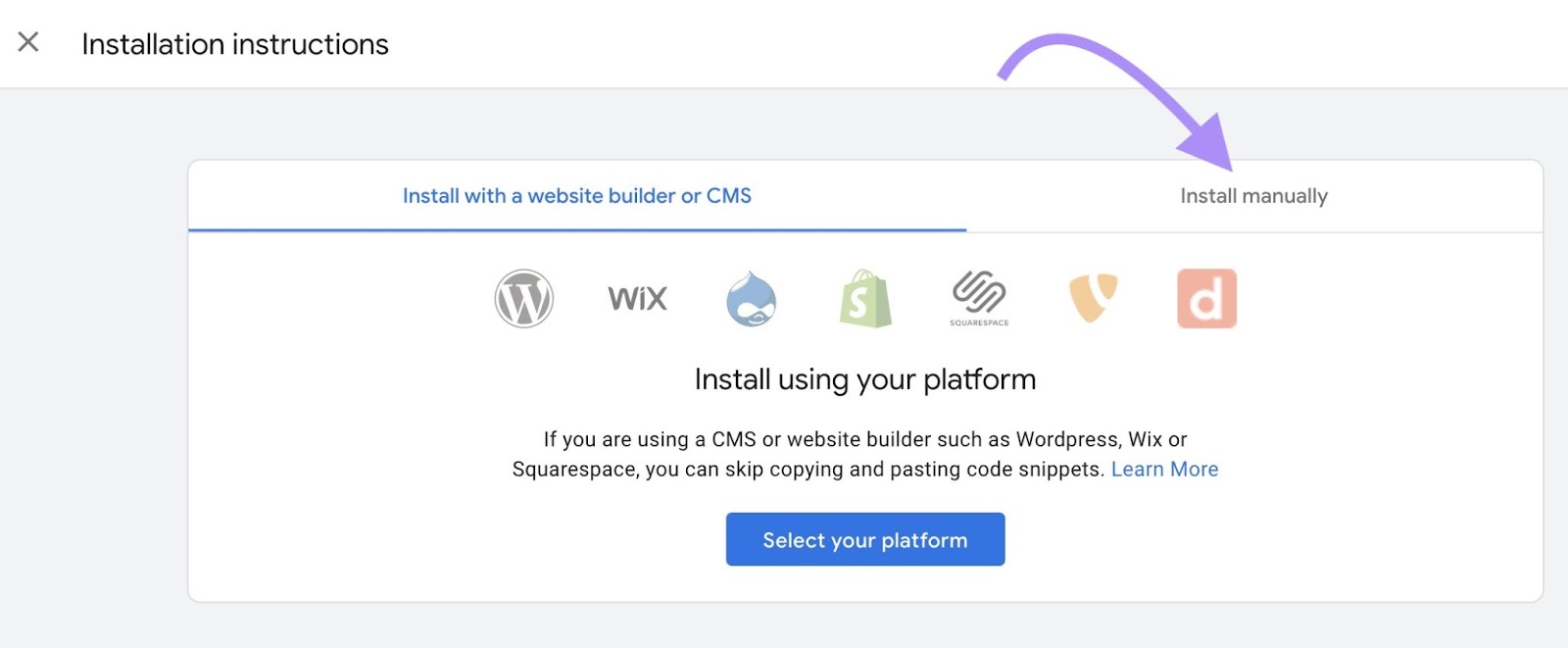
A code snippet will seem on the web page. Use the clipboard icon to repeat it.
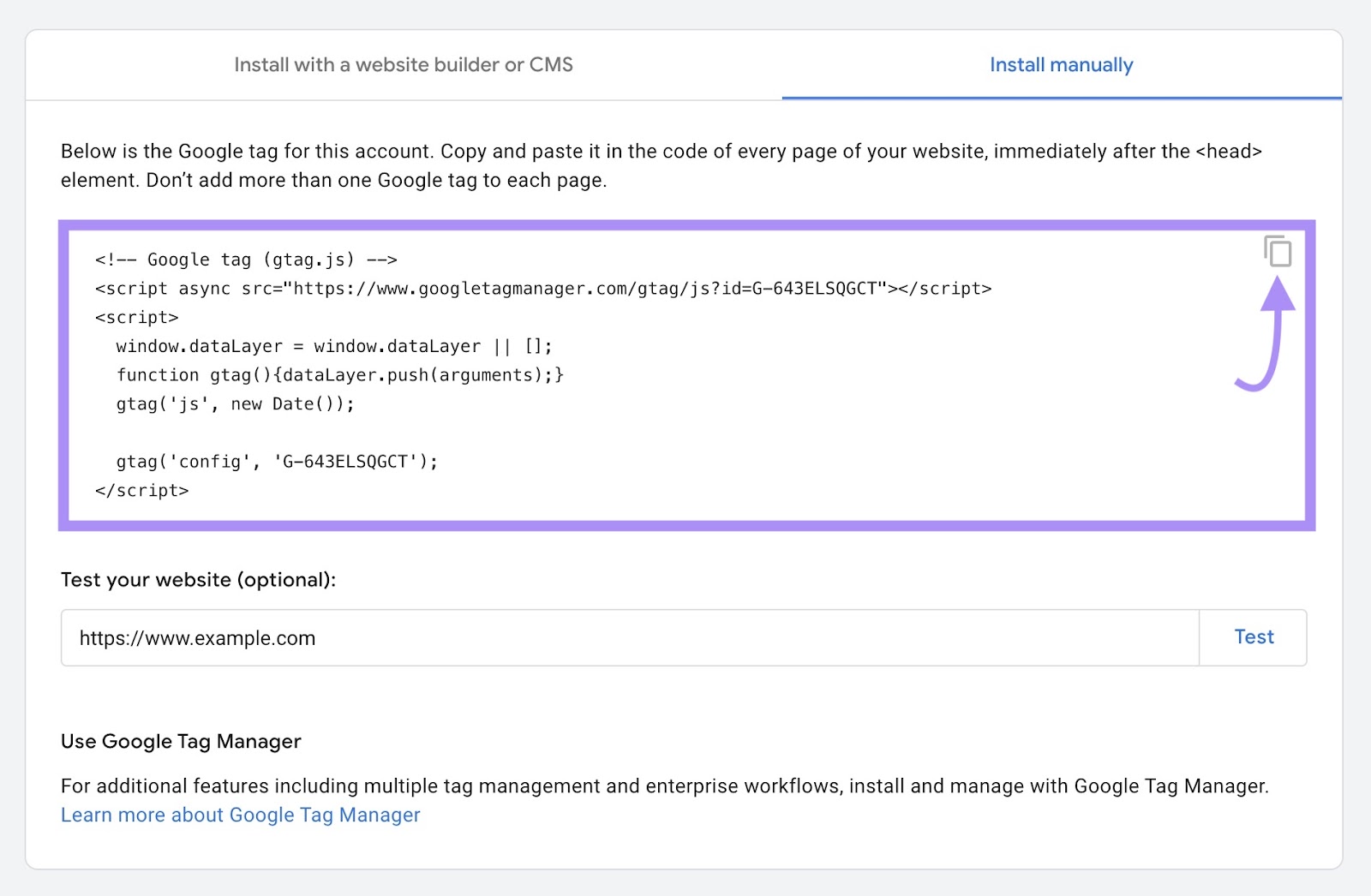
Then, paste the code snippet into the Hypertext Markup Language (HTML) for each web page of your web site instantly after the web page’s <head> tag.
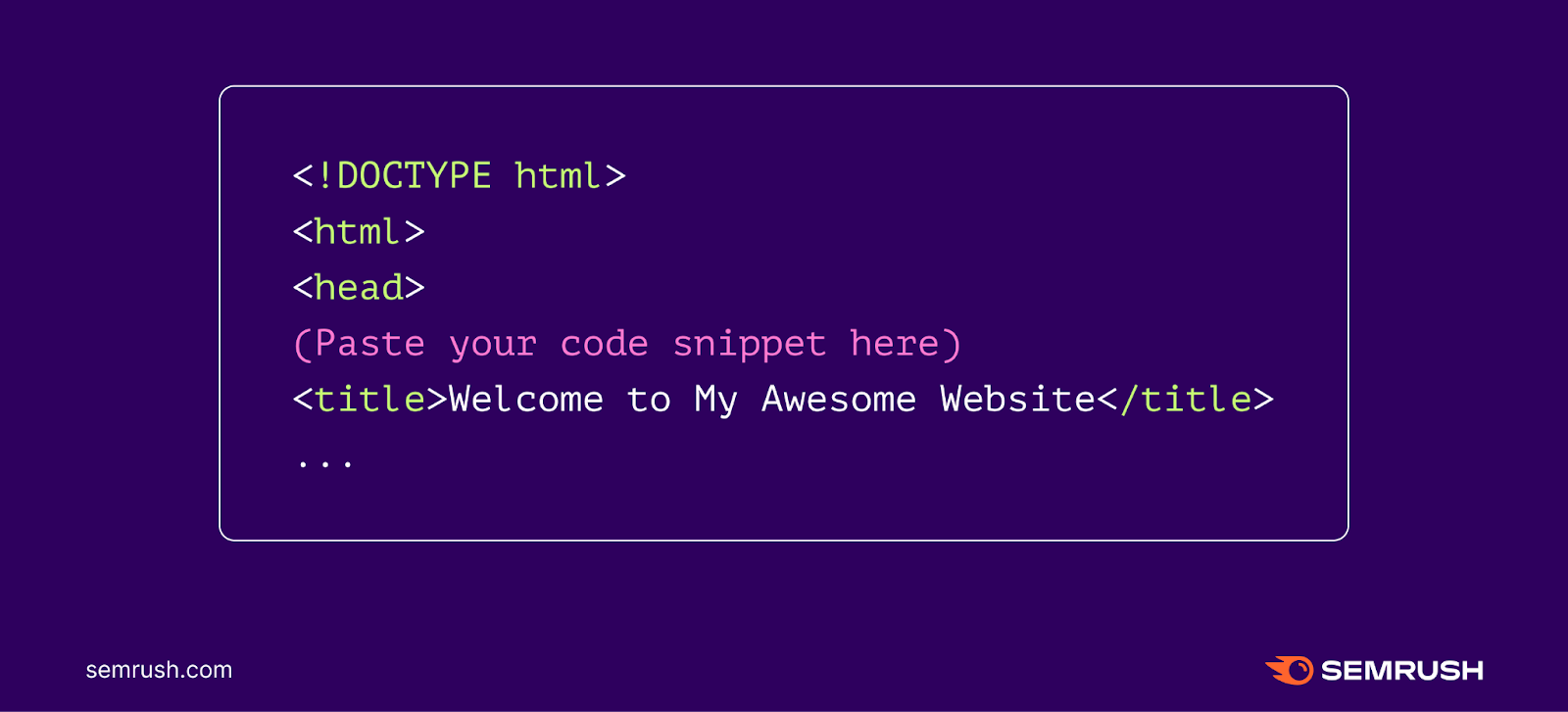
Save your adjustments.
Learn how to Observe Occasions with GA4
In UA, “occasions” broadly refer solely to customers’ interactions with content material, excluding the loading of pages. However GA4 considers all interactions or occurrences in your web site (or app) to be “occasions.”
Examples of GA4 occasions are:
- The loading of a web page
- A consumer’s first go to to a web site
- A consumer’s submission of a kind
- The including of an merchandise to a procuring cart
To trace occasions in GA4, click on “Studies” in GA4’s left sidebar.
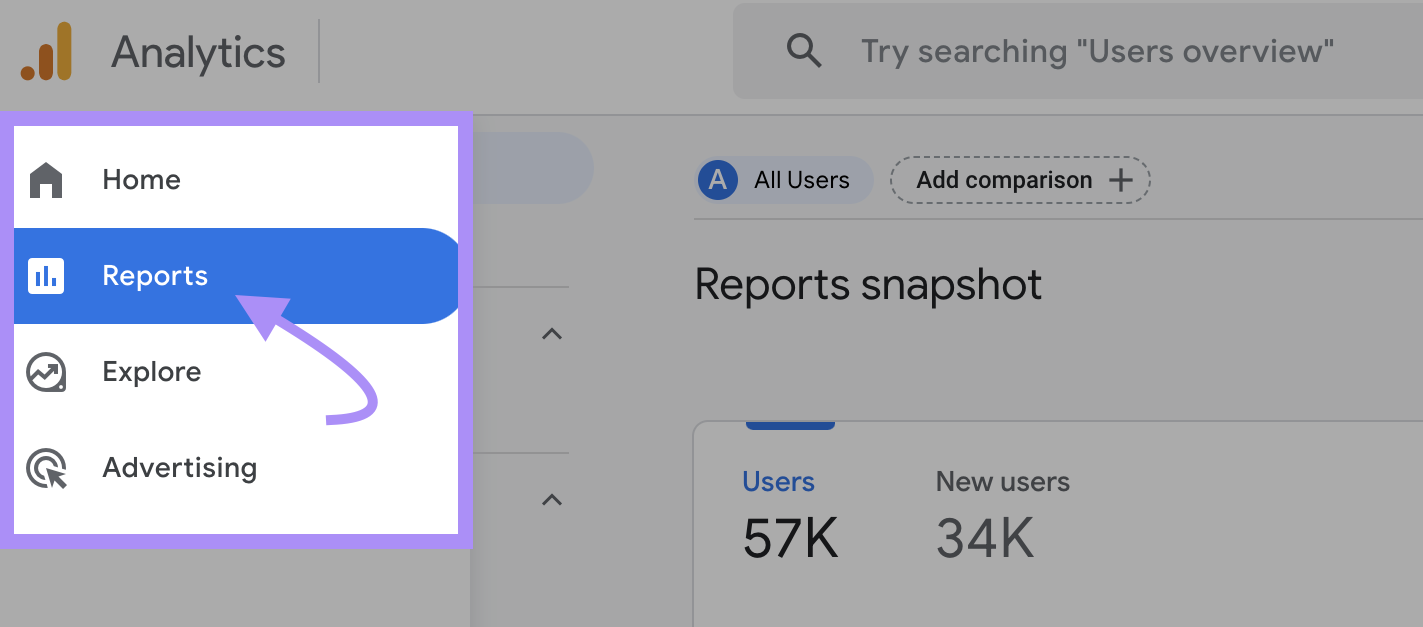
Then, click on “Engagement” > “Occasions.”
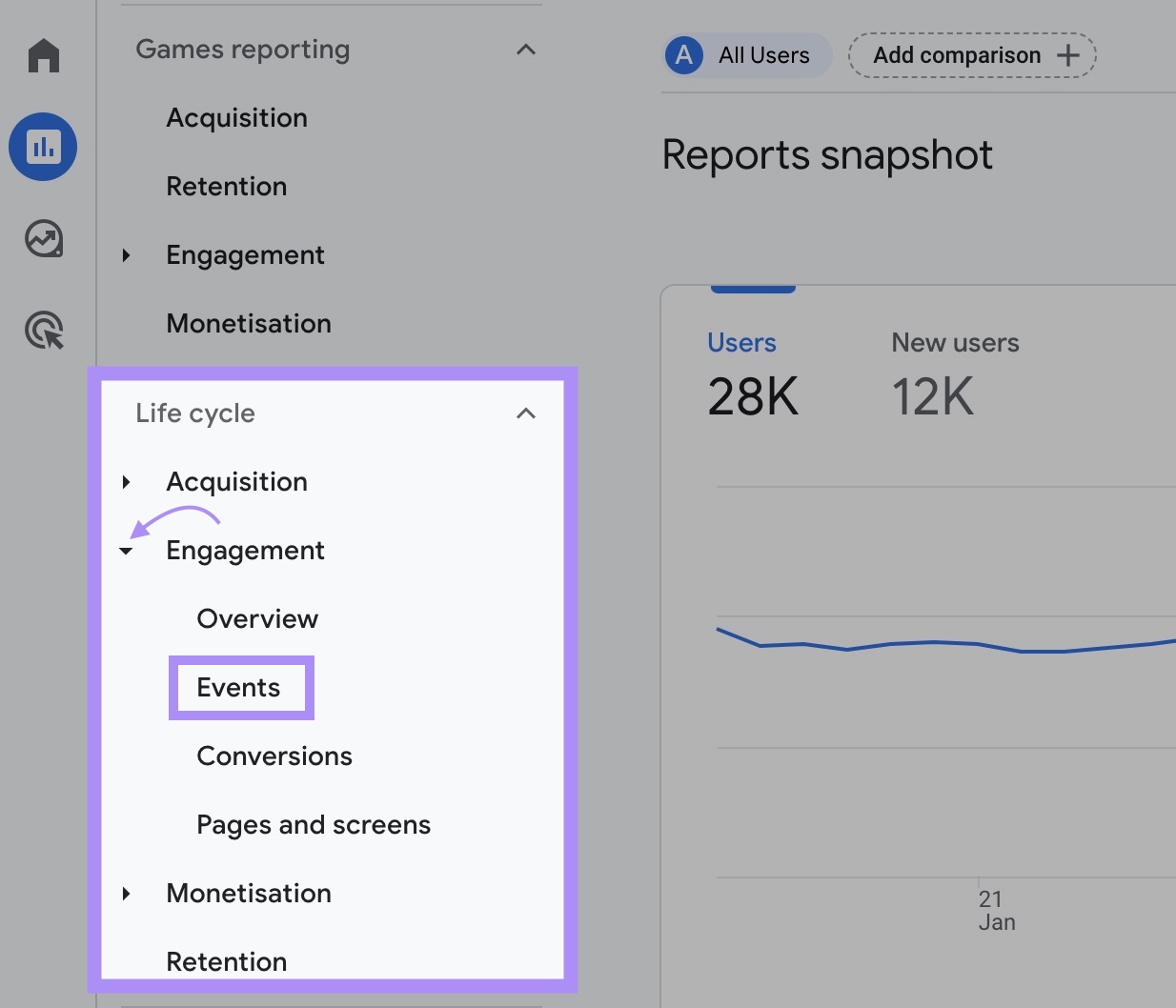
You’re going to get an inventory of the occasions GA4 has detected in your web site over a specified date vary.
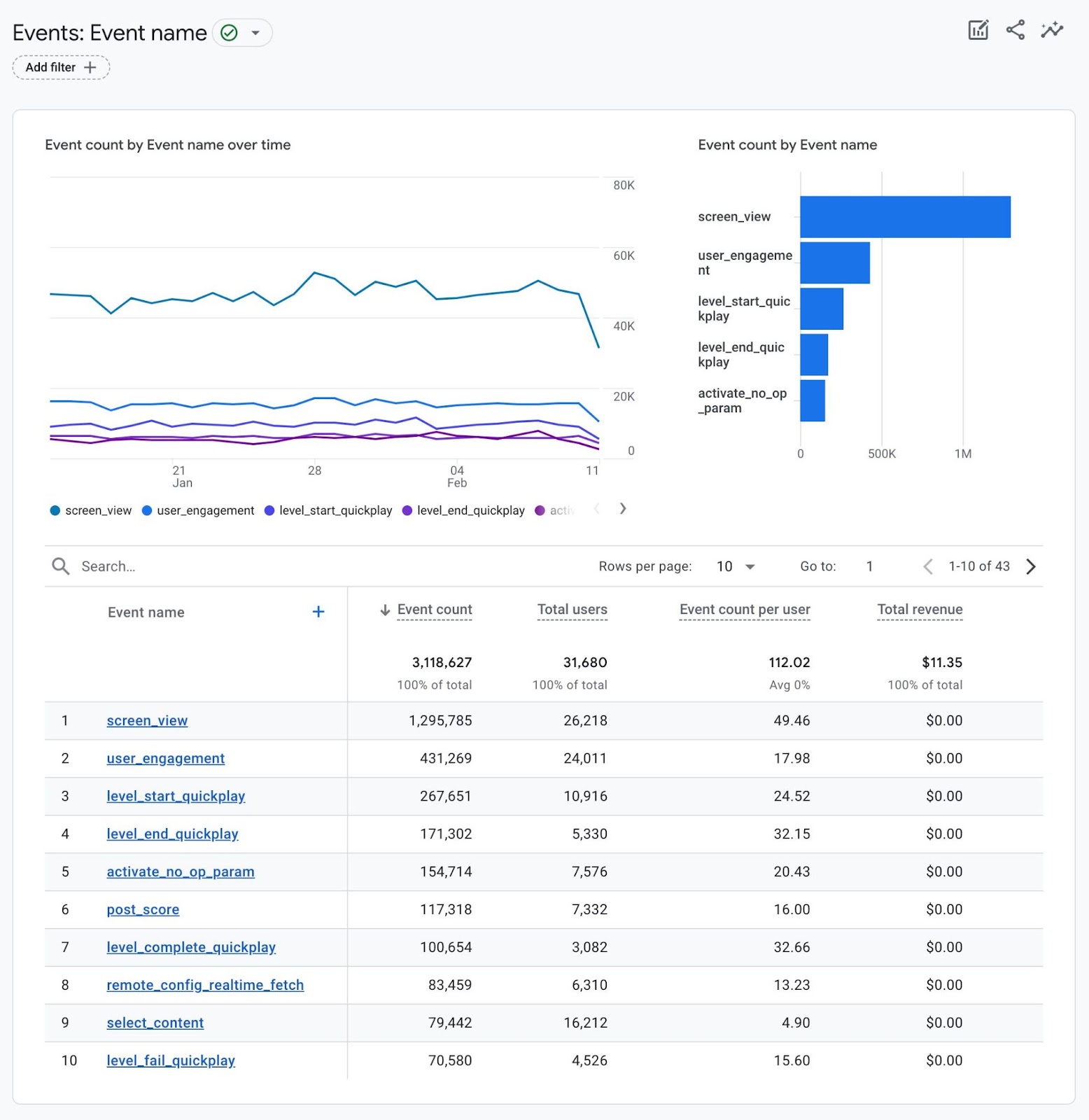
For every occasion, you possibly can view metrics like:
- Occasion depend: The variety of instances customers have triggered the occasion
- Whole customers: The variety of distinctive customers who’ve triggered the occasion
- Occasion depend per consumer: The common variety of instances every consumer has triggered the occasion
- Whole income: The full income the occasion has generated
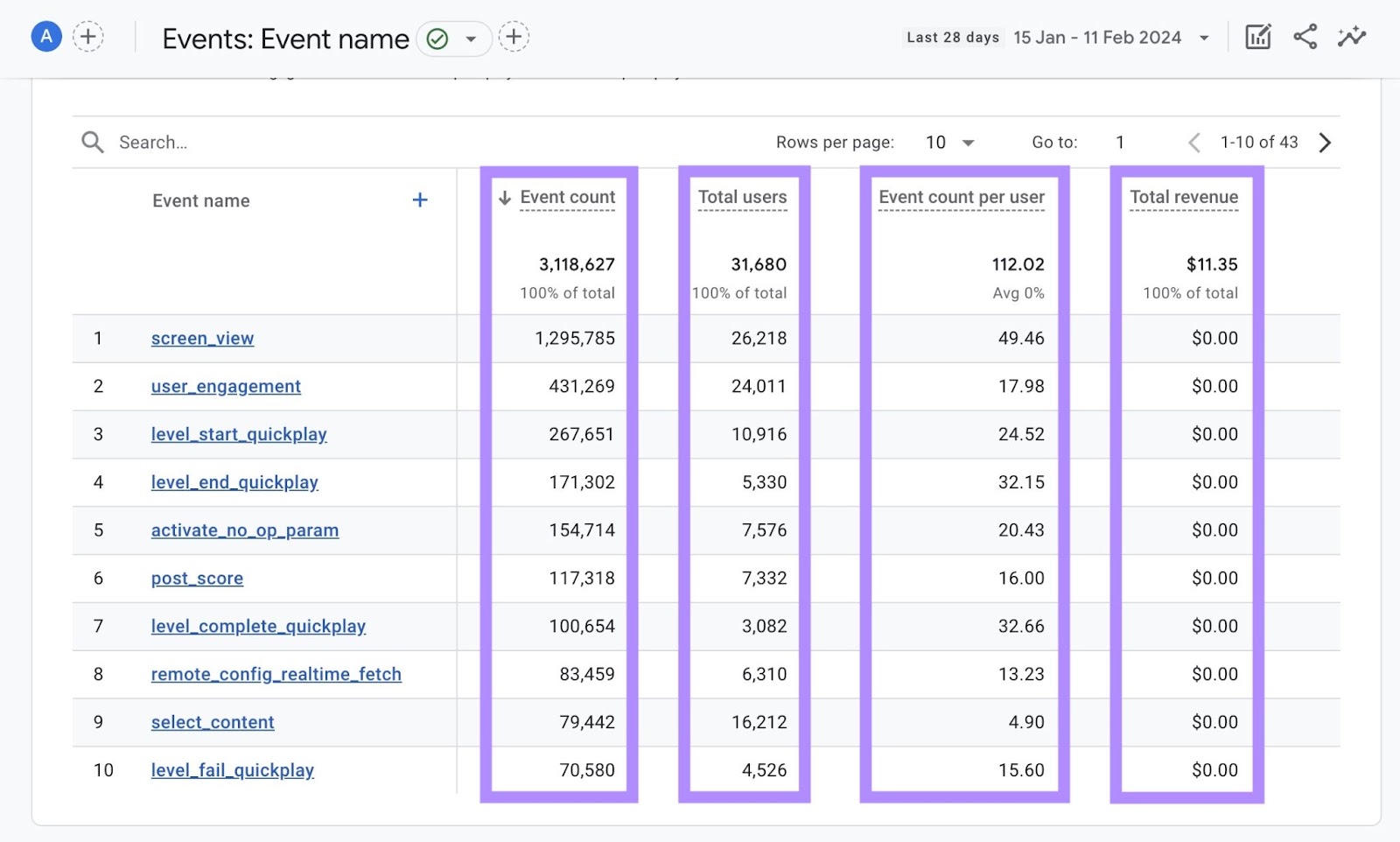
Click on the date vary setting on the prime to vary the timeframe for which the report ought to show occasion knowledge.
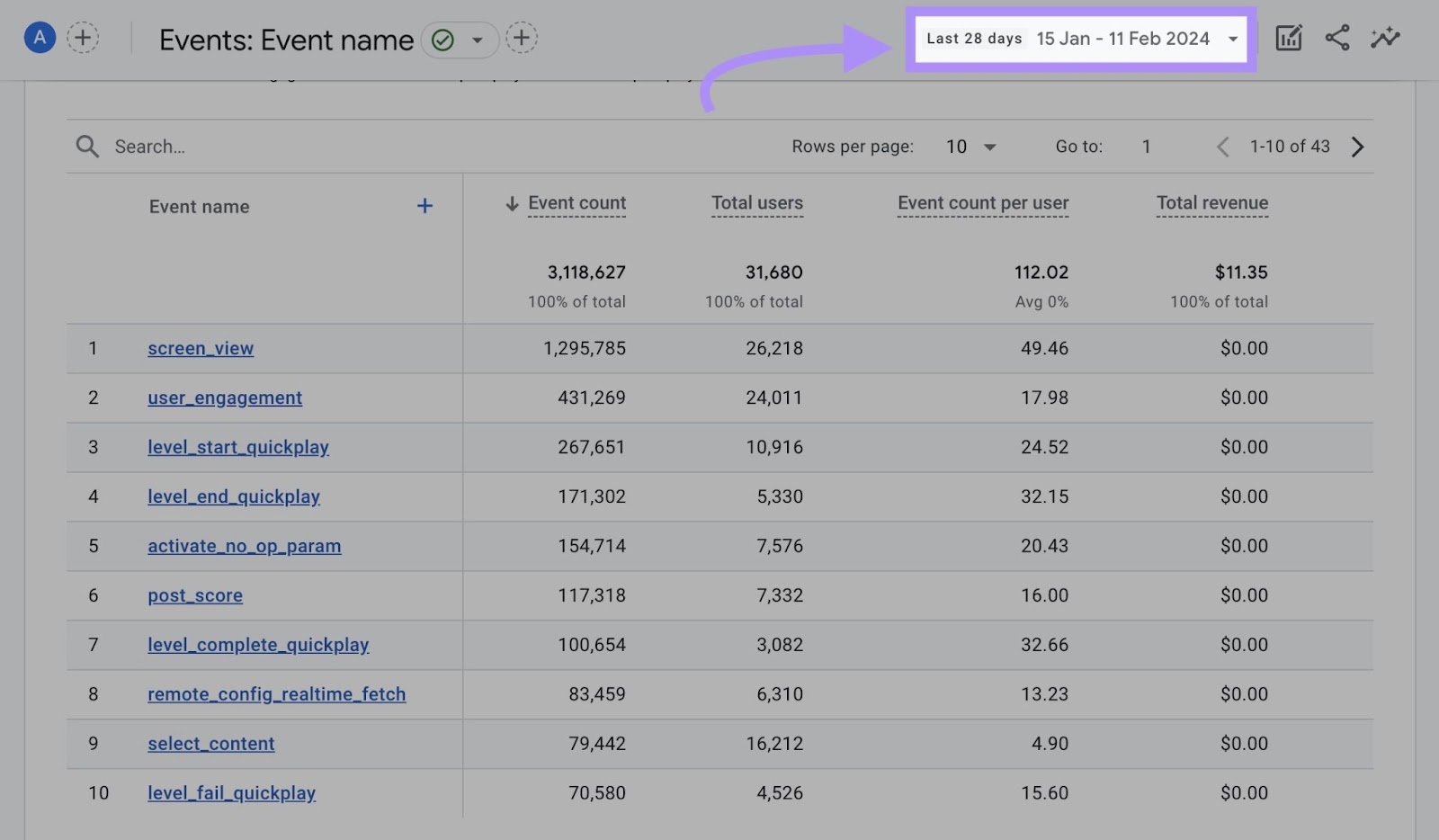
Click on any occasion within the report back to get event-specific metrics like:
- Occasion depend by nation
- Occasion depend by gender
- Occasions per session
For instance, right here’s the report for the user_engagement occasion.
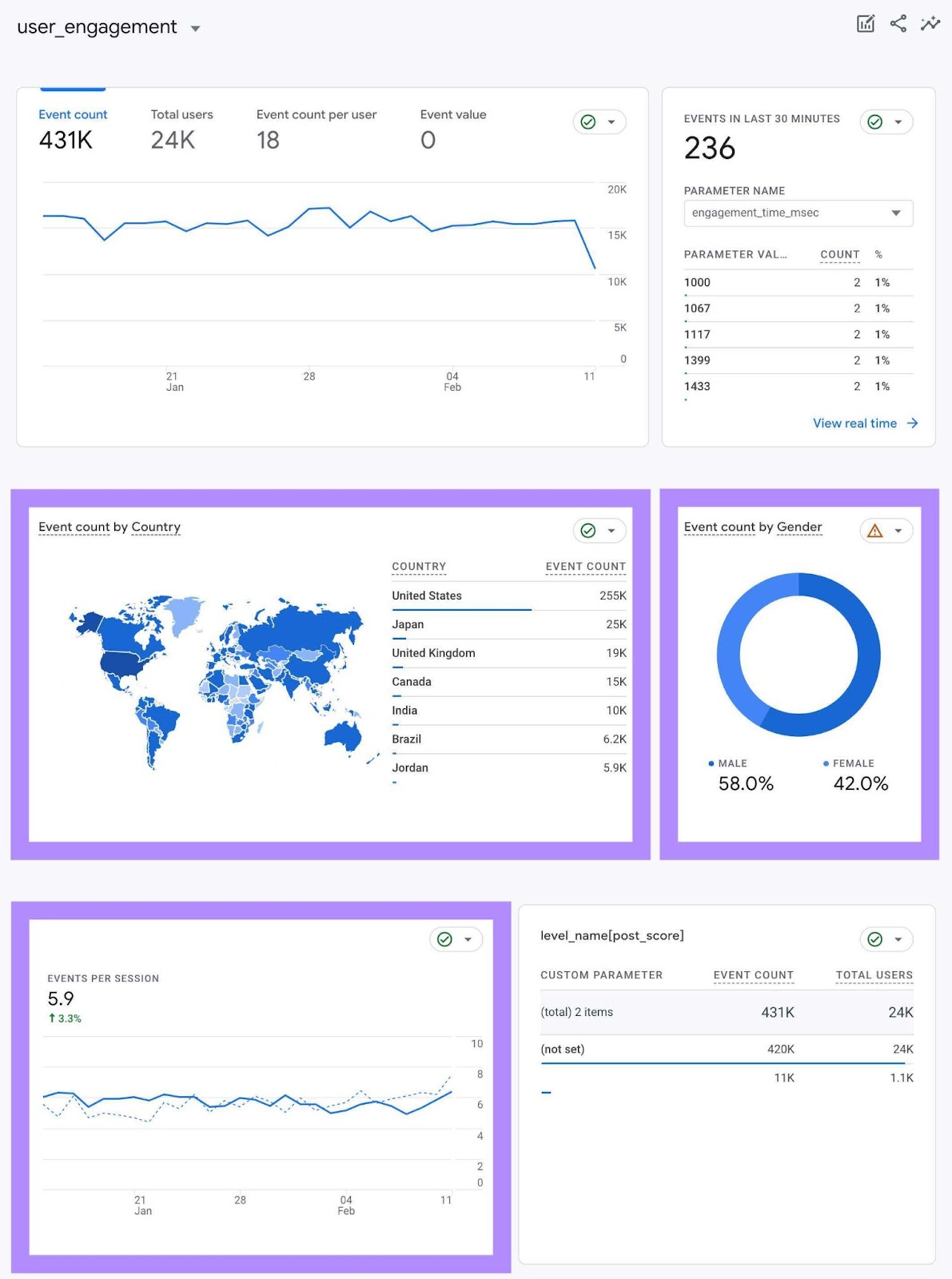
It’s additionally doable to create an “Exploration,” or superior customized report, of particular GA4 occasions. Be taught extra on this information:
Additional studying: How to Create a Custom GA4 Events Exploration
Learn how to Observe Conversions with GA4
A conversion is a GA4 occasion that fulfills a enterprise goal. Examples of conversions are:
- The filling out of a product demonstration reserving kind
- The inserting of an order
- The downloading of a file in your web site
GA4 doesn’t present default conversion occasions. So, set them up yourself to match your online business objectives.
When you’ve arrange your conversion occasions, GA4 will report them as they happen.
Discover GA4’s Conversions report by clicking “Studies” in GA4’s left sidebar.
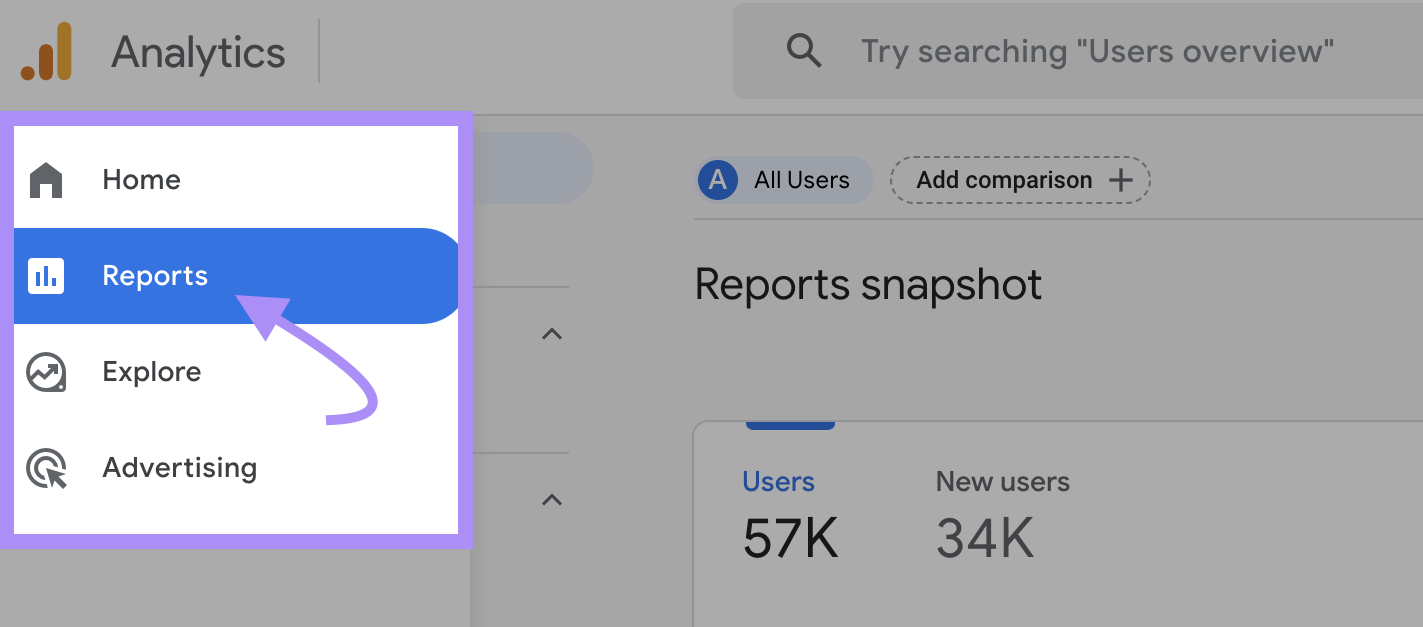
Then, click on “Engagement” > “Conversions.”
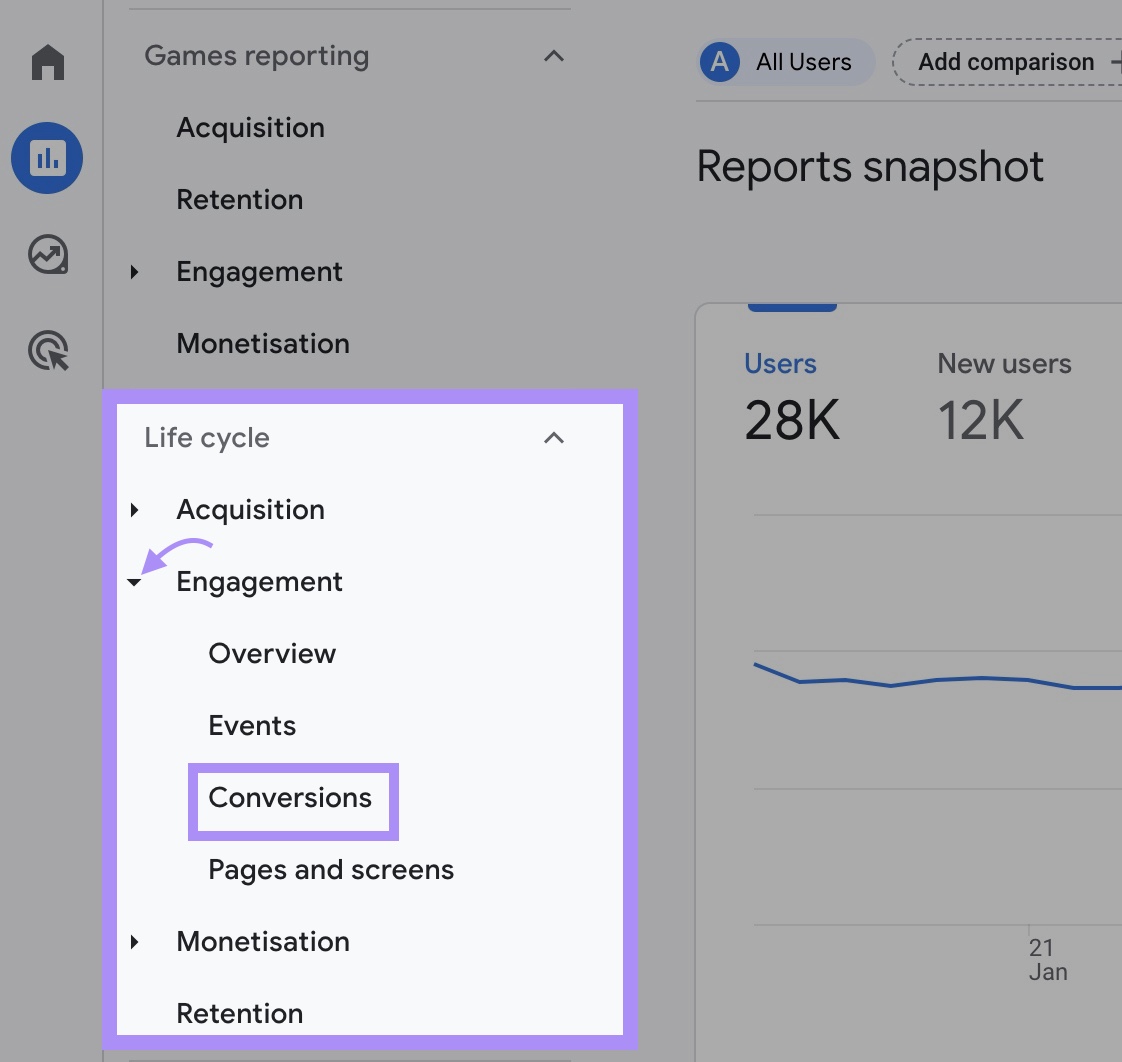
For any given time-frame, you possibly can see these metrics for every conversion occasion:
- Conversions: The variety of instances the conversion occasion has occurred
- Whole customers: The variety of distinctive customers who transformed
- Whole income: The income you’ve earned from the conversion occasion
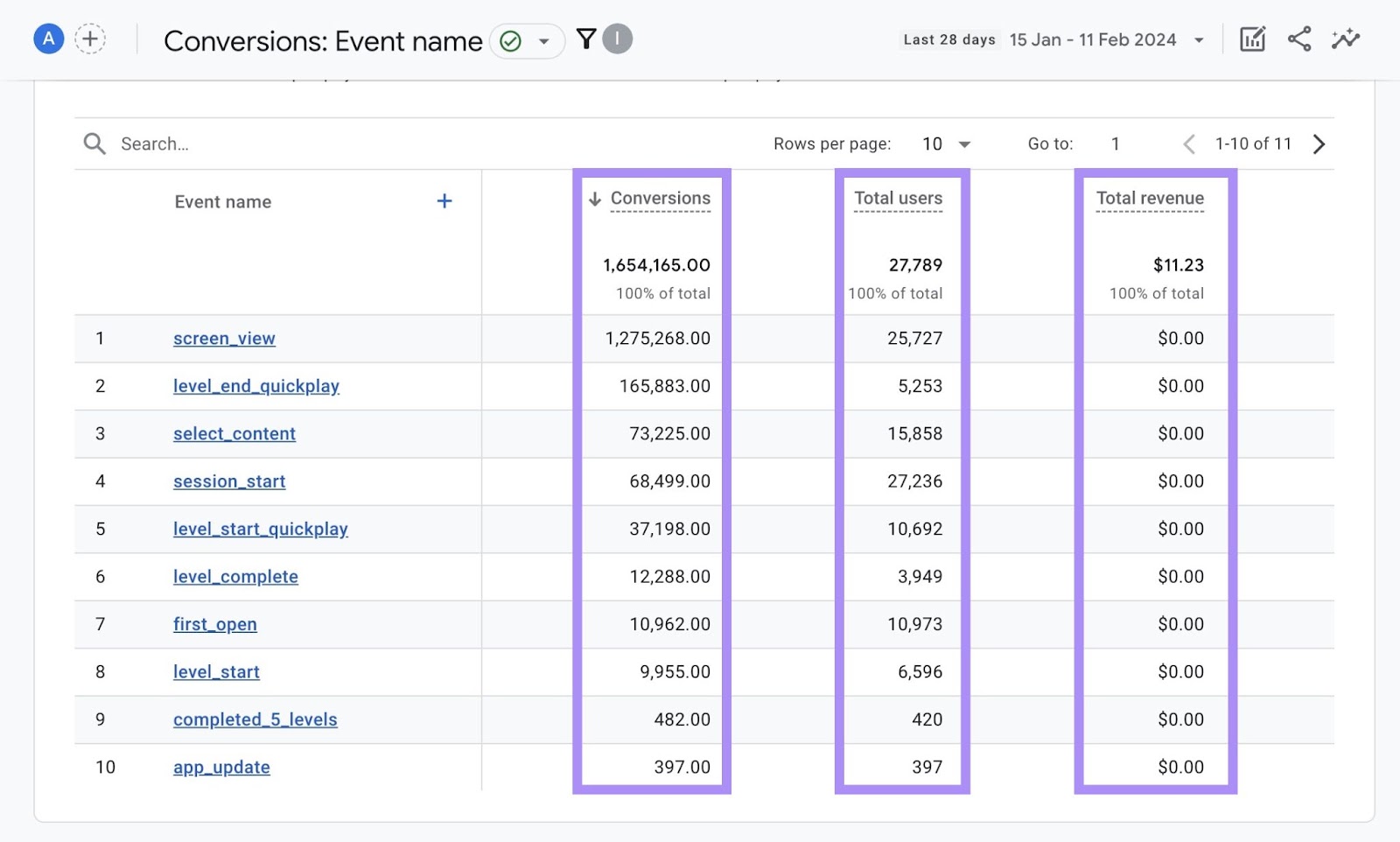
Use the Conversions metric in different GA4 experiences to trace the conversions from varied visitors acquisition sources, pages, and different knowledge attributes.
For instance, on the Pages and screens report, you’ll see the variety of conversion occasions which have occurred for every net web page listed within the report.
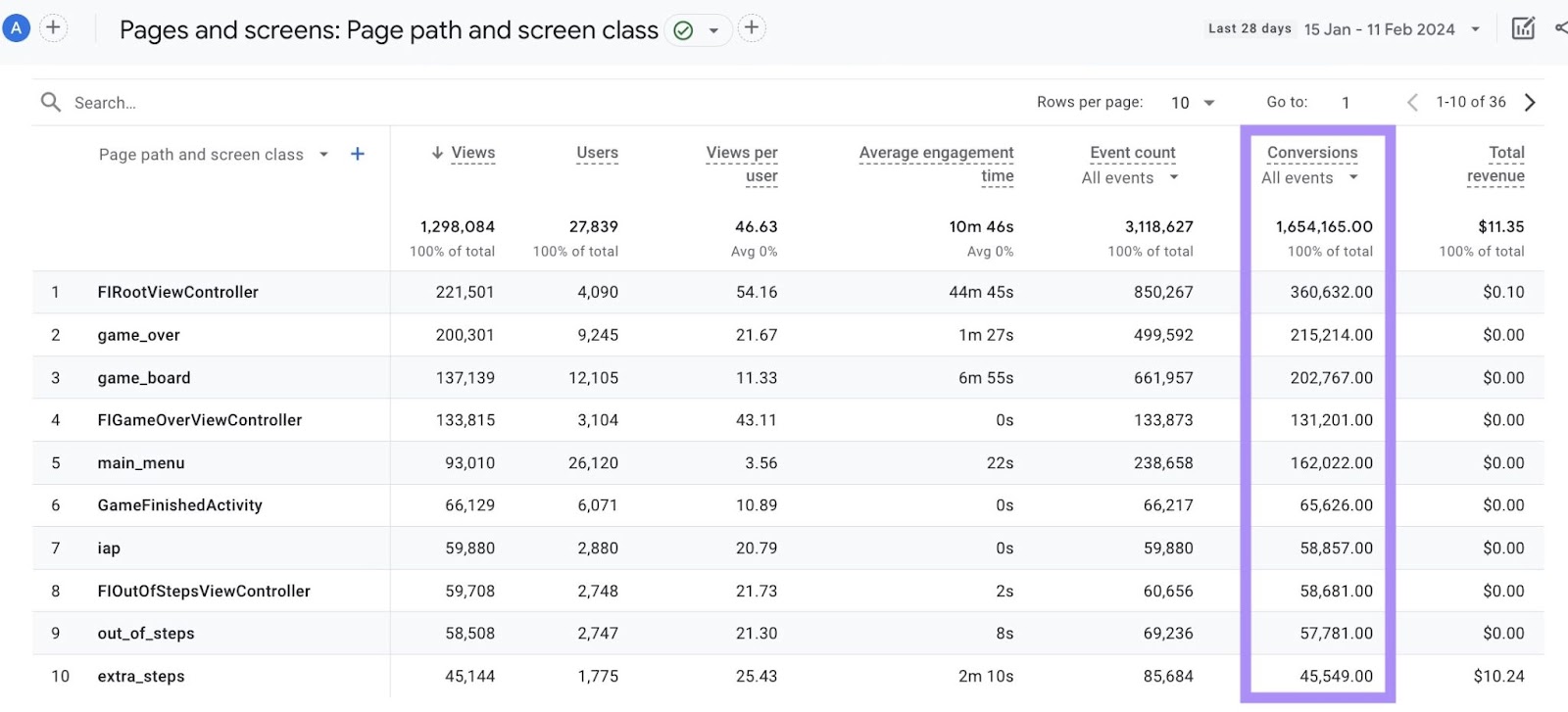
Click on the Conversion metric’s “All occasions” drop-down menu to get simply the variety of conversions for particular conversion occasions.
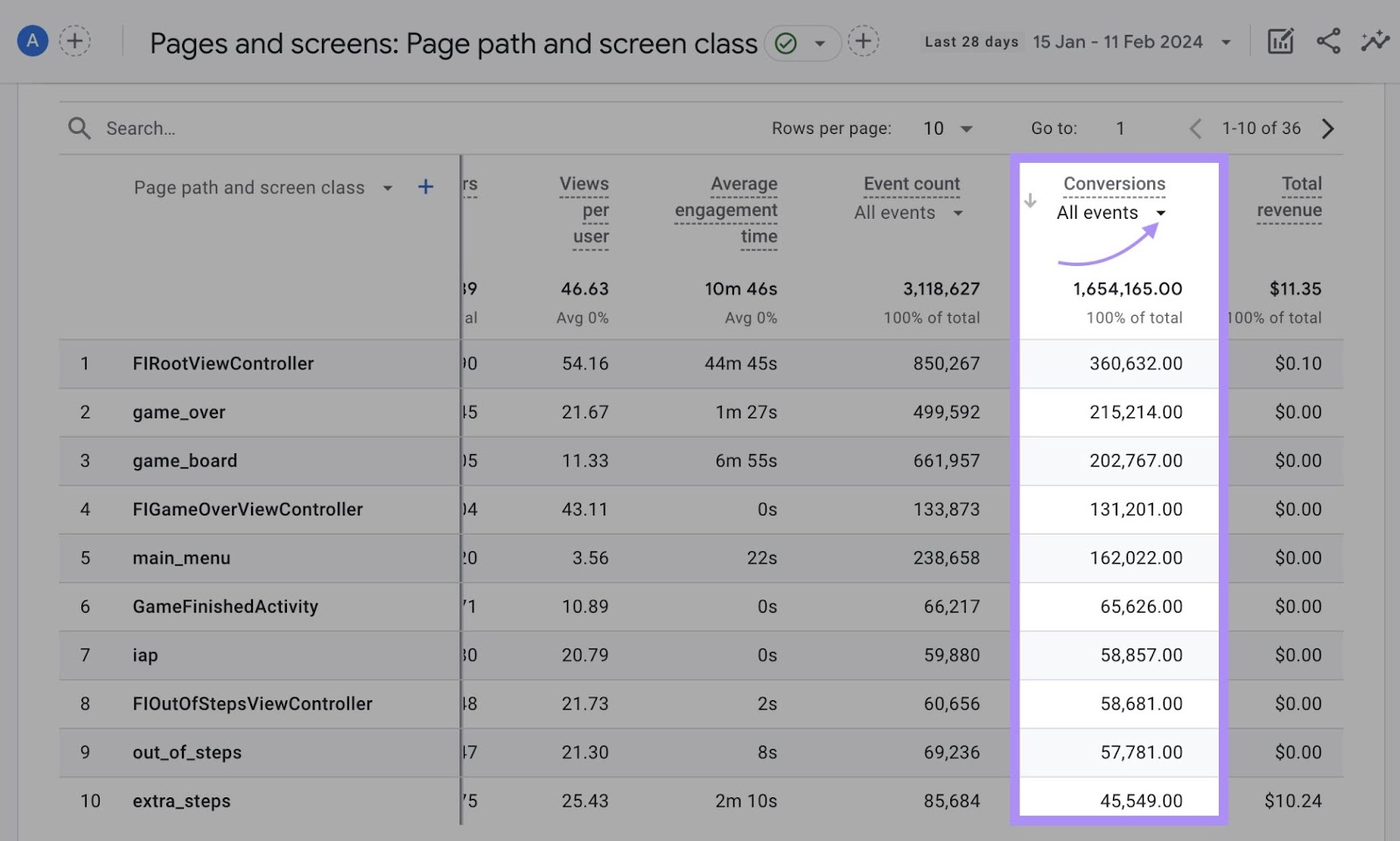
Learn how to Import Information to GA4
You possibly can import the info from different sources, like a customer relationship management (CRM) tool, to GA4. This lets you consolidate your knowledge right into a single platform. And analyze it holistically.
Varieties of knowledge you possibly can import to GA4 are:
- Advert price knowledge
- Merchandise knowledge
- Person ID knowledge
- Shopper ID knowledge
- Offline occasion knowledge
Import your knowledge both:
- Manually by way of a CSV file
- Robotically, on an everyday schedule, by connecting GA4 to a CSV file you’ve uploaded to your Safe File Switch Protocol (SFTP) server
To import knowledge to GA4, click on “Admin” within the platform’s left sidebar.
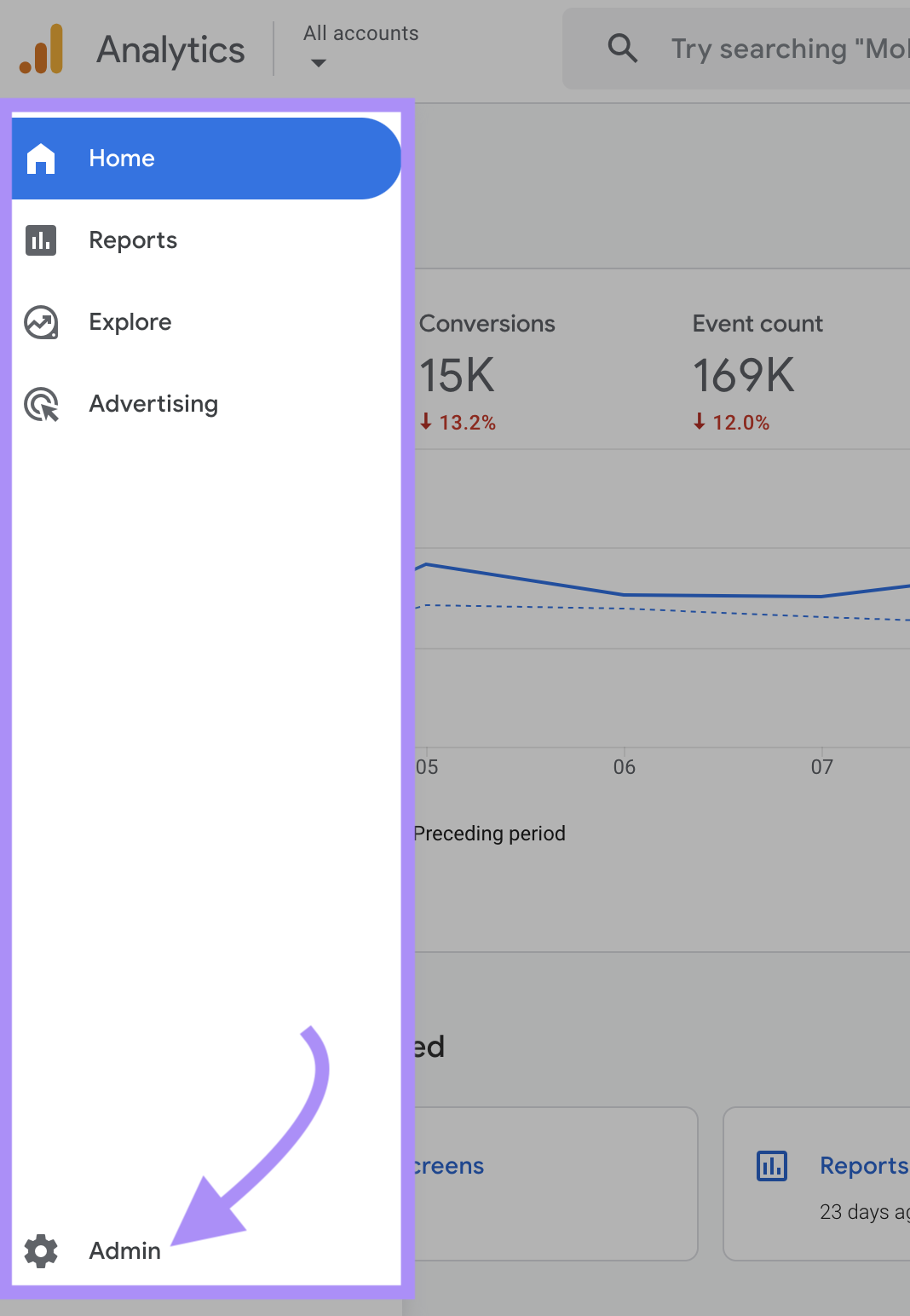
Then, beneath “Property settings,” choose “Information assortment and modification” > “Information import.”
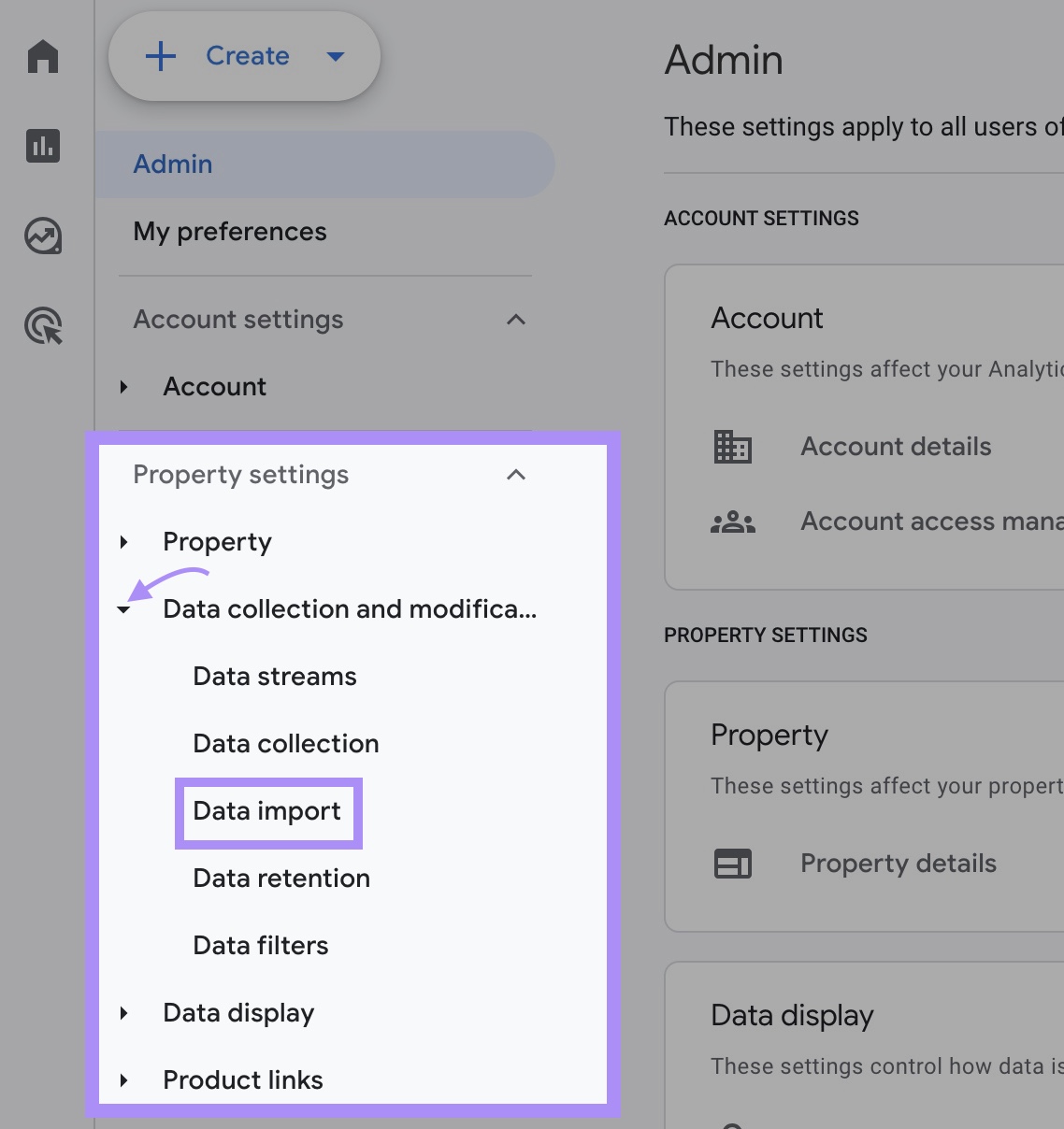
Click on “Create knowledge supply.”

Give your knowledge supply a descriptive title. And choose the suitable knowledge kind you’re importing.
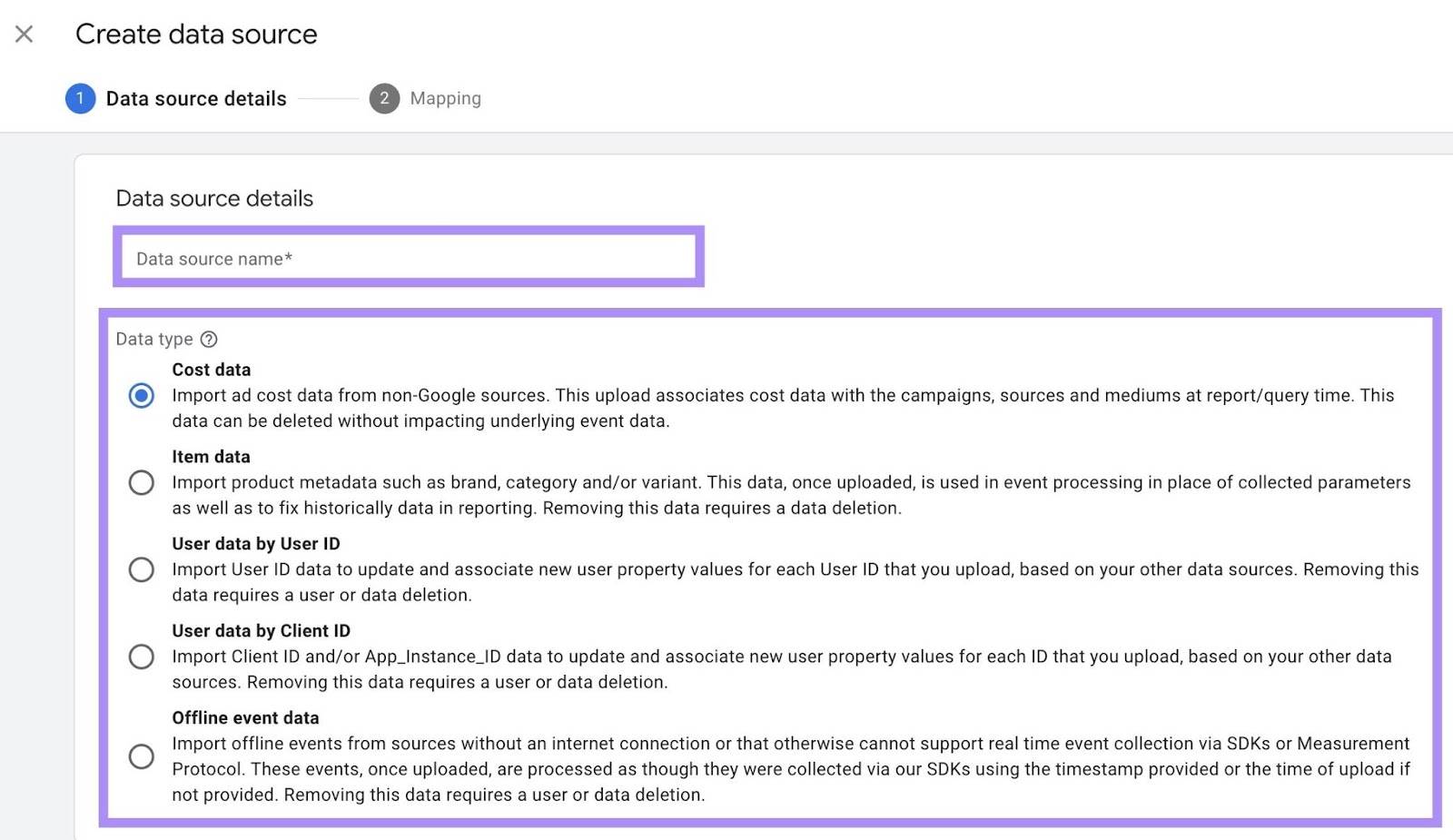
Then, scroll down and choose your import supply.
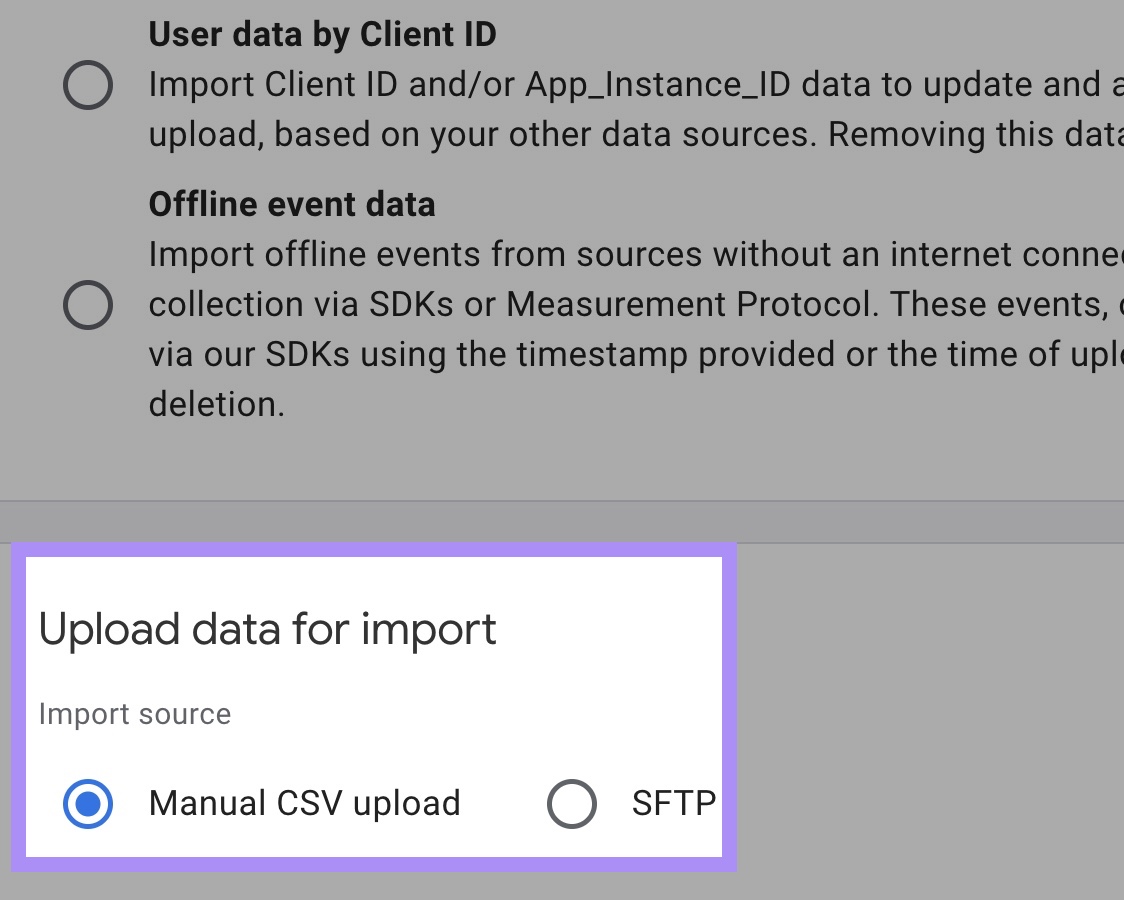
In case your import supply is a CSV file, click on “Add CSV” to add your CSV file.
However for those who’re importing out of your SFTP server, change the import supply to “SFTP.” Fill out your SFTP server username and the URL to your CSV file on the server. And arrange your import schedule.
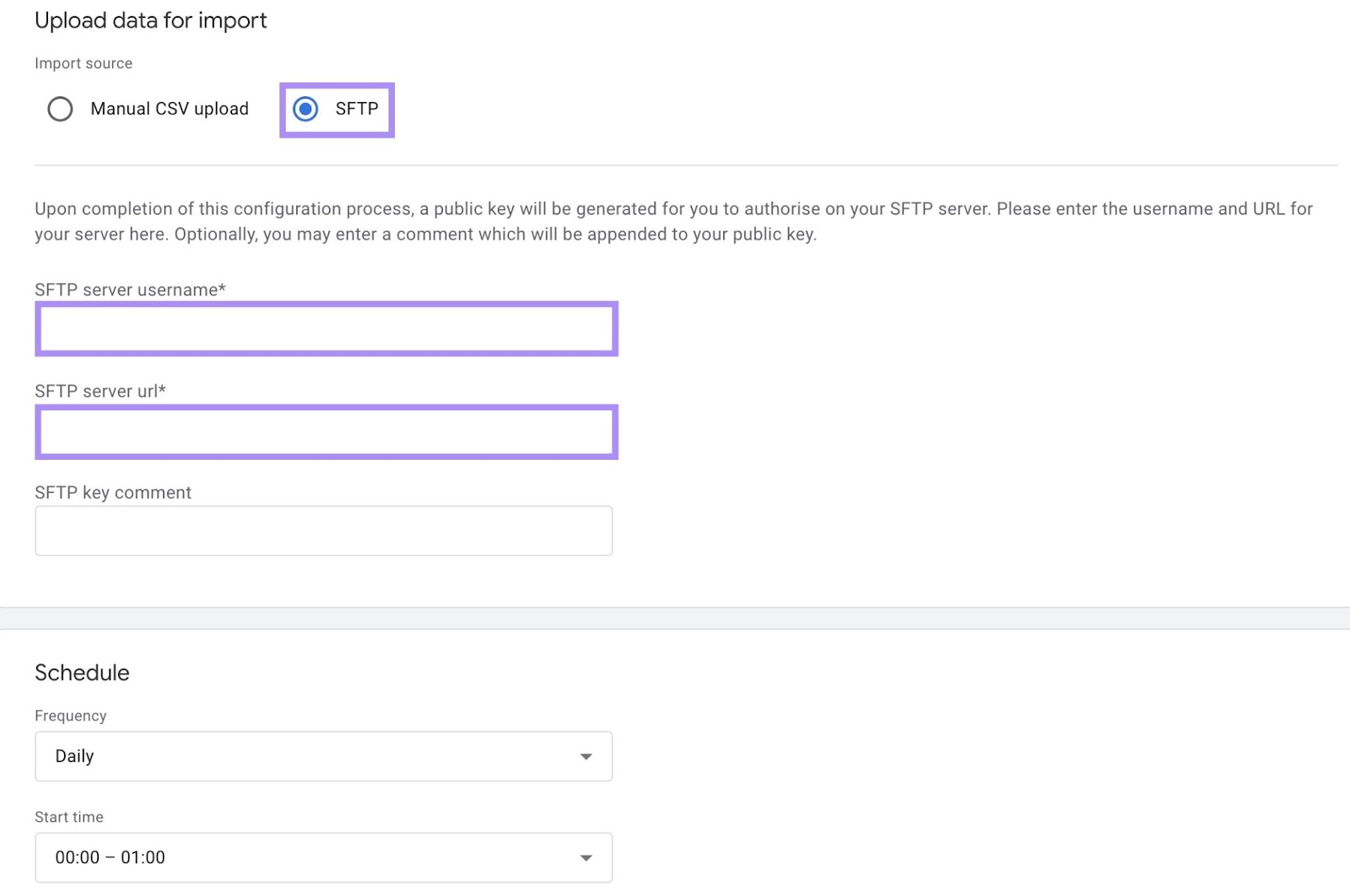
After organising your import supply, click on “Subsequent.”
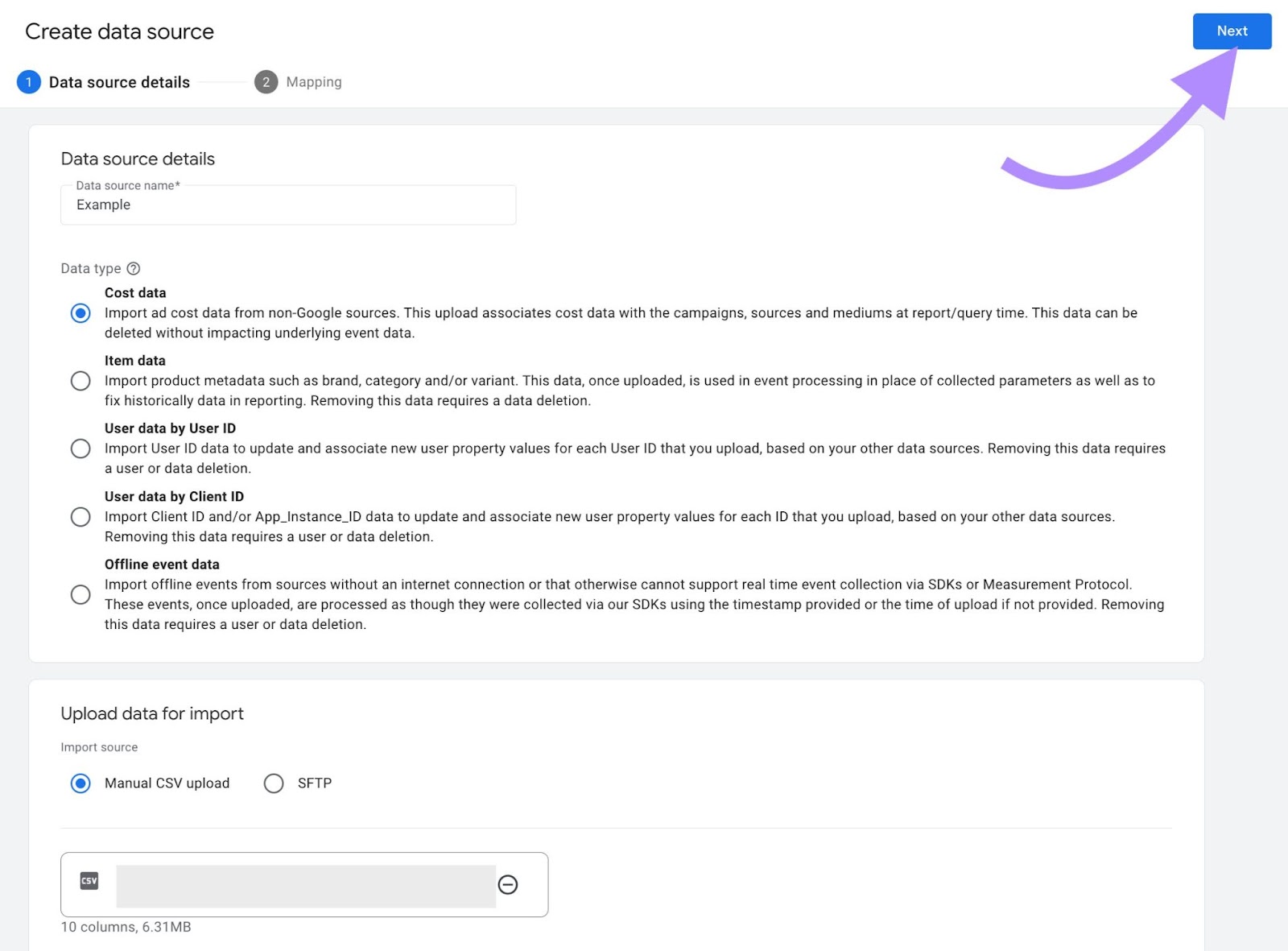
The following step is to map your import supply’s knowledge fields to these in GA4.
For those who’re manually importing a CSV file, use every GA4 subject’s drop-down menu to map it to the suitable subject in your CSV file.
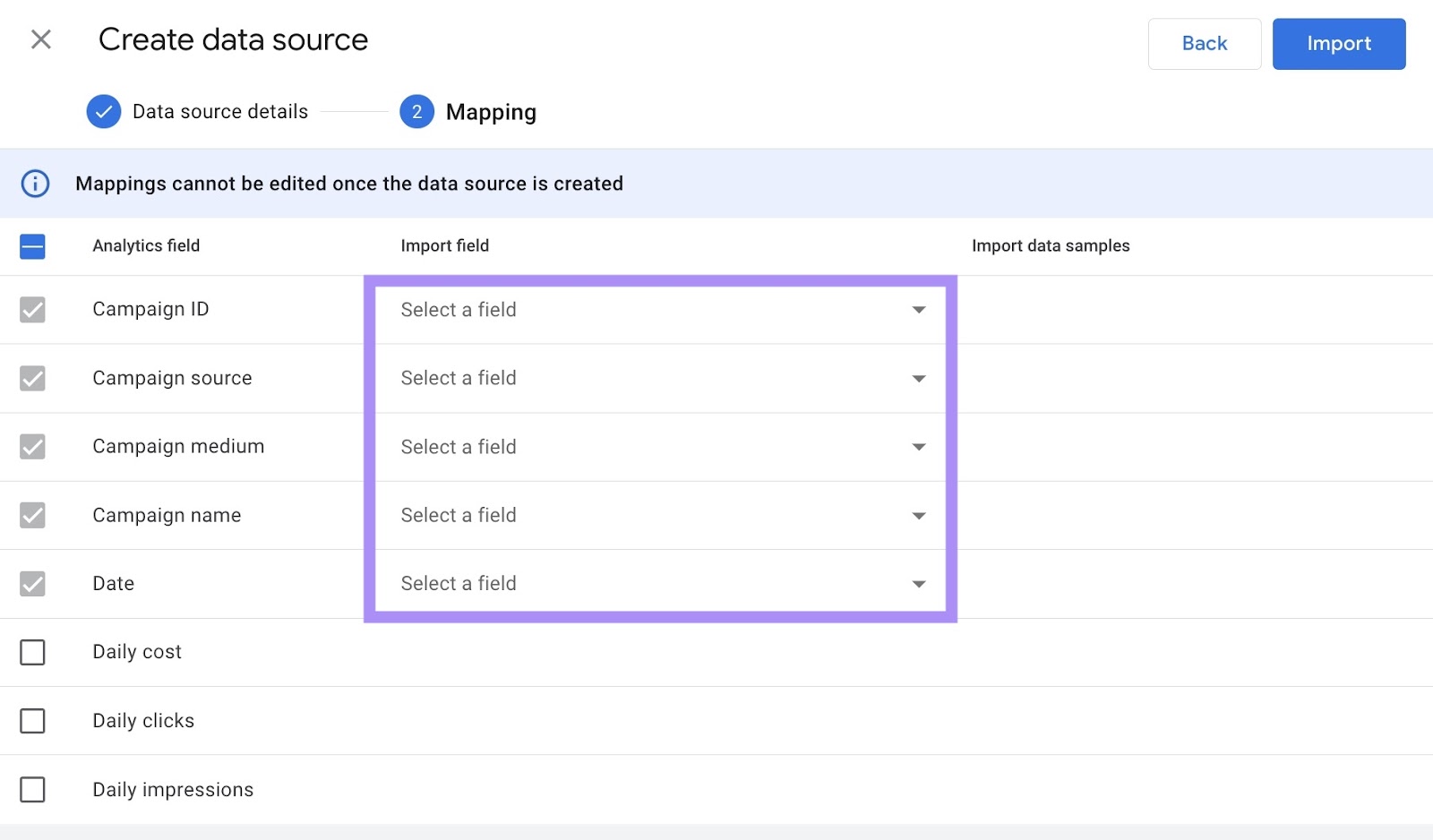
Then, click on “Import.”
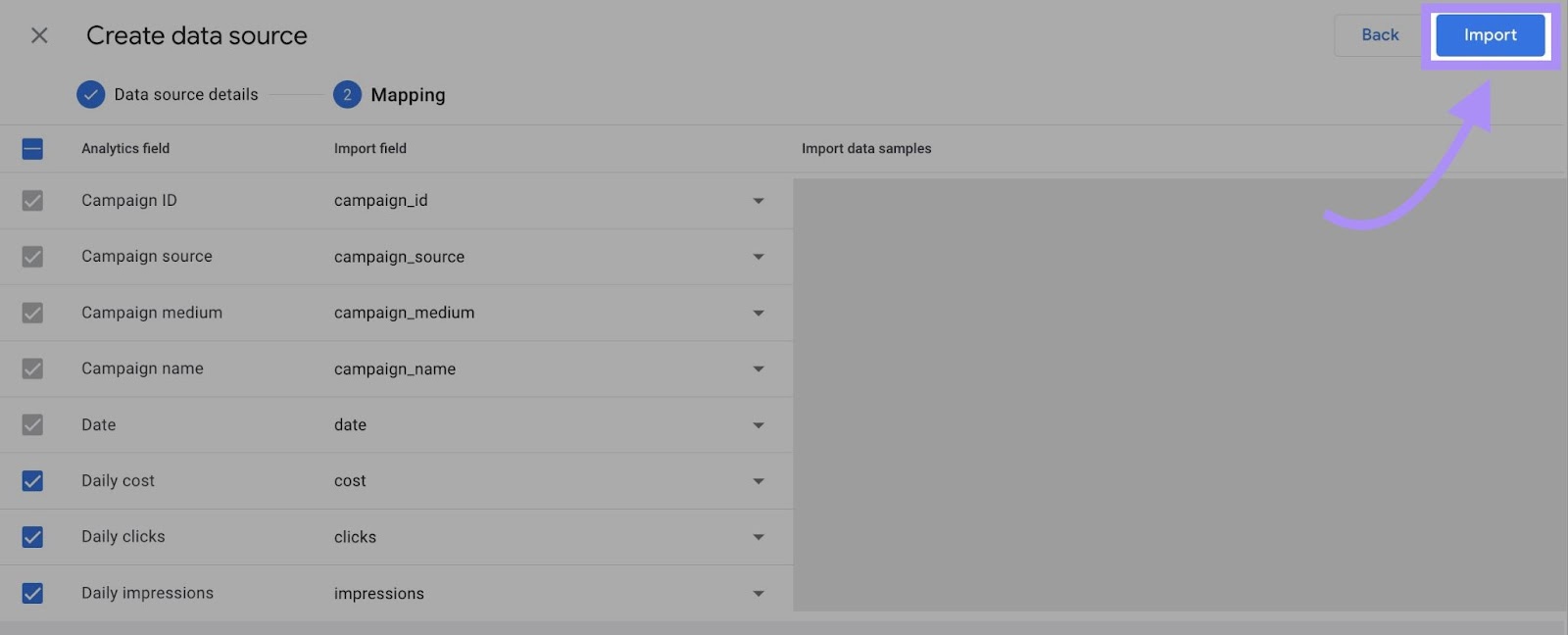
The import will begin instantly.
Alternatively, in case your import supply is your SFTP server, click on the pencil icon. And rename your import fields to match these within the CSV file in your server.
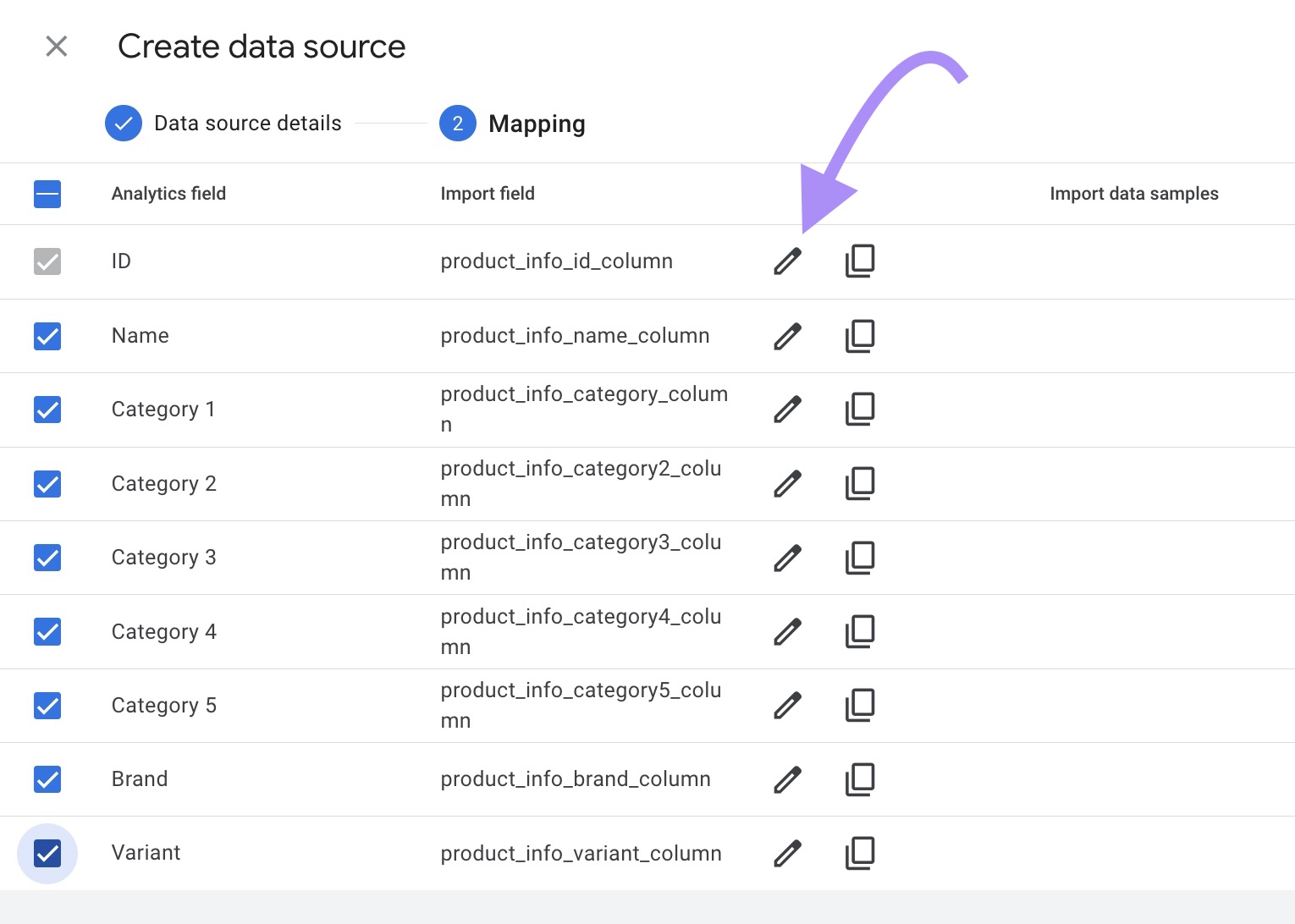
Then, click on “Create & generate key.”
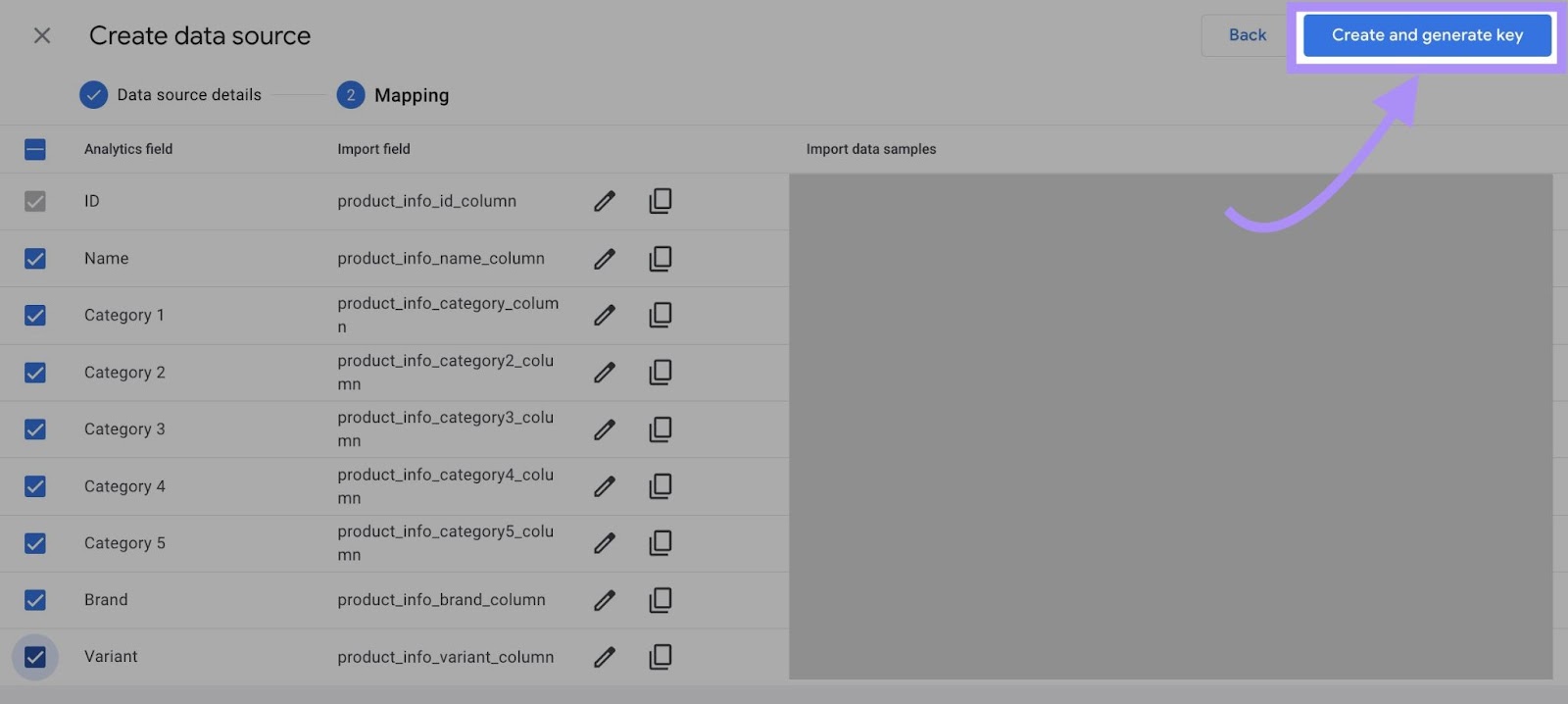
GA4 will generate a public key to authorize its connection to your SFTP server. Copy the general public key and add it to your SFTP server settings.
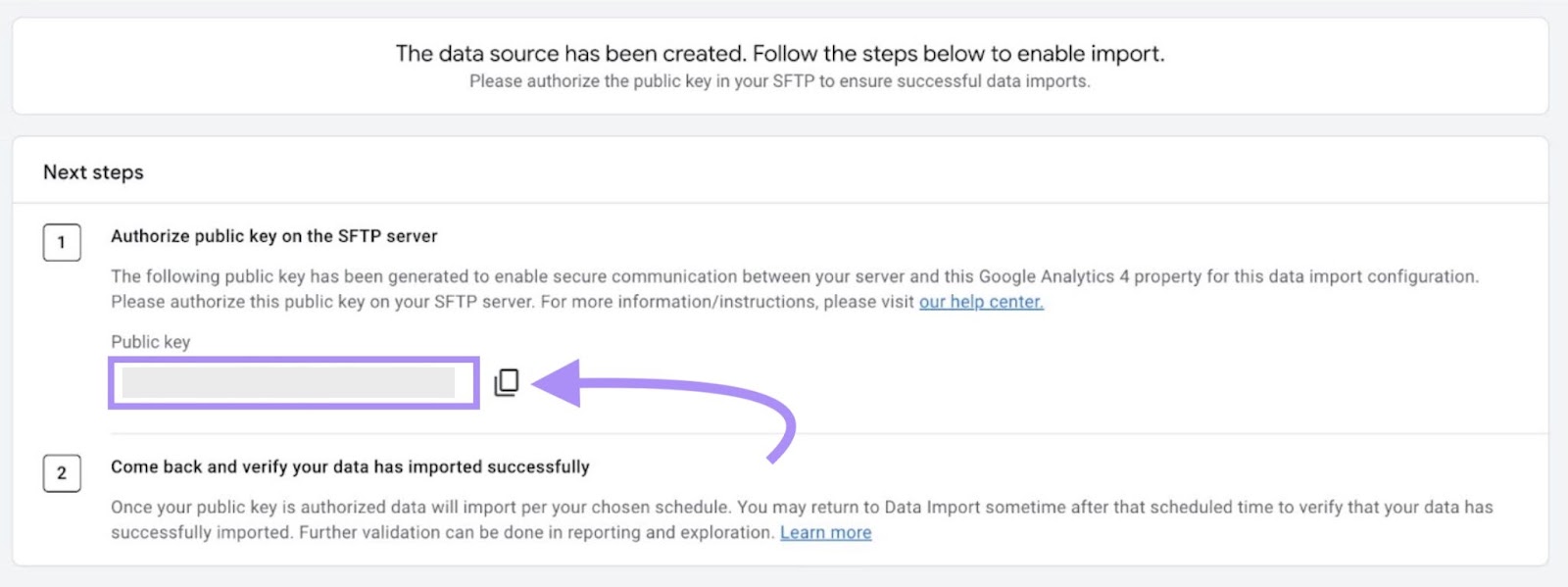
As soon as the authorization is profitable, GA4 will import your knowledge following the schedule you arrange earlier.
Then, use GA4 to research the info you’ve collected from GA4 and different sources.
Varieties of Analyses in GA4
With GA4, you possibly can analyze points like:
- The variety of customers who visited your web site. Modify the date vary to get consumer counts for particular time frames. And determine developments in consumer numbers over time.
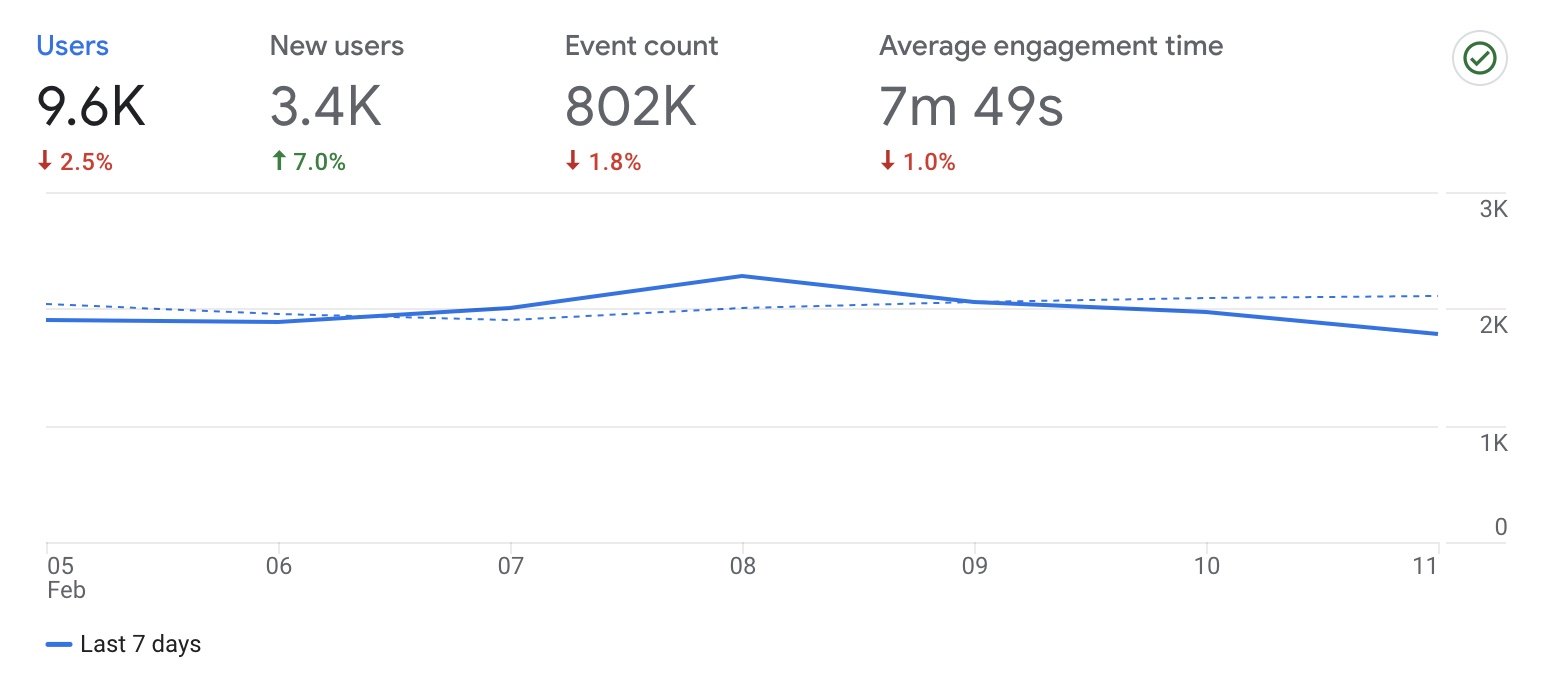
- The demographics of your web site guests. Together with their international locations and cities of origin, languages spoken, gender, and pursuits
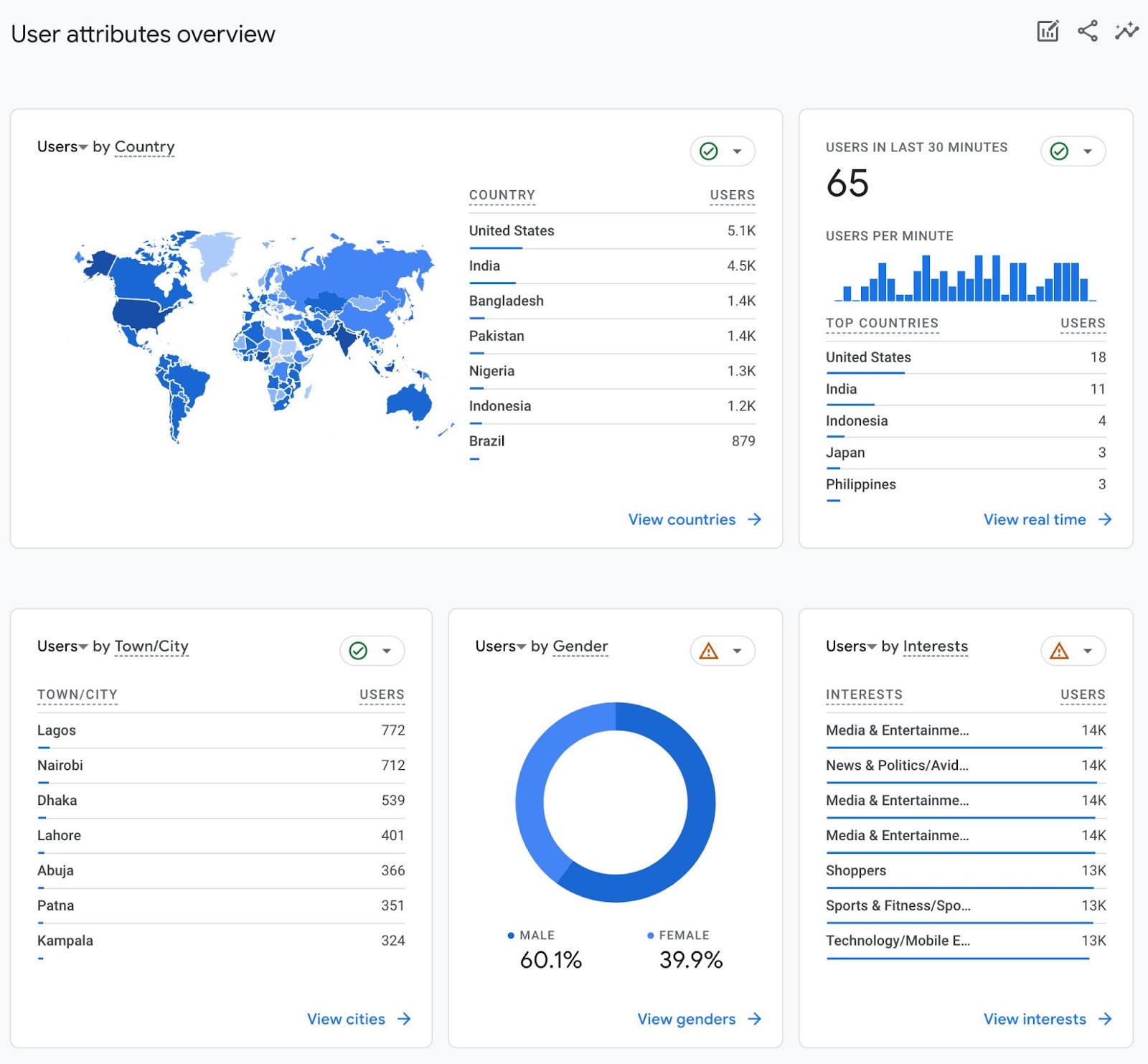
- Your web site’s hottest pages. Plus, their effectiveness at producing conversions
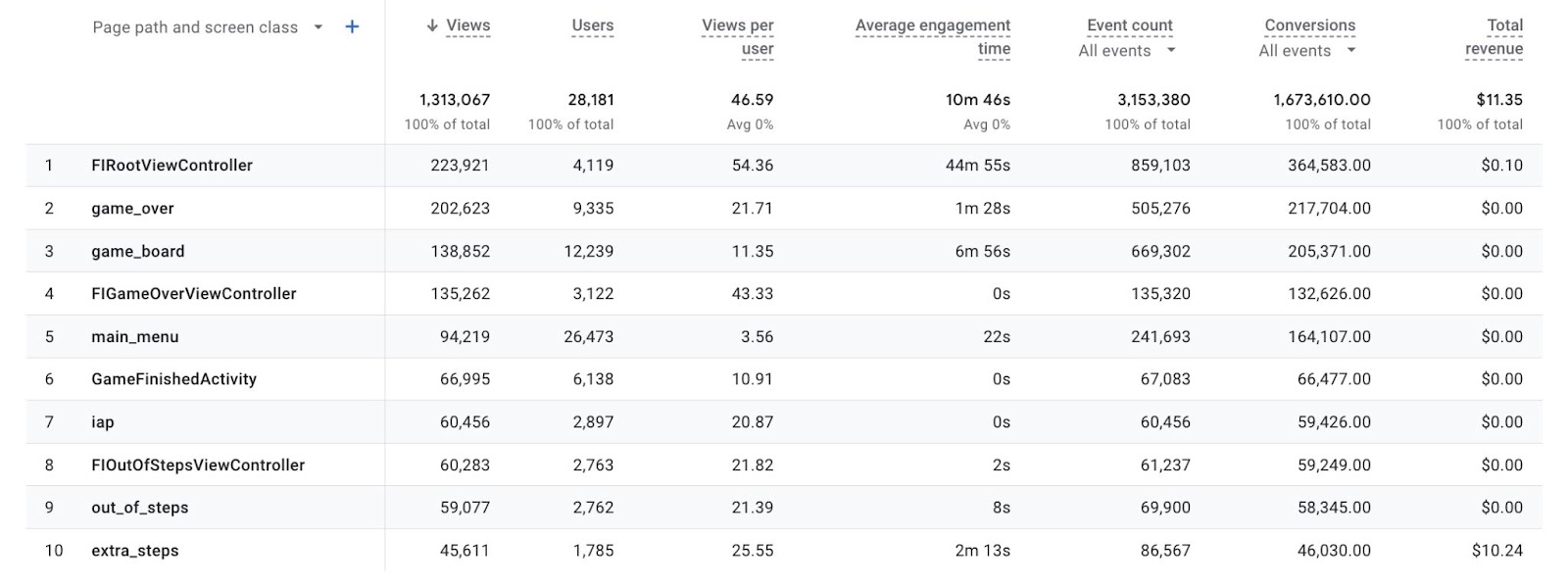
- The events taking place in your web site
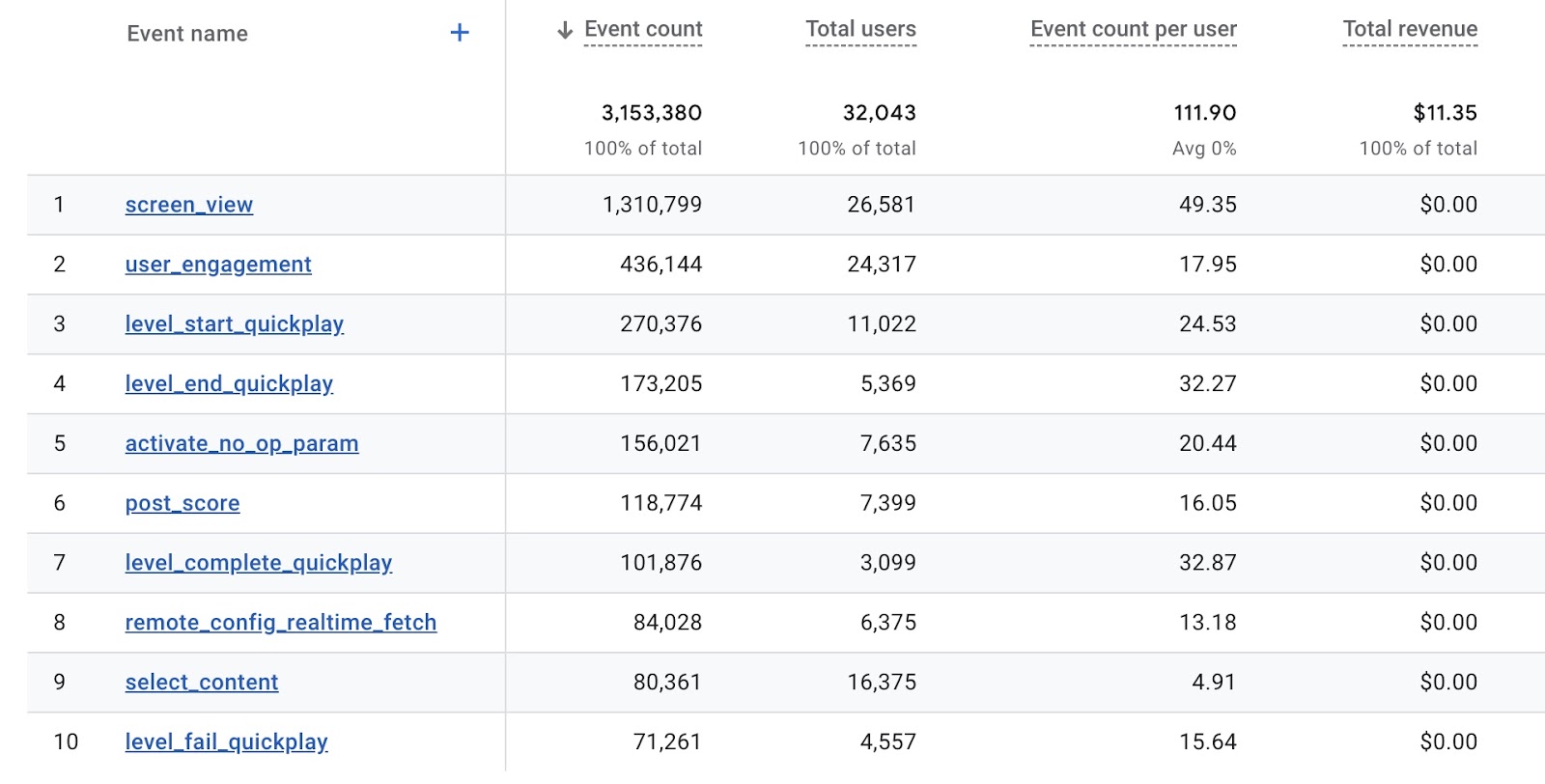
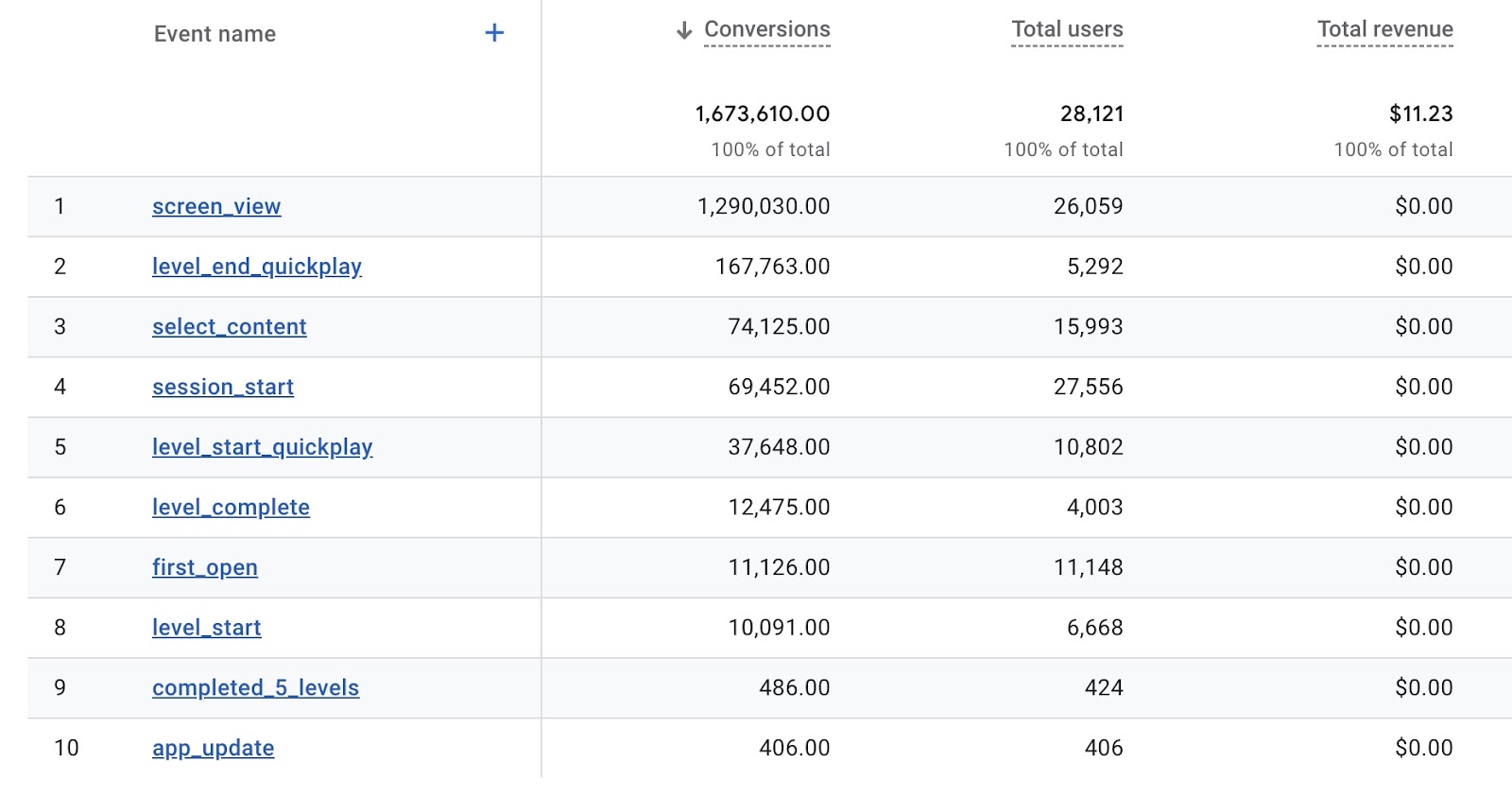
- Your prime sources of web site visitors. Be it visitors from natural search, e-mail, referrals, or direct visits
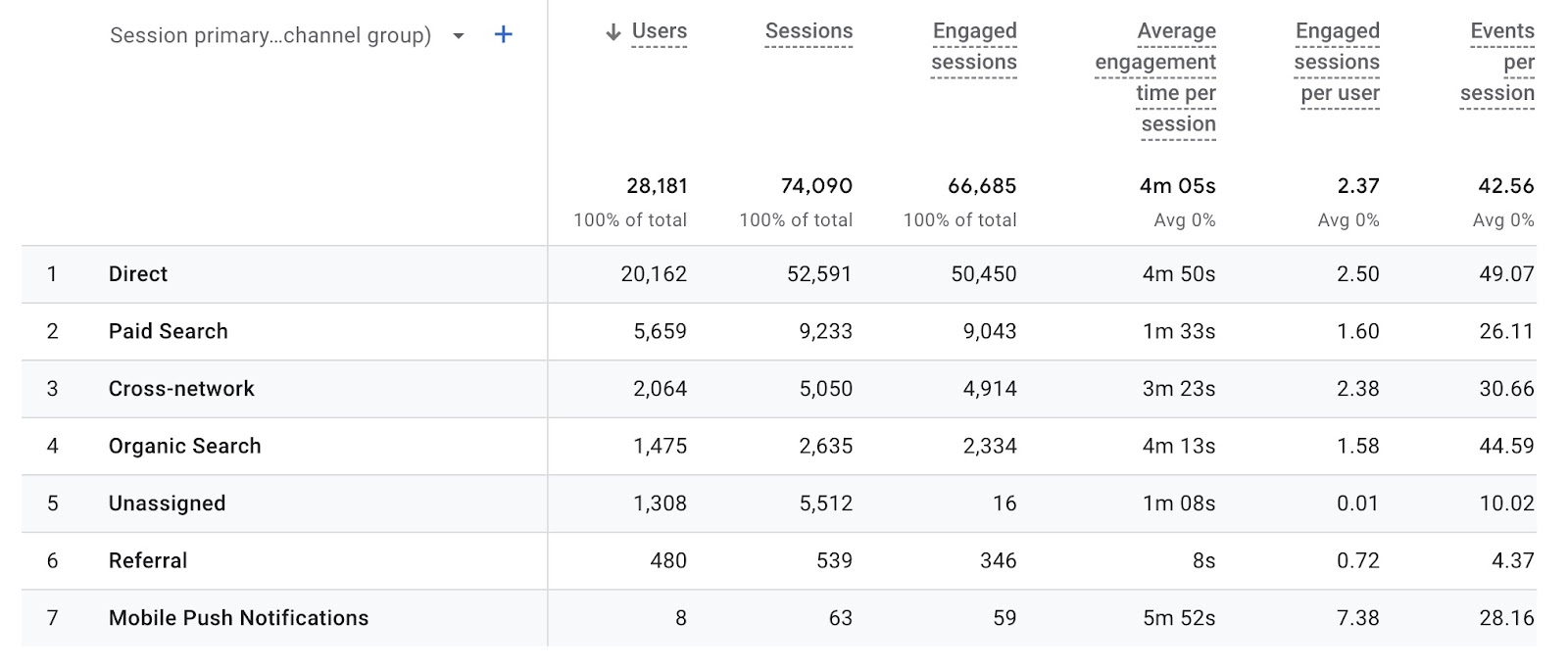
- The gadgets customers use to go to your web site. Not simply whether or not they’re utilizing a desktop or cell system but in addition particular system working programs and browsers
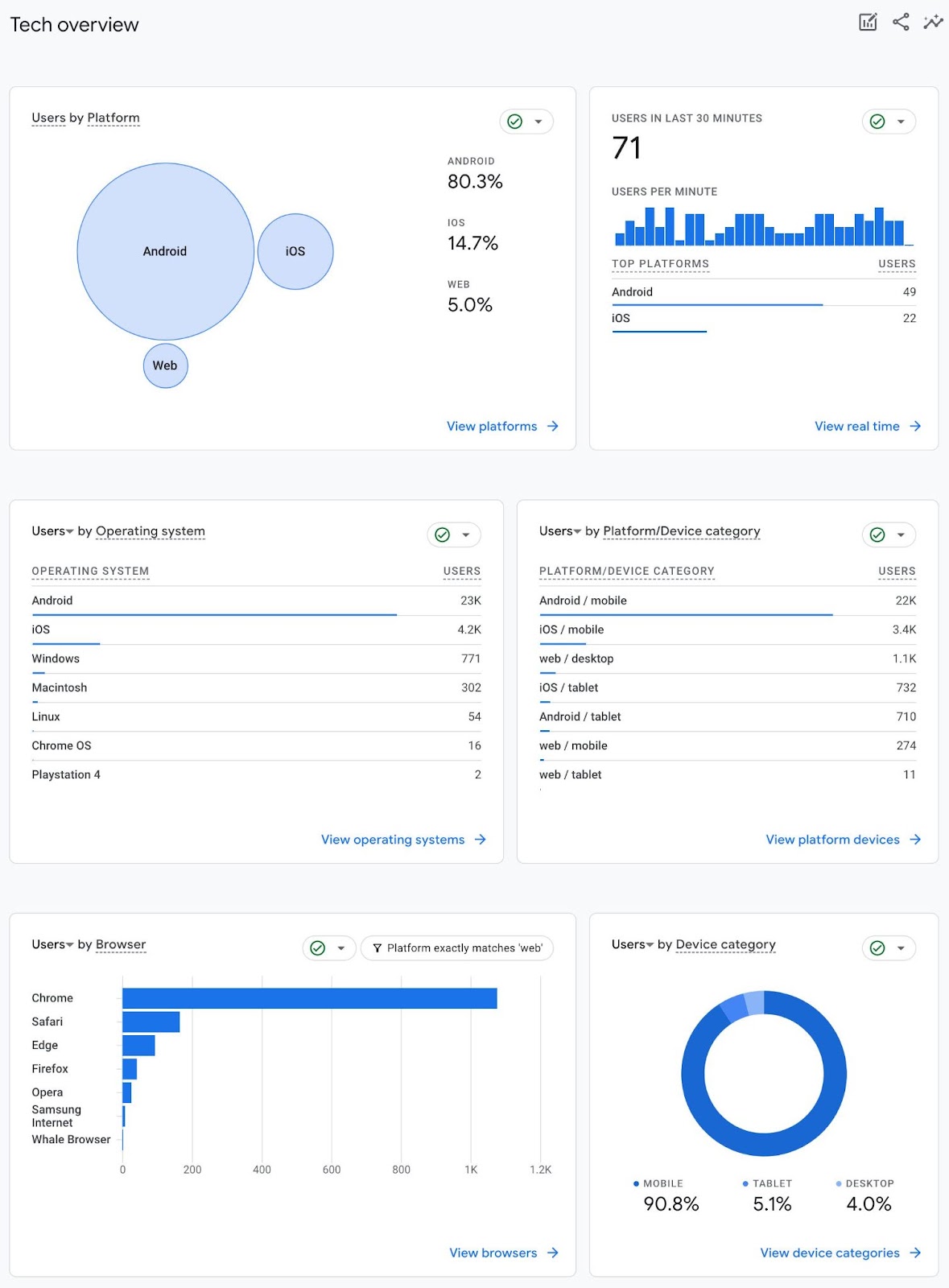
- Your customers’ buy journeys. From the beginning of a session to the viewing of a product, and at last, checkout. And what number of customers are dropping out at every stage of the acquisition funnel.
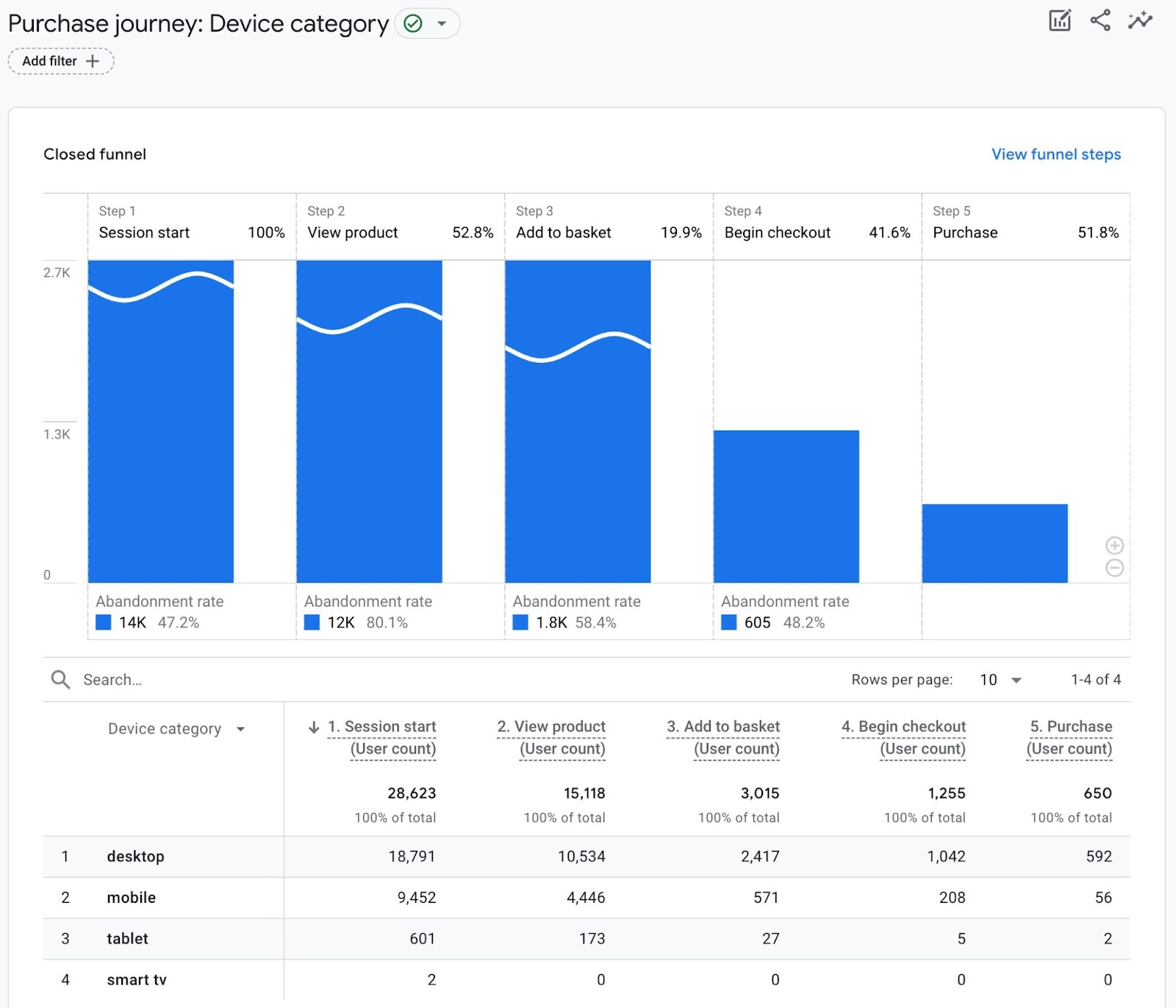
Use these insights to guage your web site’s effectiveness in elevating consciousness of your online business amongst your target market, rising your buyer base, and producing gross sales.
However for those who discover GA4’s experiences difficult to interpret, AI Narratives for GA4 may also help.
This synthetic intelligence instrument makes use of your GA4 knowledge to generate easy-to-understand experiences in your web site’s web page views, conversions, income, and different efficiency metrics. It additionally supplies suggestions for enhancing these.
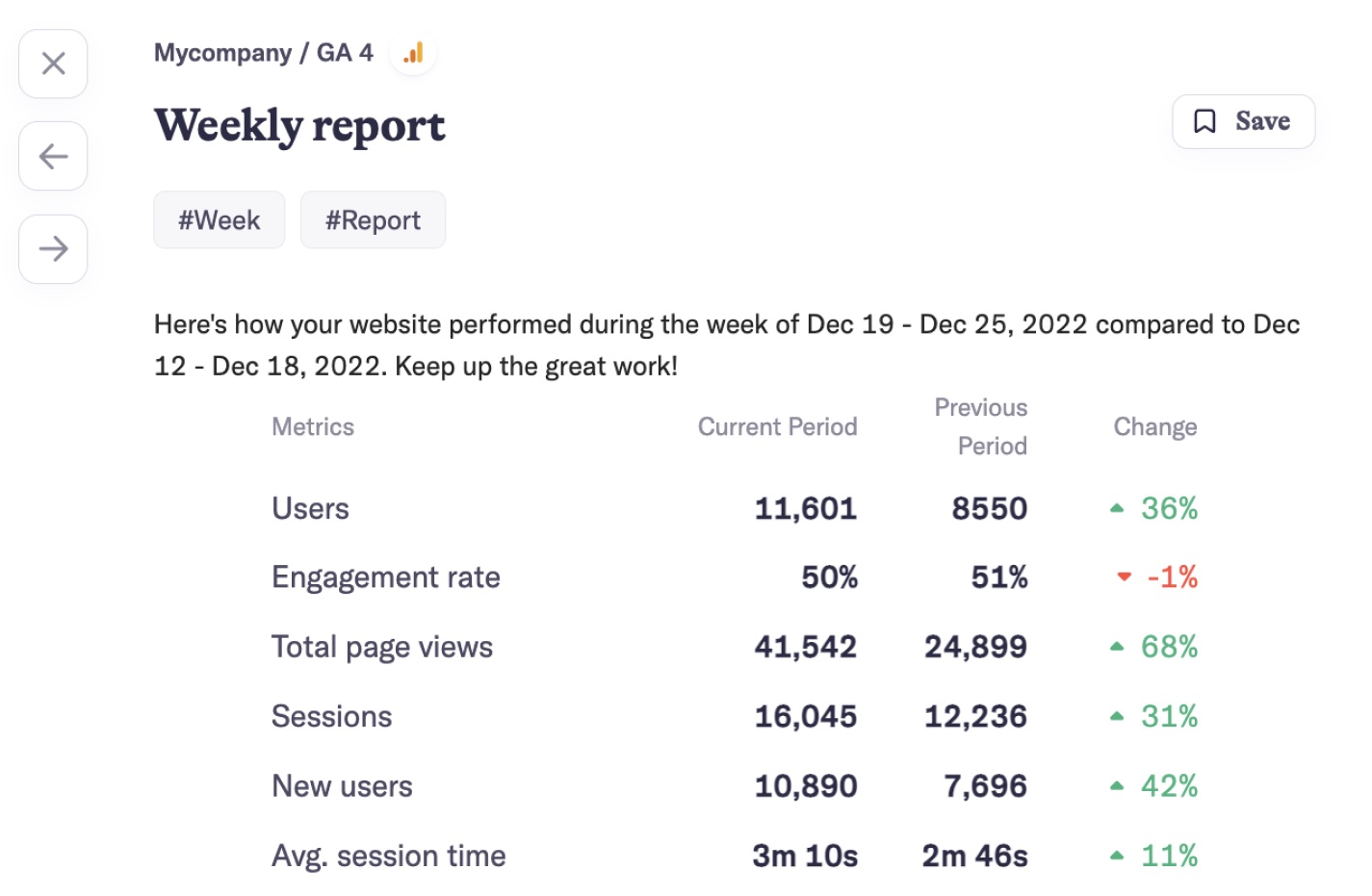
AI Narratives for GA4 can robotically e-mail you its experiences for handy reference. And provide you with a warning when it detects uncommon web site visitors fluctuations.
Join GA4 with different instruments for much more efficiency insights.
For instance, Semrush’s Organic Traffic Insights integrates with GA4 and GSC to indicate the key phrase, consumer, and session knowledge from these instruments and Semrush’s database in your touchdown pages in a single place.
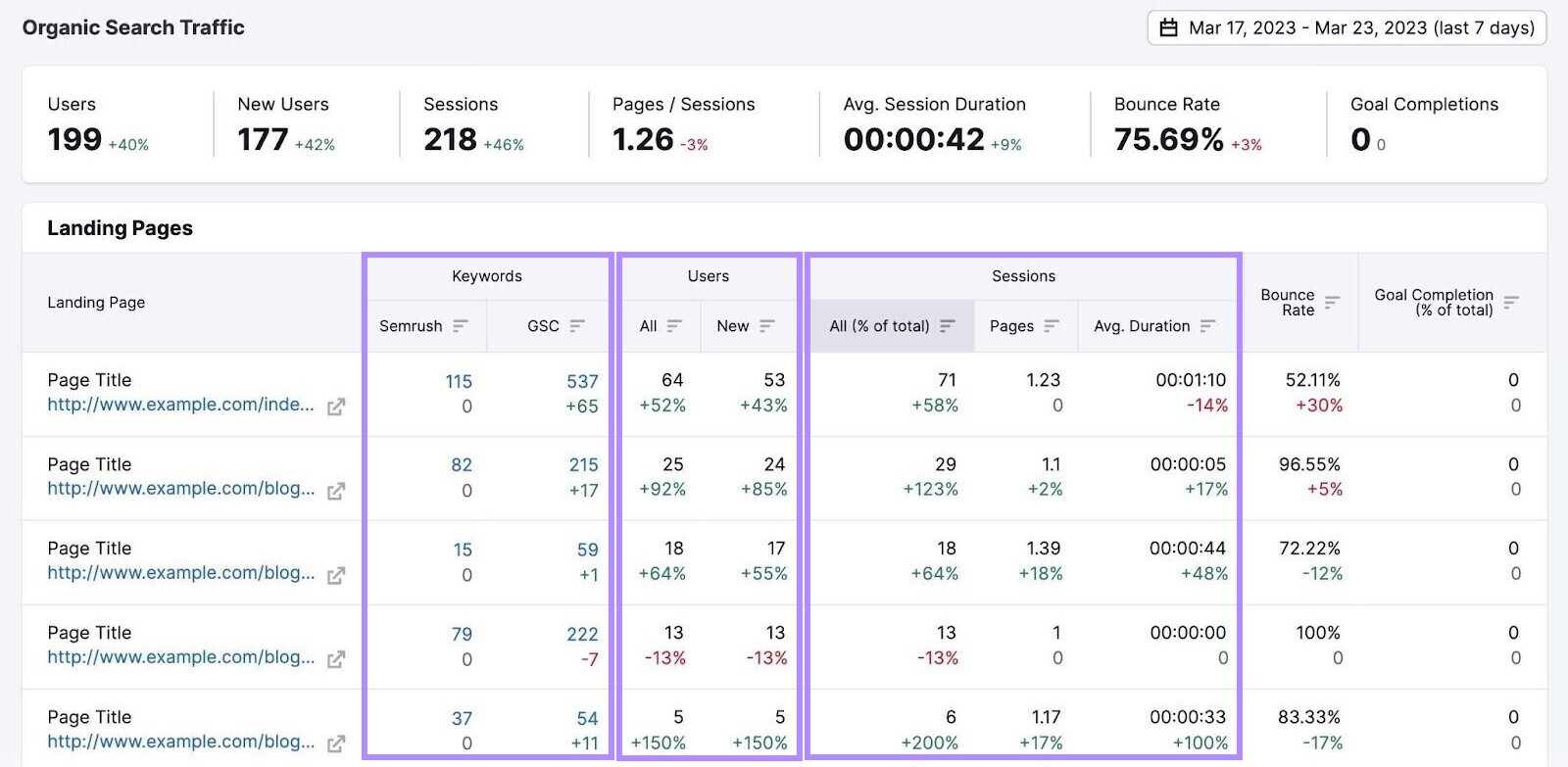
Natural Visitors Insights also can inform you which key phrases are bringing visitors to your pages. Even when GA4 lists these key phrases as “(not offered)” in its experiences.
Then, study your rating positions and share of visitors for these key phrases.
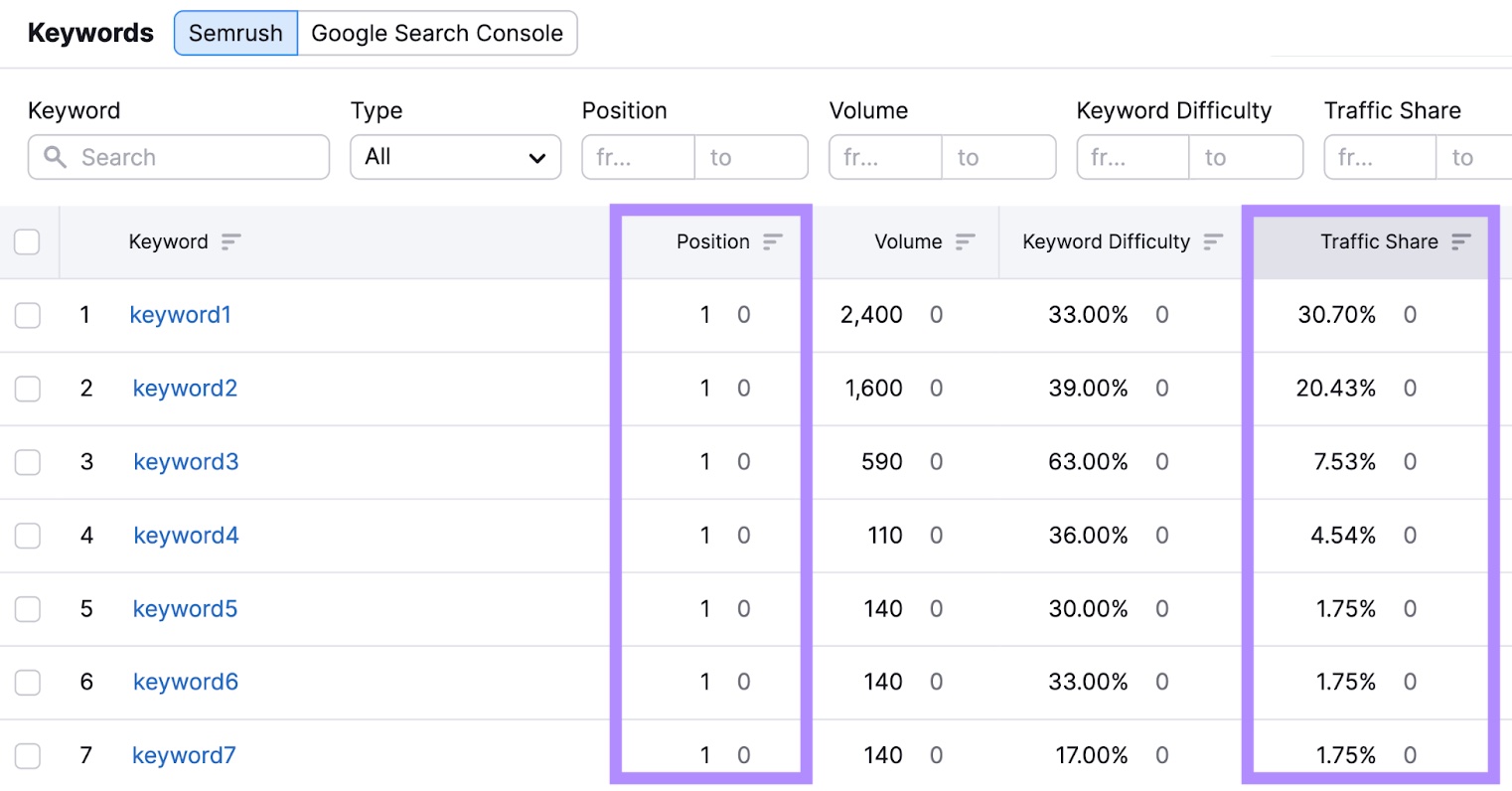
Get Began with GA4
Establishing GA4 takes some preliminary effort, however the wealth of (free) web site efficiency knowledge you’ll unlock within the course of is effectively value it.
To get much more out of GA4, pair it with AI Narratives with GA4 and Organic Traffic Insights.
These instruments can enrich your GA4 experiences with really helpful subsequent steps. And supply a holistic view of your search engine rankings.
Attempt each totally free by signing up for a Semrush account.
FAQs
How Do I Get Entry to GA4?
To get entry to GA4, join a Google account and a Google Analytics account. After that, observe GA4’s onboarding steps to set it up.
For those who’re putting in GA4 on a web site, use GTM or a GA4 integration. Or, manually add a code snippet to your webpages.
What Is the Finest Observe for a GA4 Setup?
Google recommends that customers add no more than three knowledge streams to a GA4 property. That means, one every for a web site, iOS app, and Android app.
In case your model owns a number of web sites or apps, organising a number of GA4 properties could also be acceptable relying in your knowledge measurement aims.
How A lot Does It Value to Arrange GA4?
GA4 is a free instrument, so setting it up will price you nothing. However you’ll incur prices in case your GA4 setup consists of integrations with paid third-party instruments.
For instance, you probably have a Semrush account, you should use the AI Narratives for GA4 instrument totally free for seven days. It prices $39/month after that.




